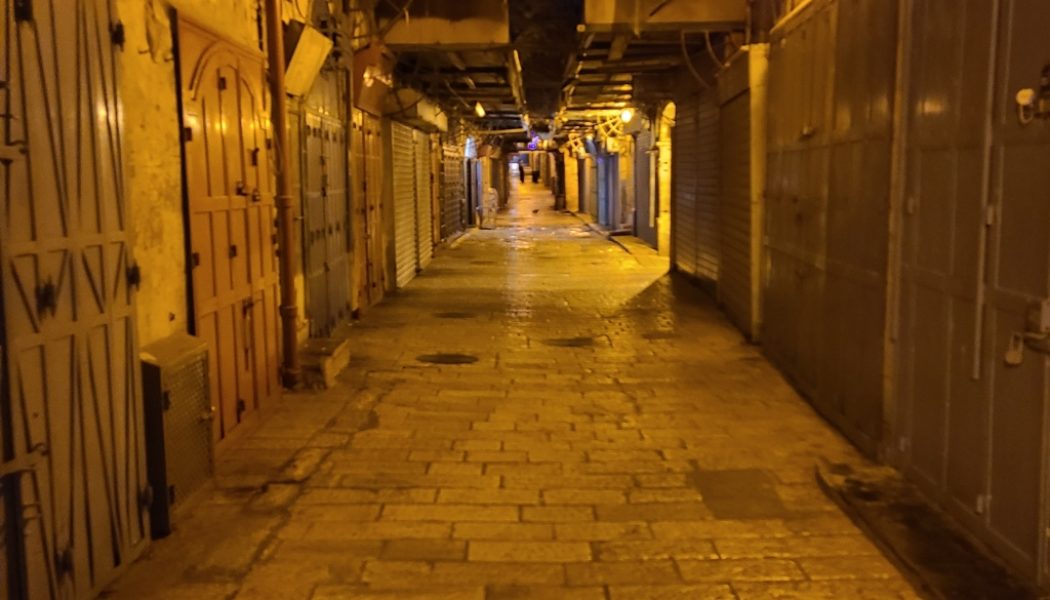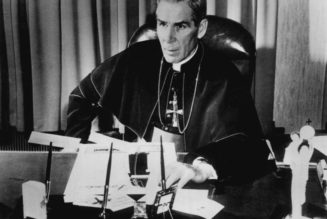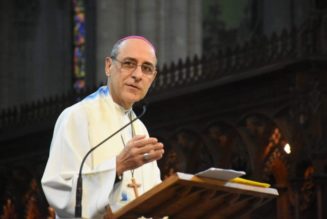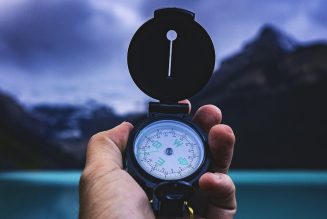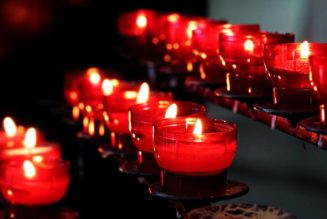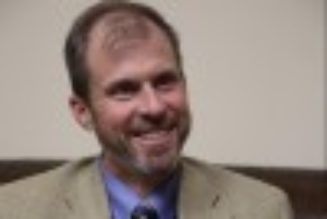Posted on May 21, 2023 by Dan Beaudoin
Note from the Author: Copy/paste GPS Coordinates listed below into Google Maps to see or travel to each location.
I arrived in Jerusalem from Galilee somewhat late in the evening, and it was around 9:30 PM after I parked my car in a nearby parking garage, walked back to my hotel, and settled down in my room. The next day was Sunday, so I needed to find a place in Jerusalem to go to Mass in the morning. I was interested in going to Mass at the Church of the Holy Sepulcher (the ancient church built over both Golgotha and Jesus’s tomb, (GPS Coordinates: 31°46’41.77″N, 35°13’47.16″E)) and began researching Mass times. According to the website I found, the church opened each day at 5 AM and Masses were celebrated frequently at different altars in the church on Sundays. One of the places where Mass was celebrated that caught my eye was *inside* Jesus’s tomb itself! This Mass began at 6 AM and the website said “space is limited.” Although I was tired and 6 AM Mass was earlier than I had anticipated going to Mass, I said to myself…”YOLO!” Having the chance to receive Jesus in the Eucharist at *the* holiest place on Earth is not something you pass up this side of heaven. So, I set my alarm for 4:15 AM so I could get there extra early and fell fast asleep.
I woke up at 4:15AM and began getting ready for my day. I was excited to go to the Church of the Holy Sepulcher. I had visited this church on my last two pilgrimages to the Holy Land, and it is always such an incredible blessing to be able to visit this ancient and holiest of churches. I packed my backpack for the day and left my hotel at around 4:45 AM. The website I had referred to the night before had the opening time of the church down for 5 AM and it was a 13-minute walk, so I decided I would run to the church to try to get there to see it being opened. It was obviously still dark outside, but everything was very well-lit. Additionally, it so happened that the night before was Israeli New Year’s so there were still many people (even youngsters) walking around outside the walls of Old City Jerusalem.
It was a surreal feeling running early on a Sunday morning to Jesus’s tomb—just like St. Peter and St. John did 2,000 years ago. Although this was under very different circumstances than that time, I could feel some of the same anticipation and excitement as I ran to Christ’s (still) empty tomb! I entered Jerusalem’s Old City through its western gate (Jaffa Gate) and jogged through the quiet streets. It was quite a contrast to the busyness of Jerusalem during the daytime with hundreds of people walking through the city, and restaurants and shops open and tending to their customers. Now, everything was completely closed—large iron doors tidily kept each business closed up and secure. The paving stones of the Old City’s roads have been polished smooth because of all the foot traffic over the decades. Some of the oldest paving stones even date to the time of King Herod the Great. The only other people walking the roads that I could see were two-person walking police patrols strolling and talking.
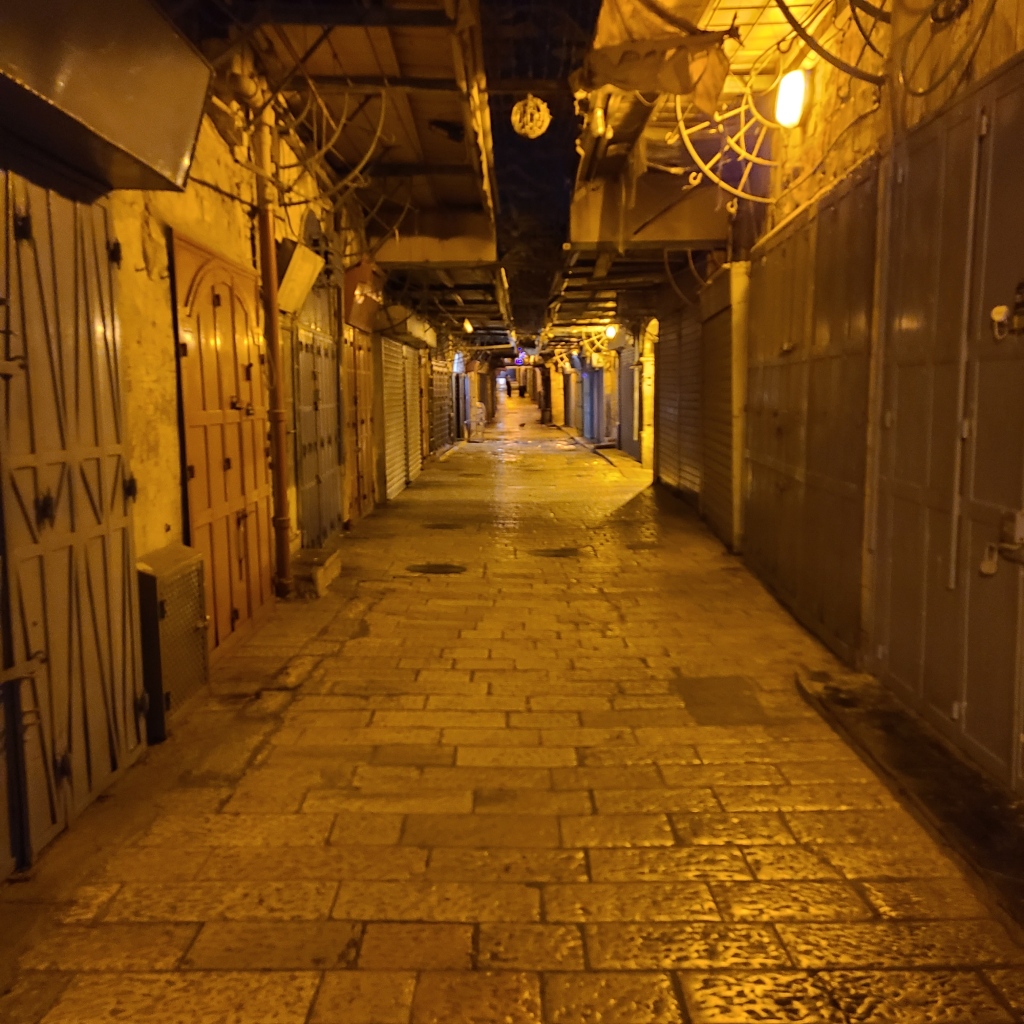
I followed Google Maps till I reached the large plaza outside the entrance to the Church of the Holy Sepulcher. I expected the church to be closed, but as I was approaching the entrance, a great crowd of tourists were already *leaving* the building—I’m assuming after having been there for a while! The church must have opened at 4 AM instead of 5 AM. Although I wasn’t able to see the church being opened, I was luckily still very early for Mass inside Jesus’s Tomb at 6 AM.
I went inside the timeless church. Stepping into that church is always such a staggering feeling and a blessing. To think of the billions of Christians throughout history who have not had the privilege to visit this place–to include many Saints thru the history of the Church–and yet, you have been blessed with the opportunity is very humbling. To think of the thousands of people throughout history who died traveling to Jerusalem for the chance to cross the threshold of the holiest building in the world and see for themselves that Christ’s tomb is empty, is very sobering. I’m always so grateful for every opportunity I have to visit, pray, and worship Christ there.
Immediately inside the entrance of the Church of the Holy Sepulcher to the right is a staircase that takes pilgrims to the top of Golgotha and the Chapel of the Crucifixion whose altar is above the spot where Jesus’s cross stood. Contrary to depictions of Golgotha in art and film, the “mount” of Golgotha in Jesus’s time was not a large or very high mountain, but a hillock 20 to 30 feet high. Golgotha is also only about 100 meters from Jesus’s tomb.
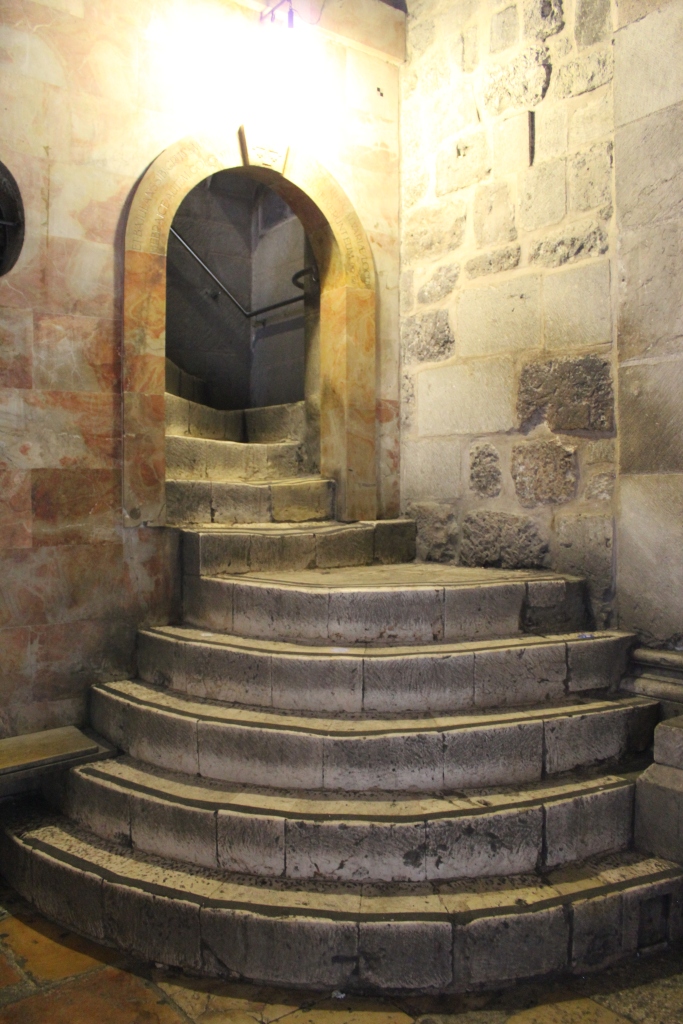
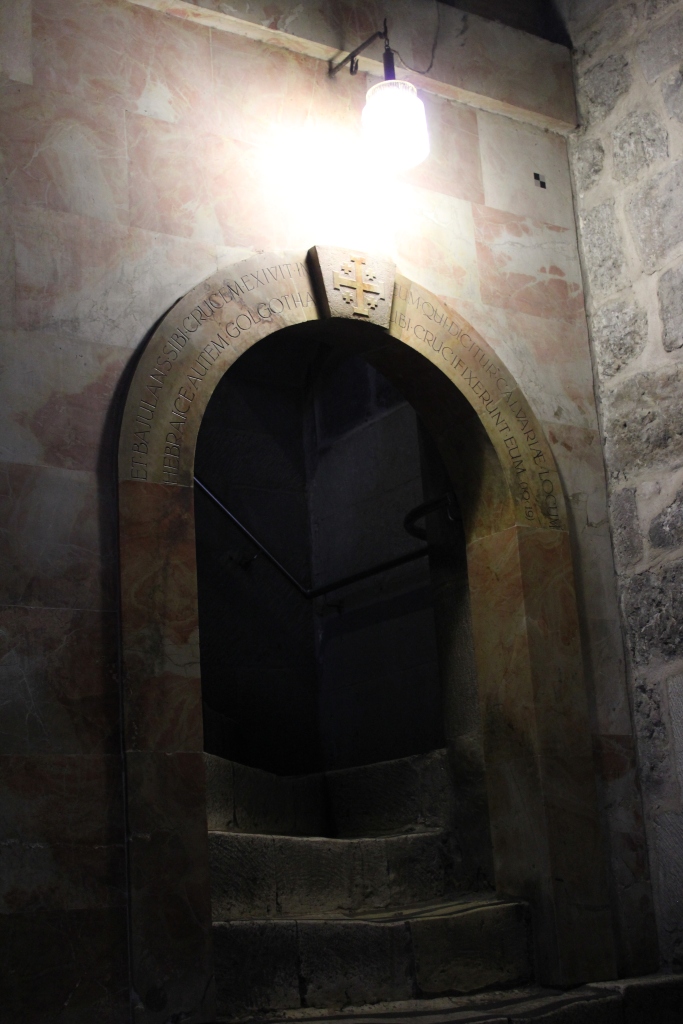
I climbed the stairs to the top of Golgotha, and thankfully, it was deserted—a stark contrast to how it must have been during our Lord’s crucifixion—and it gave me the opportunity for a few moments of silent prayer by myself at one of the holiest places on earth. Of the billions of Christians in the world—I, Dan Beaudoin—was the one person standing at the place of our Lord’s death…surreal.
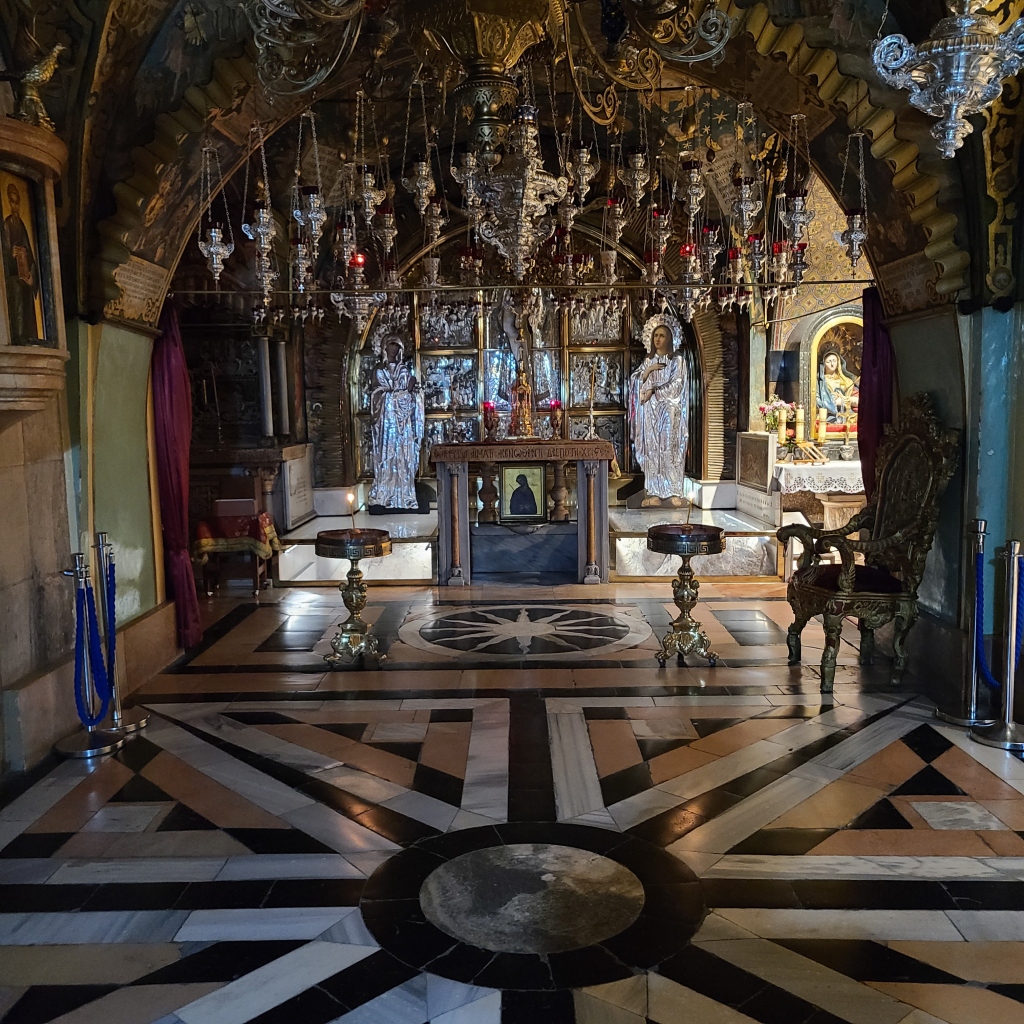
After praying at Golgotha, I went down the stairs and into a small chapel underneath the Chapel of the Crucifixion called the Chapel of Adam (see photo, facing east). The Chapel of Adam received its name due to an ancient tradition that the first man, Adam’s, skull had been buried under Golgotha before the Crucifixion. It is in this chapel monuments once marked the sites of the tombs of the first two rulers of the Crusader Kingdom of Jerusalem.
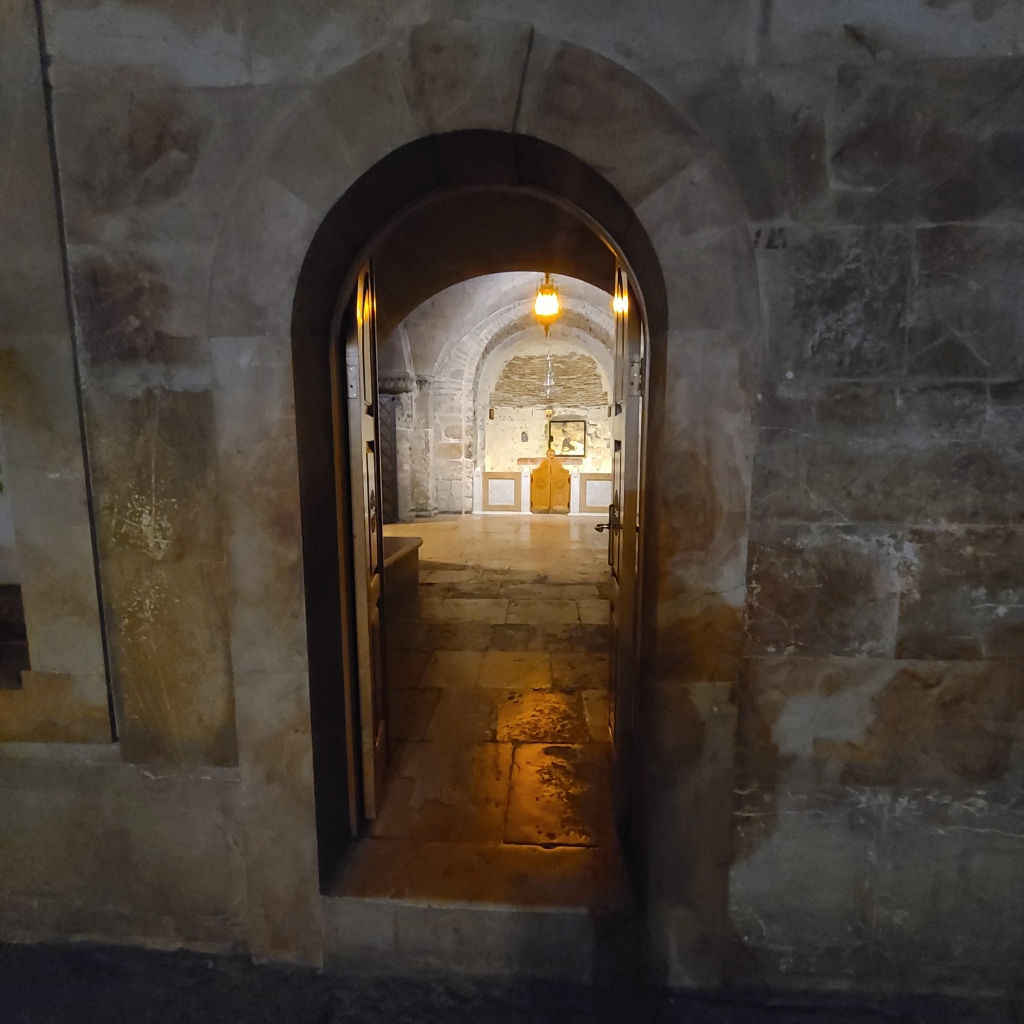
Ironically, the monuments were replaced with stone benches inside the chapel, and there is nothing to mark the sites of the graves nor to remember them. The two rulers are Godfrey of Bouillon and King Baldwin I. Godfrey traveled all the way from what is now Belgium on the First Crusade and was one of the princes who jointly conquered Jerusalem on 15 July 1099. He was selected to be the new ruler of the Crusader Kingdom of Jerusalem, but refused the title “king” and chose the title “Defender of the Holy Sepulcher” because he “would not wear a crown of gold where his Lord wore a crown of thorns.” The other ruler, Godfrey’s successor, is his brother Baldwin I. After Godfrey died, Baldwin, who originally had chosen to settle the city/area of Edessa (modern day Sanliurfa, Turkey) instead of travel the whole way on the First Crusade to Jerusalem, finally came to the Holy City and decided, unlike his brother, to claim the title of “King of Jerusalem.”
The above-ground monuments built over the underground coffins of the two rulers were destroyed in the wake of a great fire that engulfed the Church of the Holy Sepulcher in 1808. After the fire, the floor of the chapels on top of Golgotha was extended out, and a new stairway (which exists today) was built so pilgrims could immediately walk to the top of Golgotha upon entering the church. A part of this new construction ironically included the stone benches over the places where the tomb monuments once stood.
Amazingly, a recent, convincing scholarly article published in 2022 by experts Amit Re’em, Estelle Ingrand-Varenne, and Ilya Berkovich argues there is good cause to believe that, despite the ravages of time and some historical evidence claiming the contrary, it is possible medieval coffins containing the remains of the two rulers are still in situ several feet below these benches. Only time will tell if archaeologists will be able to concretely identify the existence (or not) of these coffins! Godfrey’s remains were buried under the bench on the left side of the photo below, while Baldwin I’s remains were buried under the bench on the right side.
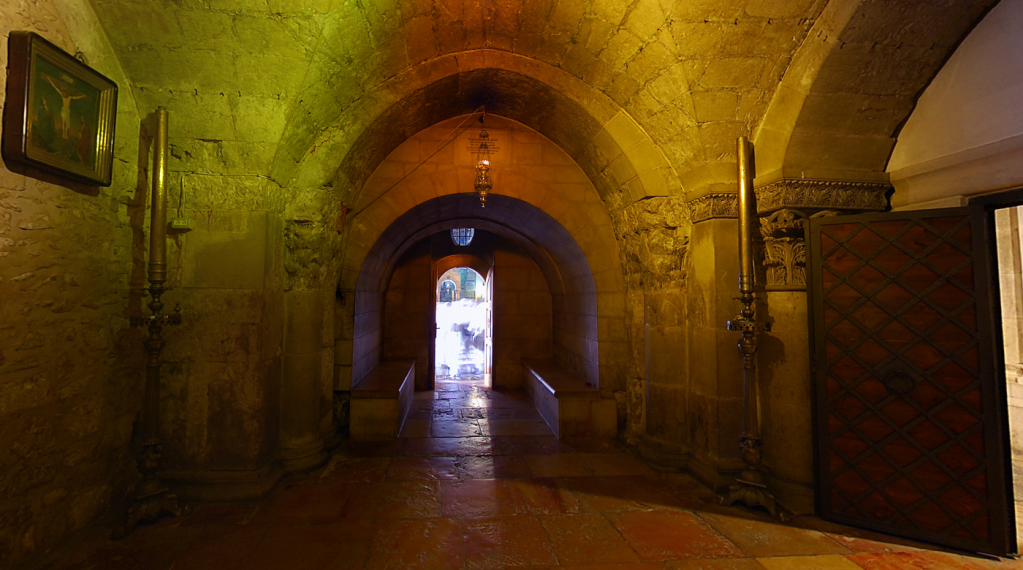
Below, left is a lithograph depicting Godfrey’s tomb monument before the 1808 fire and below, right is a map depicting the placement of Godfrey and Baldwin’s tombs before the same fire.
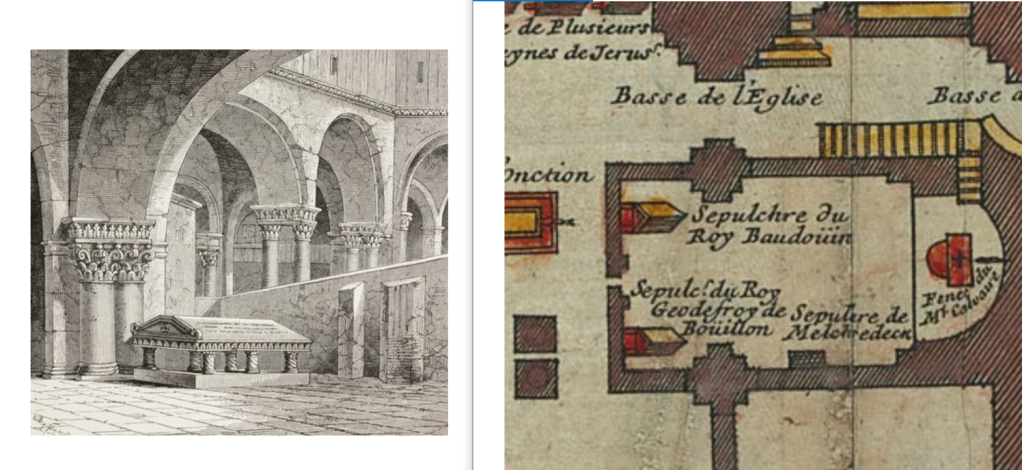
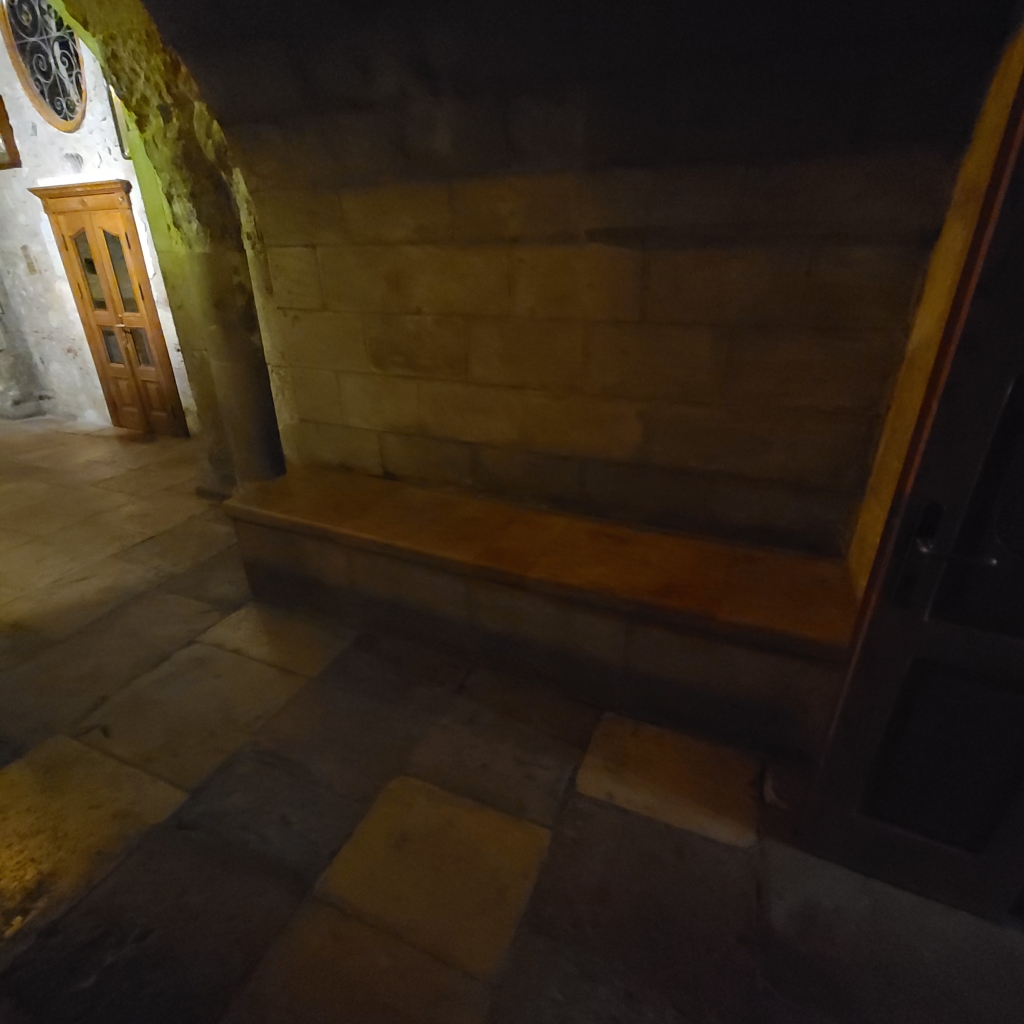
After visiting the Chapel of Adam, I walked over to the grand rotunda of the church, built by the Roman Emperor Constantine and standing since the early A.D. 300s. It overlooks the shrine (known as the “edicule”) containing the tomb of Christ. The Church of the Holy Sepulcher is shared by six different Christian churches: the Roman Catholic Church, Greek Orthodox Church, Armenian Apostolic Church, Ethiopian Orthodox Church, Coptic Orthodox Church, and Syrian Orthodox Church. When I approached the tomb, the Armenians were in the middle of one of their services in the tomb (see below). To pass the time until Mass, I leaned against one of the massive pillars holding up the rotunda for the last 1,700 years and prayed for all my intentions for this pilgrimage. It was a peaceful time as I waited for the Armenian service to end, and it helped ensure I was in position to be able to enter the tomb for Catholic Mass after the Armenians were done. The website I referred to the previous night said “space was limited” for Mass inside the tomb, and I wanted to make sure I made it in.
Although nothing could be done about it, I felt bad for some of the pilgrims who I saw walking around. Some of them gave the impression that they wanted to enter the tomb, but unless they were participating in one of the many services that are scheduled on Sunday mornings, they would not be permitted to enter. Hopefully they would have the opportunity to come back later in the day.
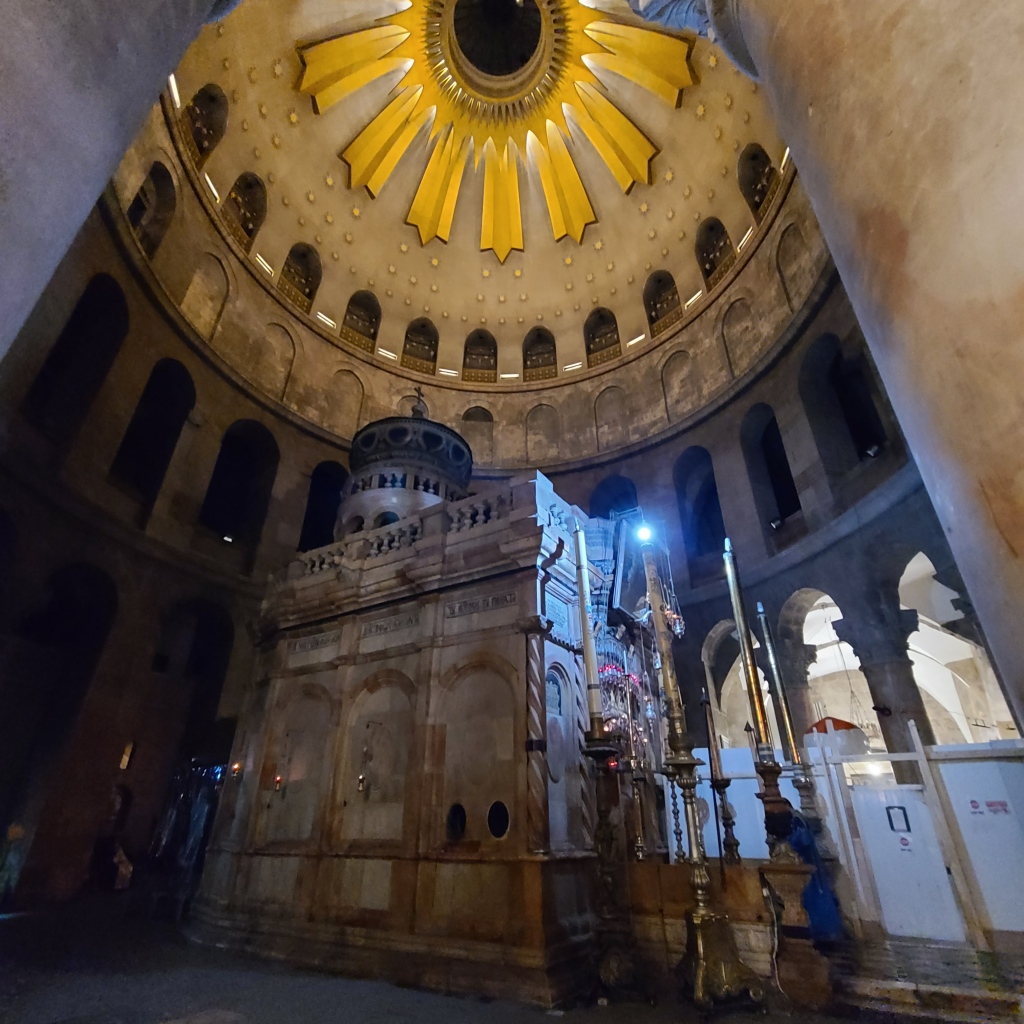
Once the Armenian service had ended, several women walked over and stood near the entrance to the tomb, waiting for the Armenian clergy to finish taking down their liturgical items inside the edicule. I followed them over and put myself in a good position in the line. Once the Armenians had cleared out, the Catholic clergy began setting up inside the tomb (see photo below). One of the Franciscan staff setting up made a brief announcement welcoming pilgrims into the tomb who wished to attend Mass.
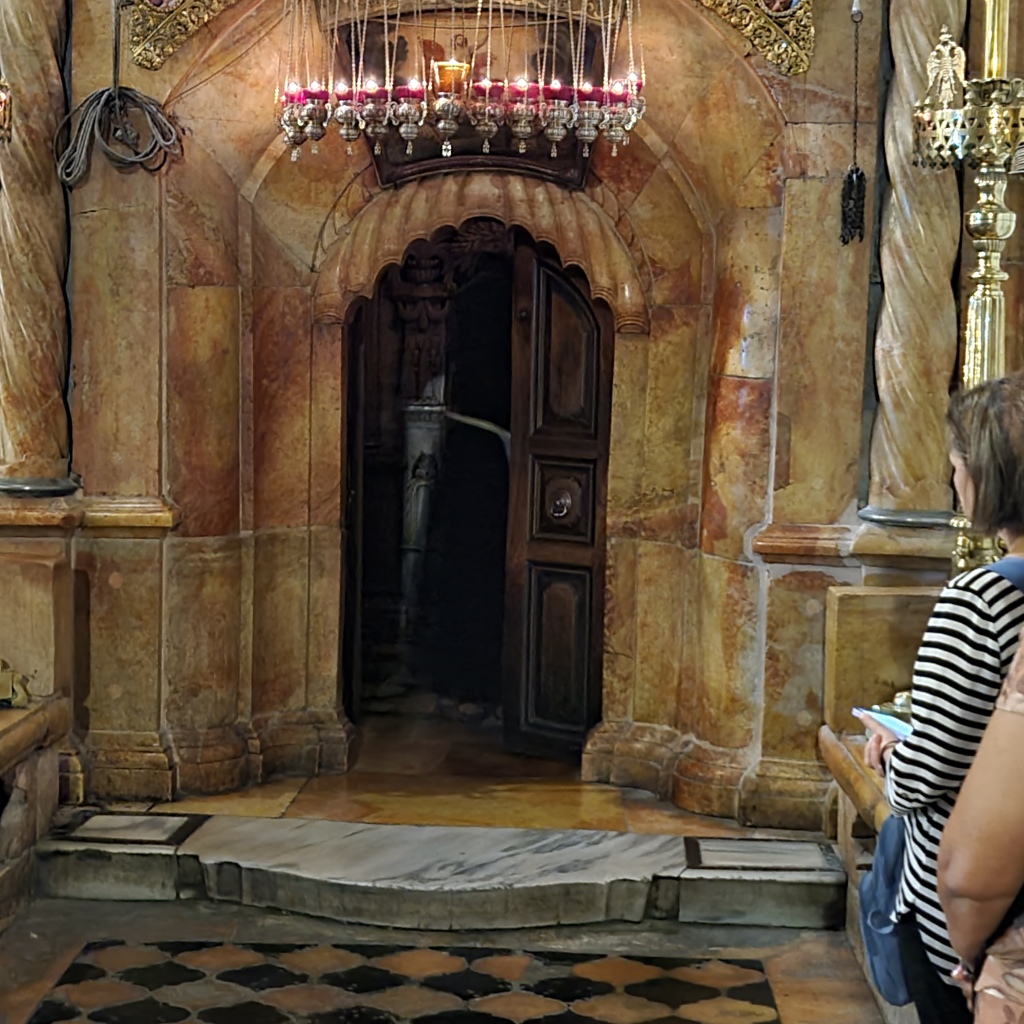
I began walking forward and entered the edicule, taking up a position in the back left corner of the small chapel immediately inside the edicule, but outside its innermost room where Christ’s body was laid. This chapel is known as “the Chapel of the Angel” because it would have been the location where the large stone covering the door into Christ’s tomb was rolled back by the angel. In the center of this small chapel is an altar that contains a portion of the actual stone rolled back by the angel.
A team of about 6 priests entered the edicule as well. There were about 15 laypersons total that were allowed into the edicule, and then the doors were shut, leaving others behind outside. I was grateful to have gotten up so early so I could be towards the front of the line. The only other similar experience to this I could relate to in my life is standing in line to get into a new blockbuster movie—except, this was so much more important than that!
Everyone got settled inside the Chapel of the Angel, and the clergy made final preparations for Mass (see photo below). It was a very intimate setting with everyone so close together. I could tell we were all attempting to process in our minds and hearts where we were and what we were taking part in. How blessed were we and grateful for this holy experience!
The Mass began. It was all in Italian. But, one of the blessings of being Catholic is the Mass is the same sequence of events and words no matter where you are or what language it’s in. So, I was able to follow along and respond when required in English. The presiding priest offered to allow me to read the first reading but, unfortunately, I had to decline since I don’t speak Italian! The Mass was beautiful. For Masses inside the edicule, after the Liturgy of the Word in the Chapel of the Angel, the presiding priest then moves into Christ’s tomb chamber itself for the Liturgy of the Eucharist. Inside the tomb chamber, a temporary altar is set up on top of the funerary bench where the body of Christ was laid after His death. The reality of the Eucharist and transubstantiation—the words of Christ spoken through the priest which transform the bread and wine into the body, blood, soul, and divinity of Christ–therefore, comes all the more into focus when Christ’s body and blood once again are found inside the tomb, reposing on the very funerary bench upon which His dead body was laid and upon which He would be resurrected.
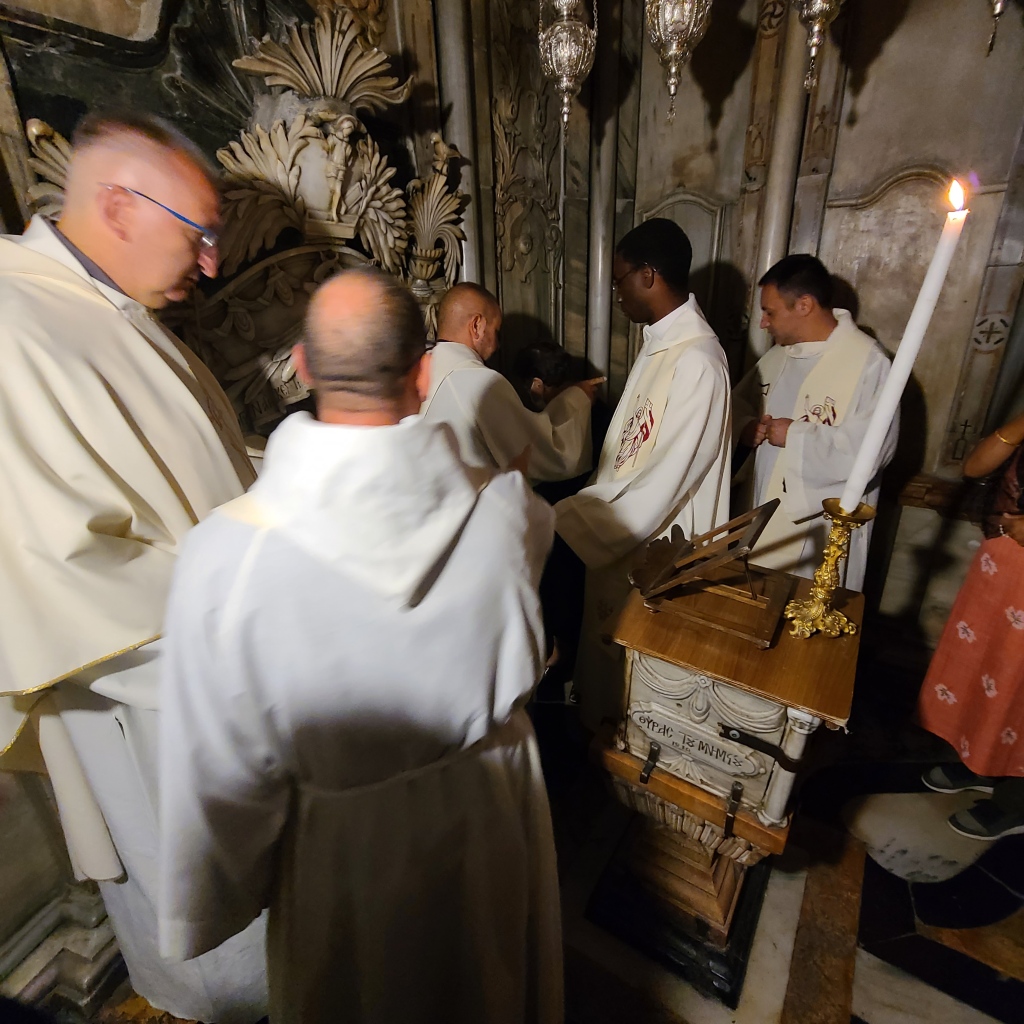
The actions of the presiding priest during any Mass—words and deeds, no matter how small—are significant. Many don’t take notice of the order with which Christ introduced the two elements of the Eucharist: body, then blood. If you have a body and then blood, that constitutes a body being injured, suffering, bleeding, and–in this context–a sacrifice. Like the first Passover in Egypt, an unblemished lamb (Jesus) was sacrificed (at the Crucifixion). During the Mass, the priest breaks apart one of the consecrated hosts to show the breaking of Christ’s body during His crucifixion. However, before communion is distributed, the priest breaks off a piece of a consecrated host and places it in the Precious Blood inside the chalice. This action signifies Christ’s body being re-united to His blood and new life—this signifies the Resurrection.
It’s quite the understatement that Mass in Jesus’s tomb is a unique experience. One of the many aspects that makes it unique is the priest during the Liturgy of the Eucharist is separate from the congregation, with the priest being inside the tomb chamber and the congregation being assembled immediately outside in the Chapel of the Angel. From the Chapel of the Angel, you can hear the priest reciting the prayers from the Liturgy of the Eucharist, but it is slightly muffled since he’s in another room!
On that Sunday morning, I lived one of the most powerful experiences of my life. I’m very grateful I took some pictures of it. Before distributing Communion, the priest broke apart one of the hosts consecrated in Jesus’s tomb and broke off a piece of the consecrated host and placed it in the Precious Blood inside the chalice. The priest then brought Jesus Christ Himself—body, blood, soul, and divinity—out of His *actual* tomb just as Jesus Himself came out of His tomb on Easter Sunday, and presented Him to the congregation (see next two photos). It was incredible. This moment and receiving Communion in Jesus’s tomb was a heavenly experience I will always be grateful for and will never forget the rest of my life.
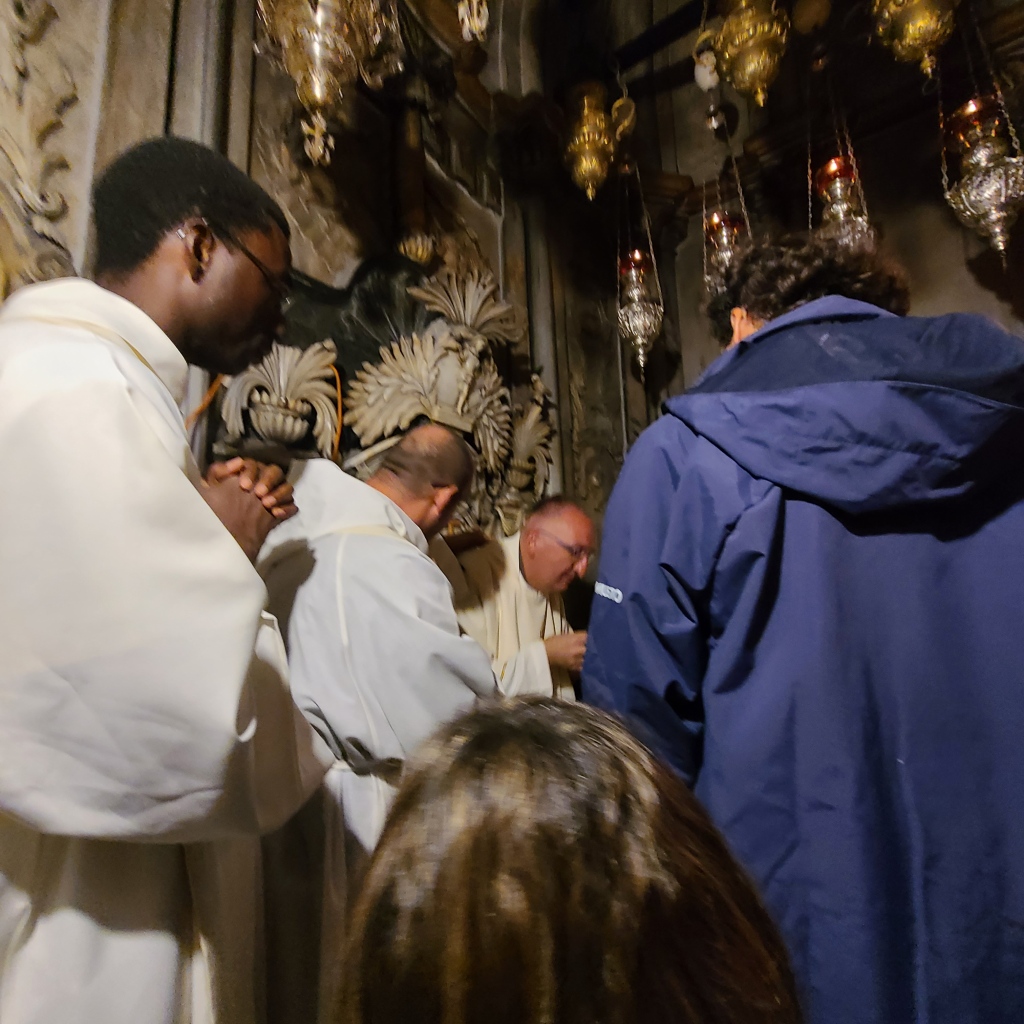
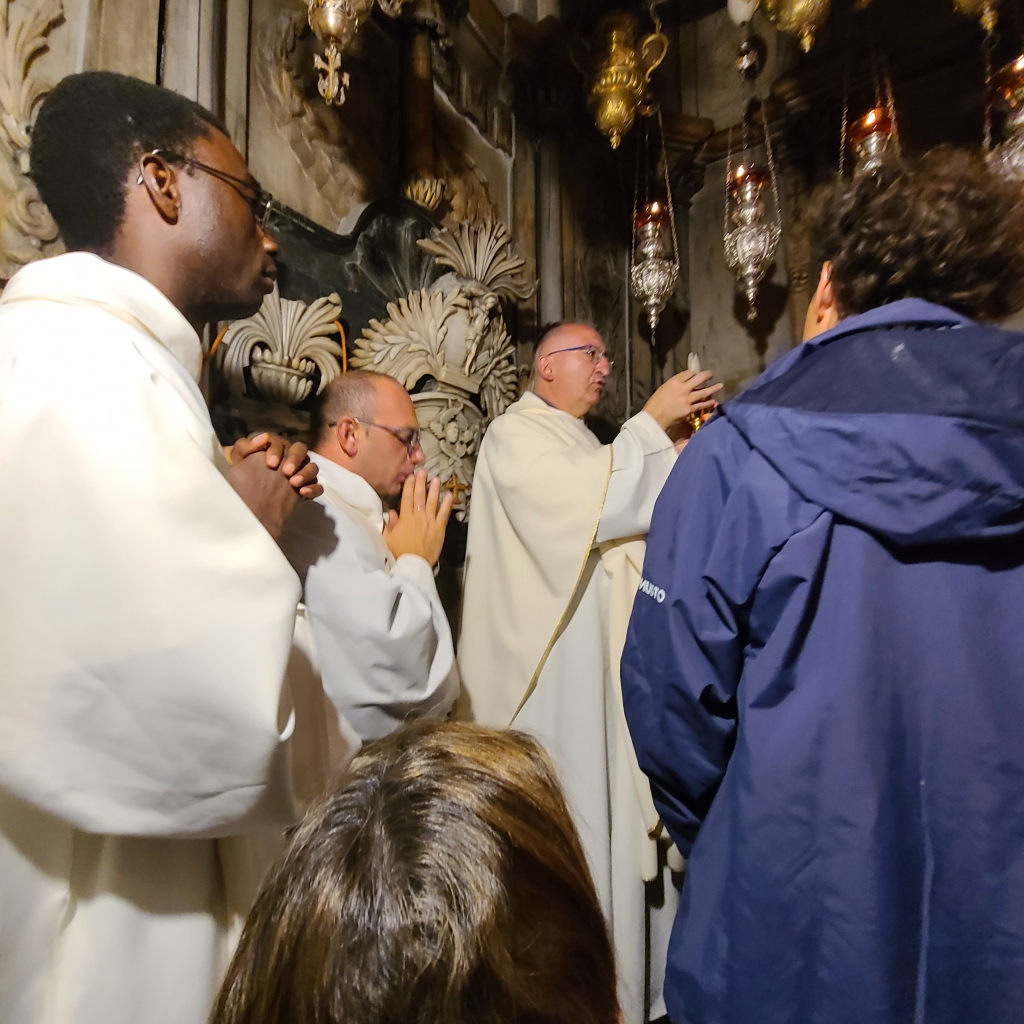
After Mass ended, the congregation was asked to exit the edicule. I snapped a quick photo behind me of the altar inside the Chapel of the Angel, still holding a candle with its light still burning bright.
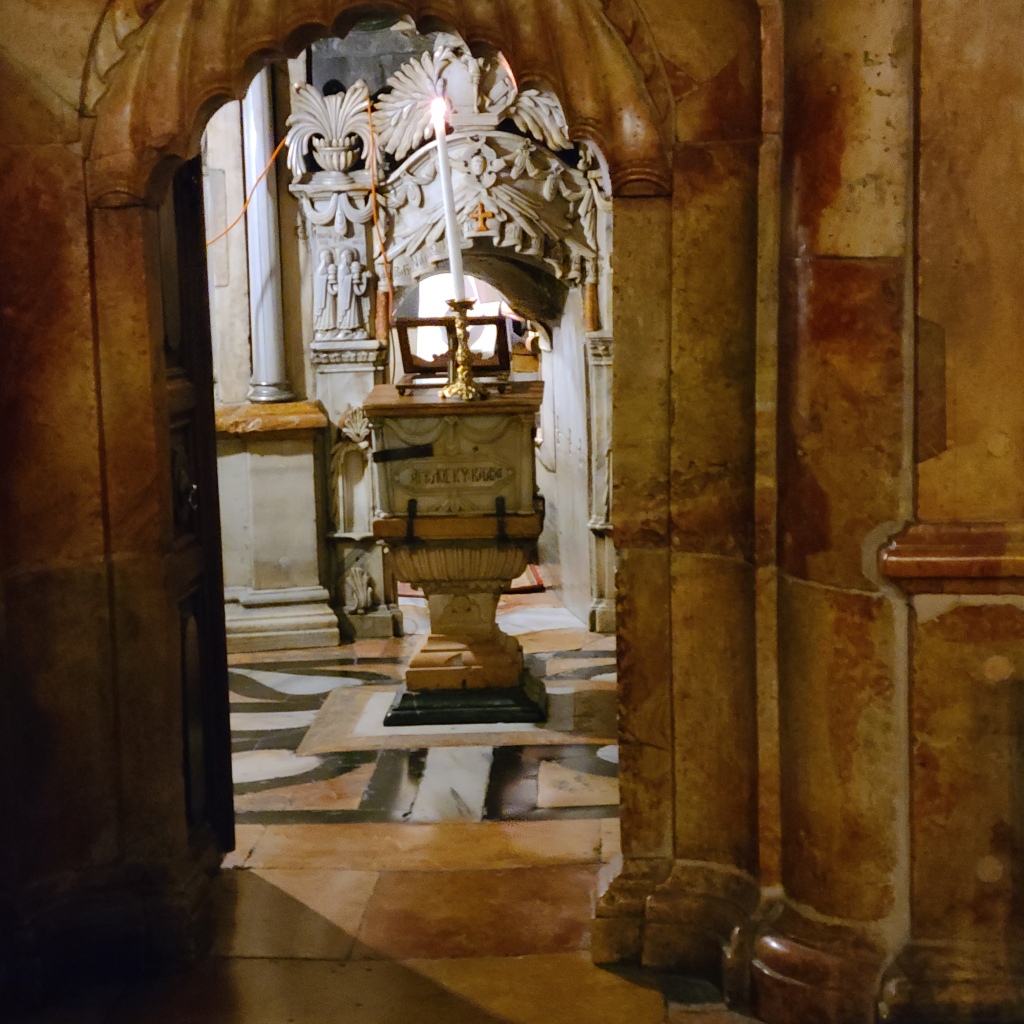
After just receiving communion in Jesus’s tomb, I walked around the church meditating on what I had just experienced and what had happened here 2,000 years ago. It is hard to describe in words.
As I walked around, I visited a few other important locations inside the church: a fragment of the Column of the Flagellation (a piece of the column which Jesus was bound to when He was scourged), some of the actual rock of Golgotha exposed for pilgrims to view, and the grand mosaic near the entrance to the church depicting Jesus’s removal from the cross and burial.
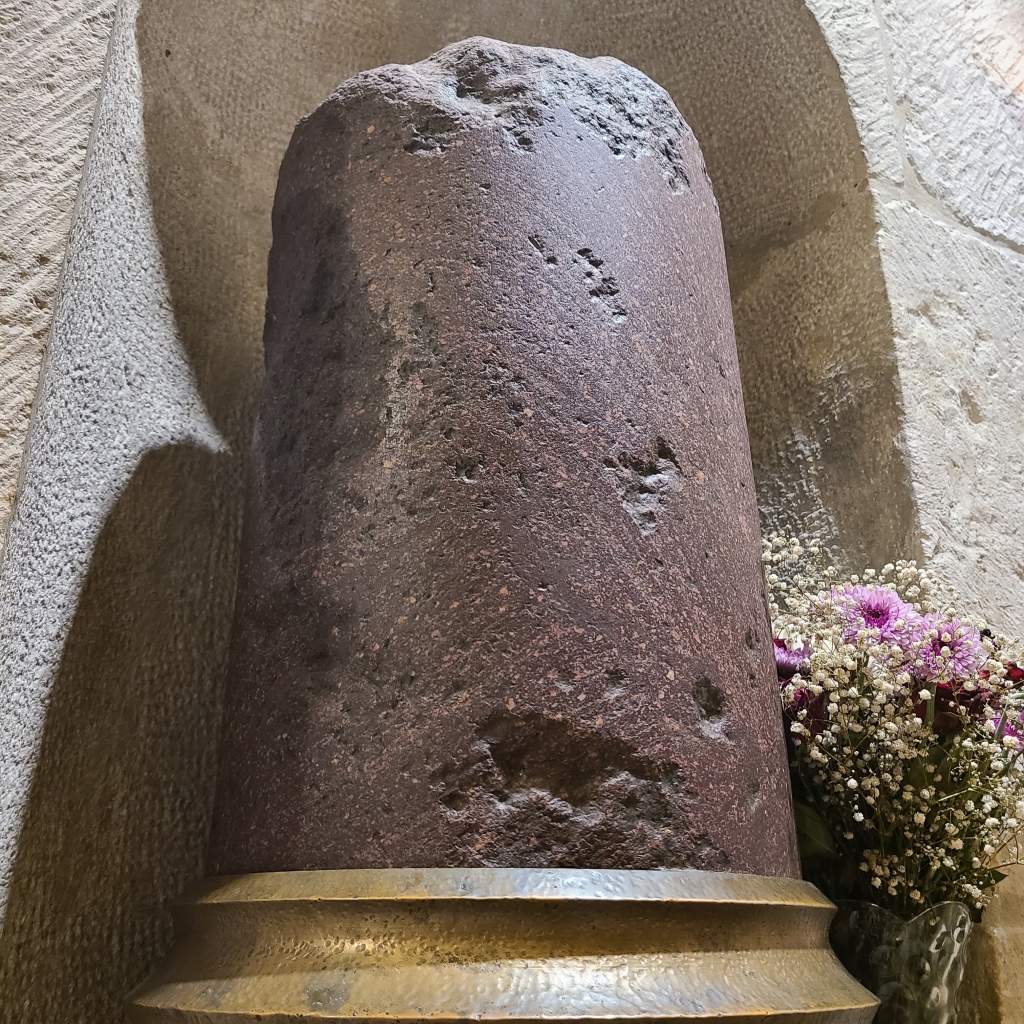
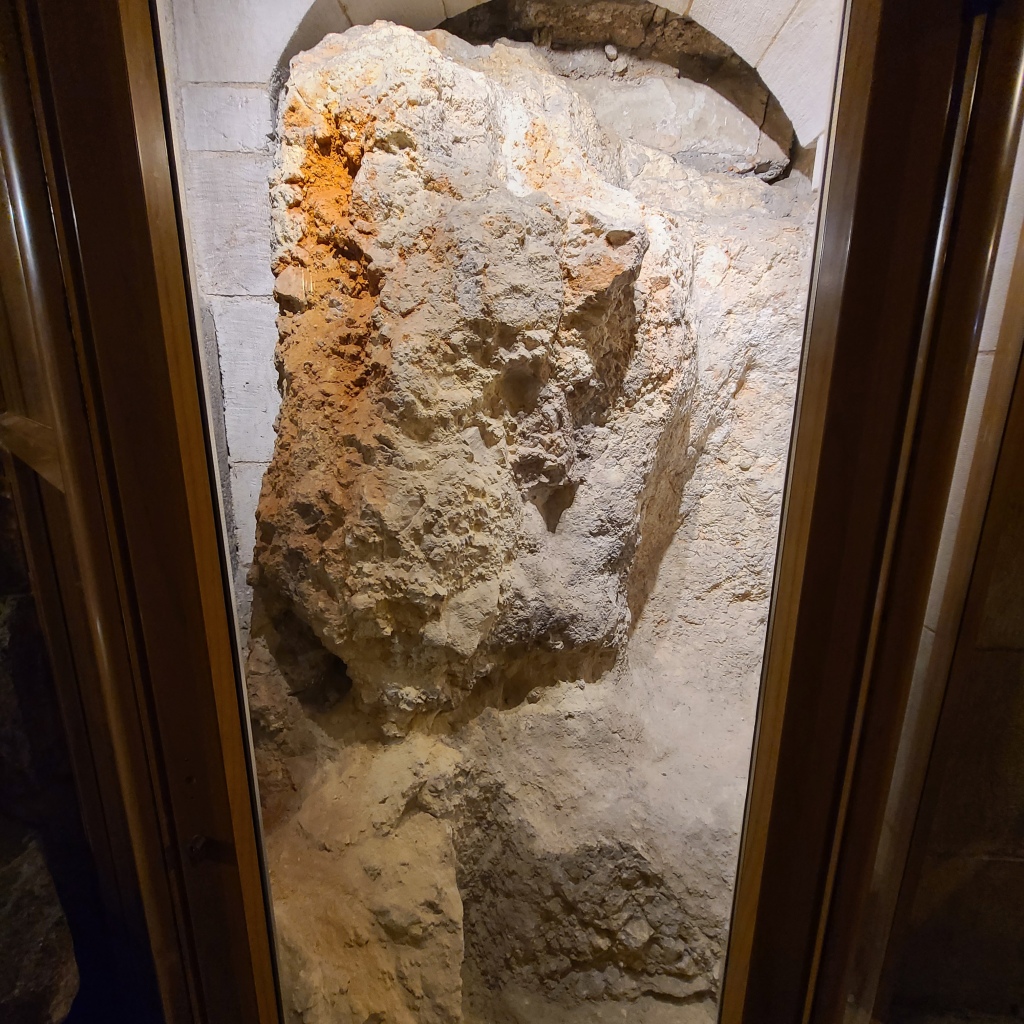
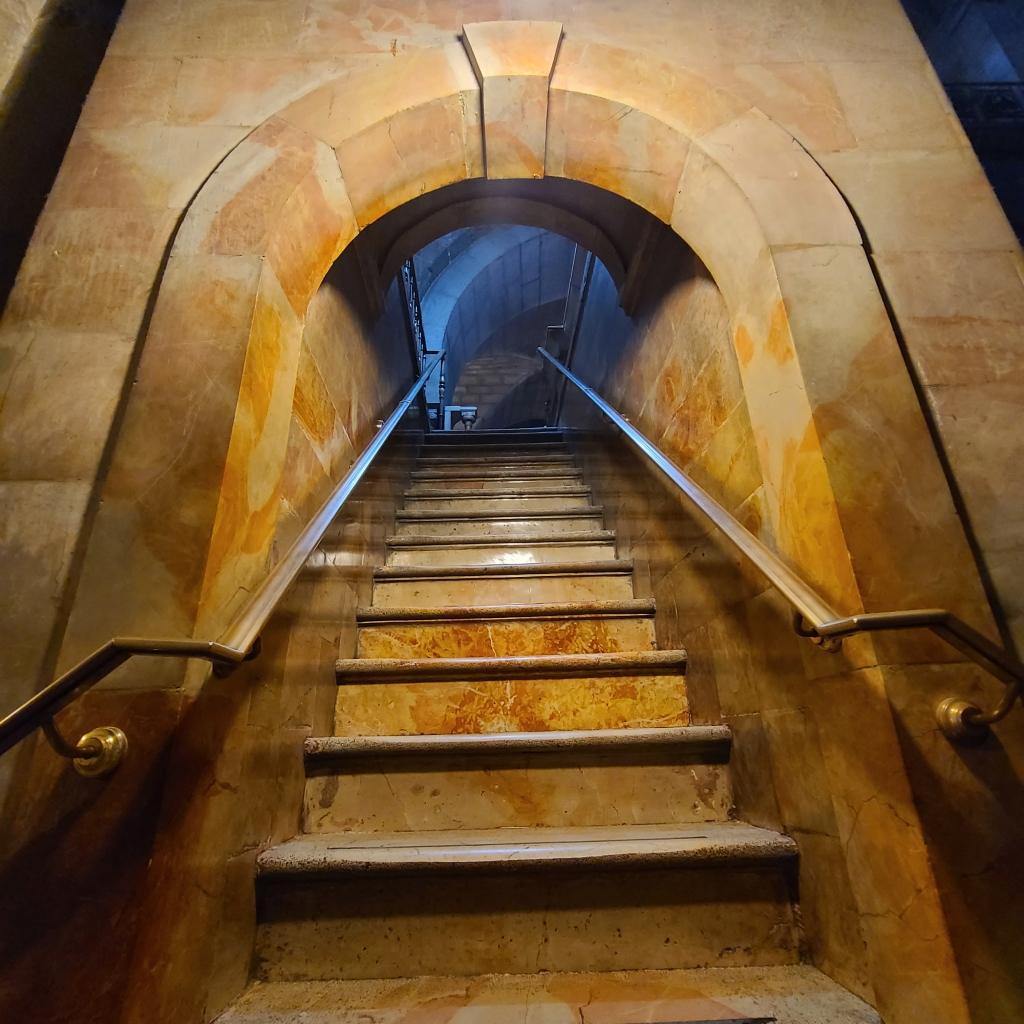
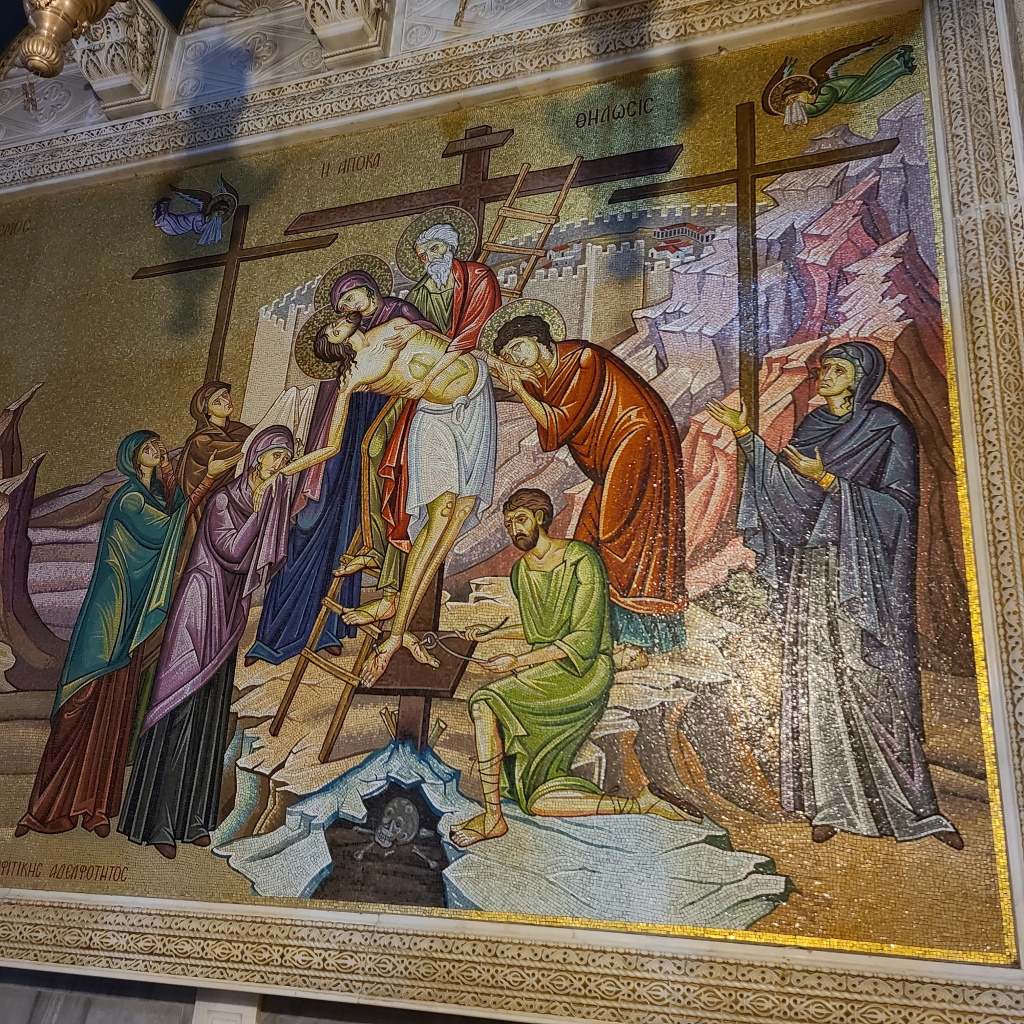
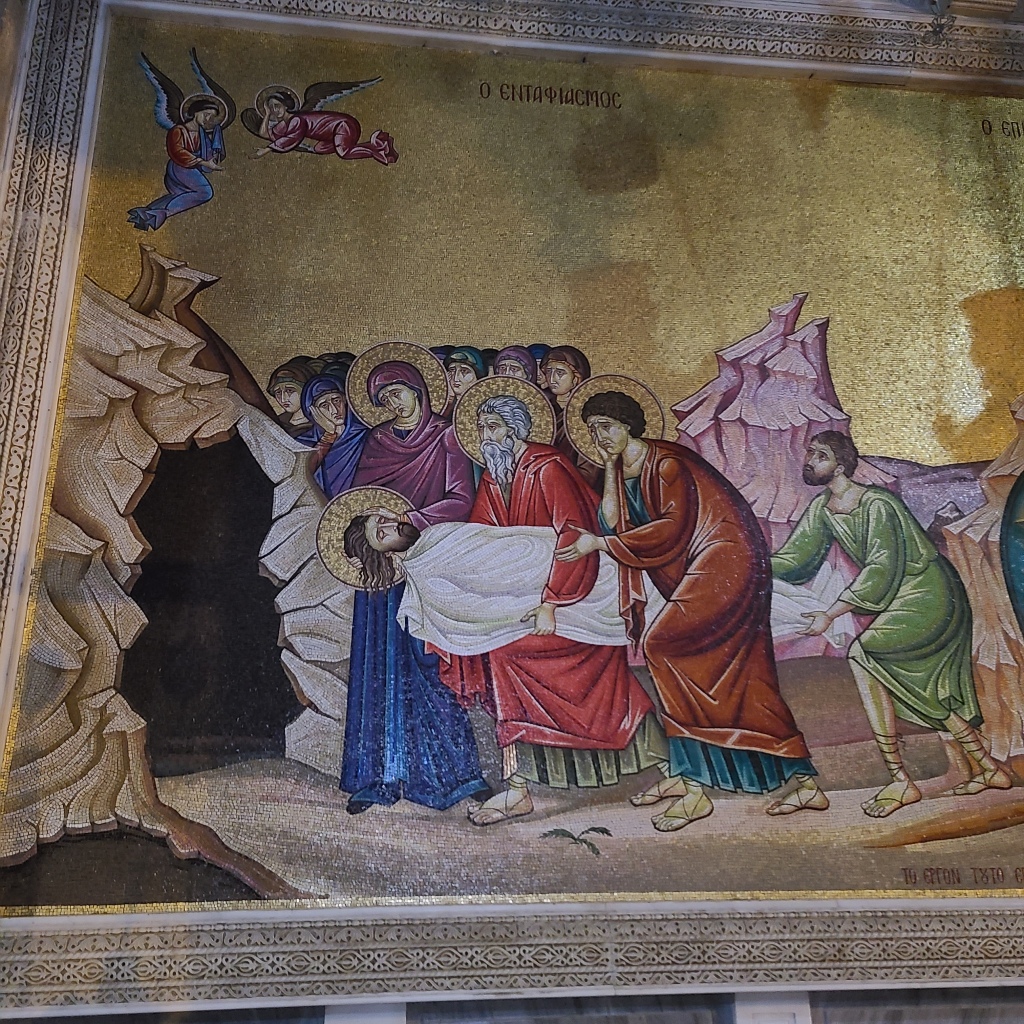
After the scheduled Sunday morning services were over, the edicule was opened for pilgrims. I had the opportunity to go back in to venerate the funerary bench where Jesus’s body was laid. I also took some pictures of the altar in the Chapel of the Angel, which contains a portion of the actual stone rolled back by the angel. Incredible!
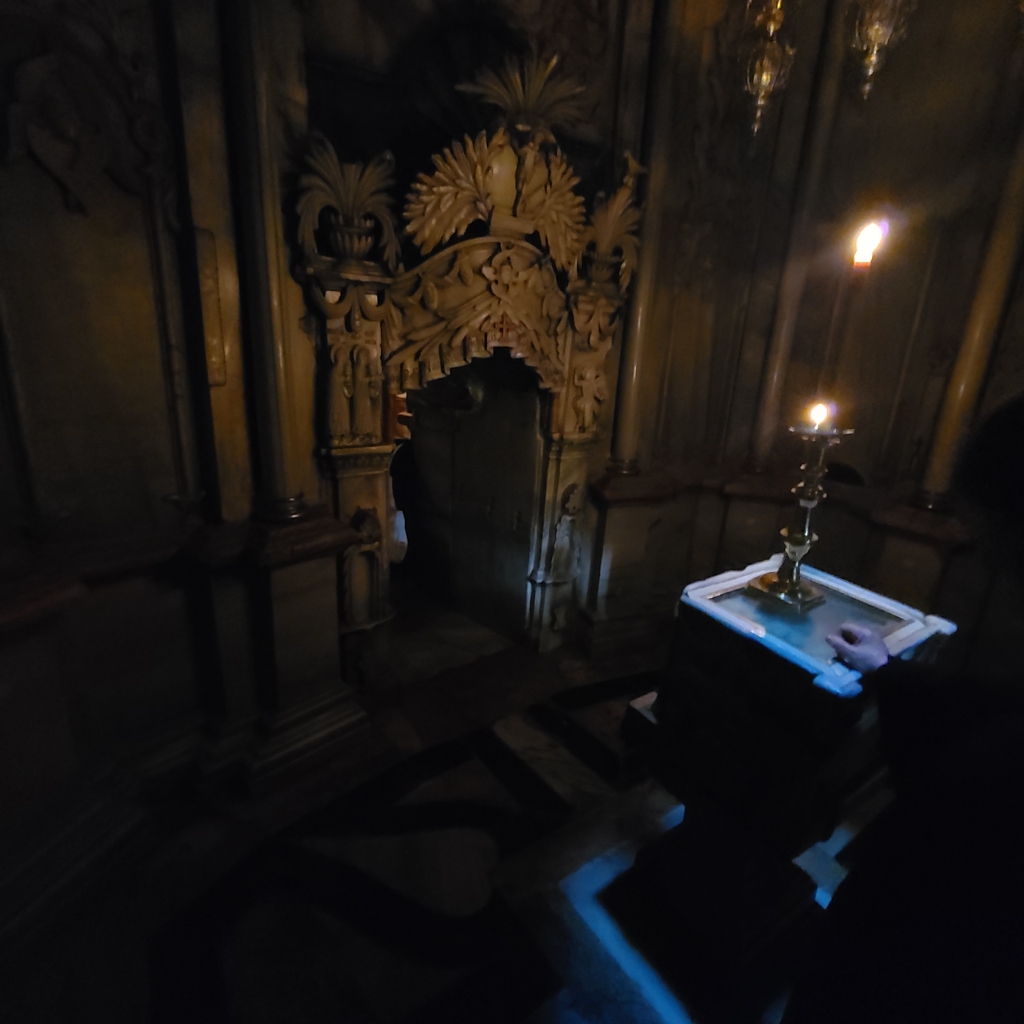
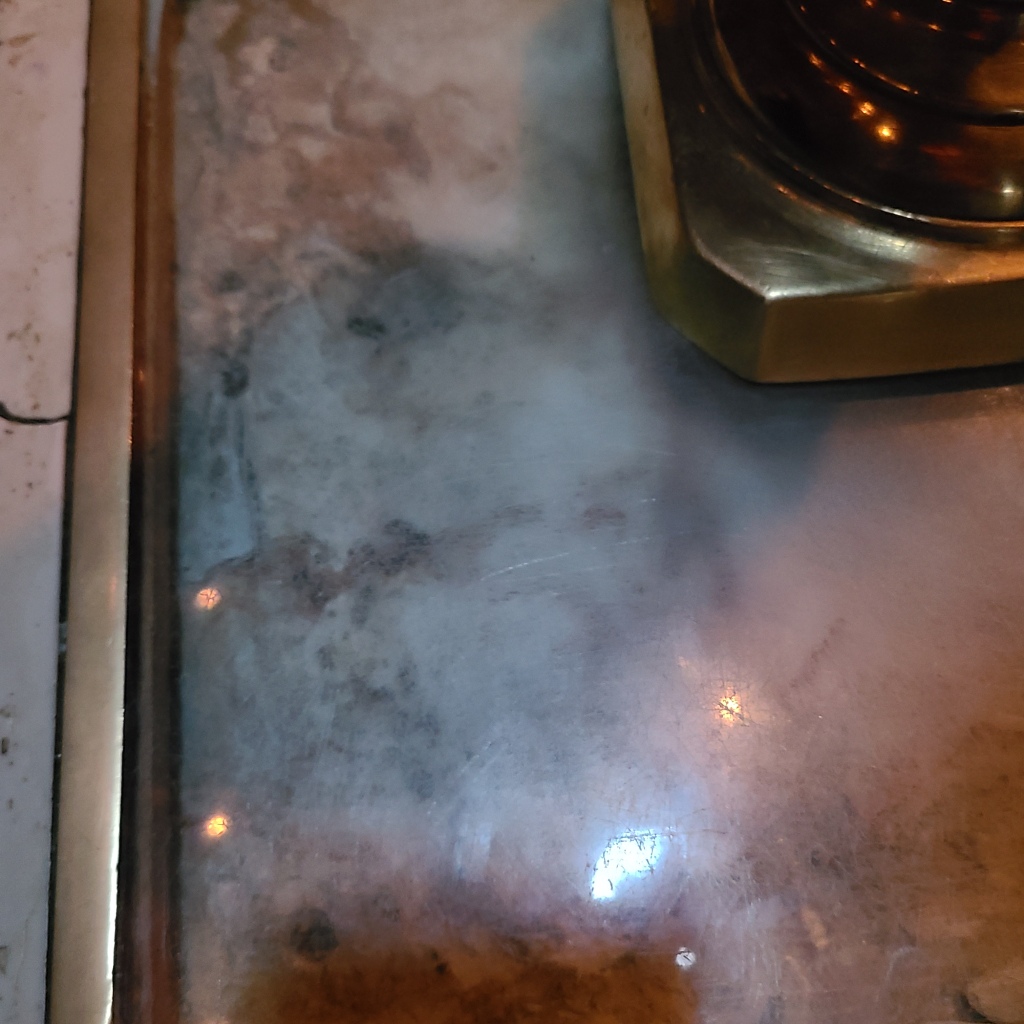
Inside the tomb chamber, I was able to kneel and pray beside the place where our Lord was raised. There is a marble slab covering the actual surface of the funerary bench. The small container with candles on the bottom left would have been where Jesus’s head would have laid.
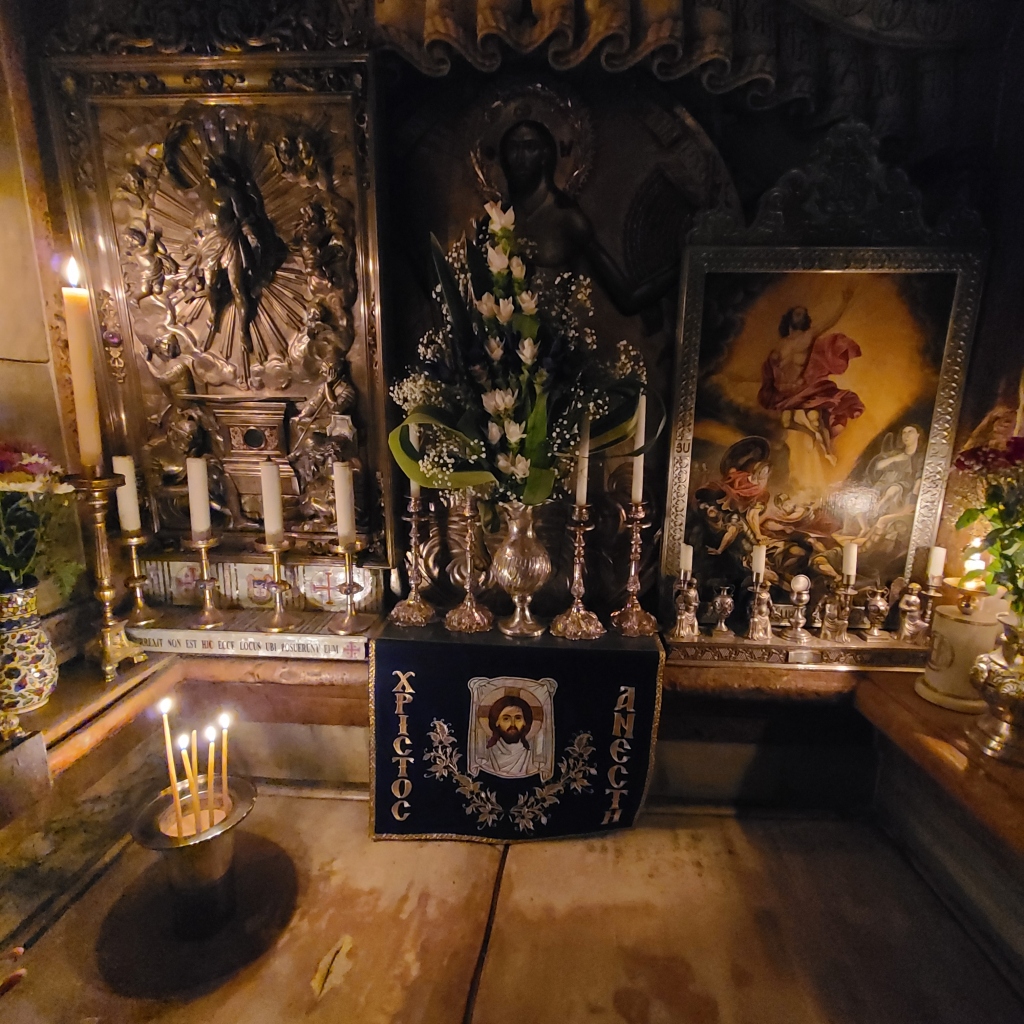
The marble slab covering the funerary bench was removed for the first time in hundreds of years on 26 October 2016 during a restoration project. Underneath this slab was an older, broken marble slab that had been mortared to the original limestone surface. According to National Geographic, samples of the mortar were independently tested at separate labs and it was found the mortar dates to approximately A.D. 345 near when Romans under Emperor Constantine re-discovered the tomb (which had a Roman Temple built over it by a former Roman Emperor) and built the first edicule over the tomb chamber to preserve it. The edicule that stands today is actually the latest in a series of edicules that have stood over the tomb.
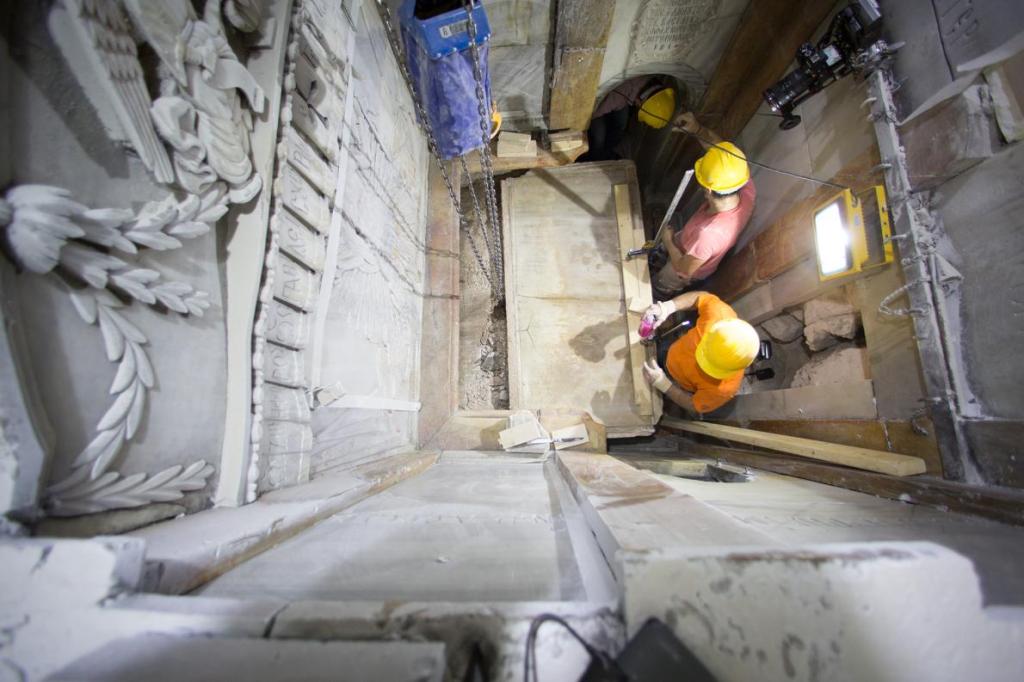
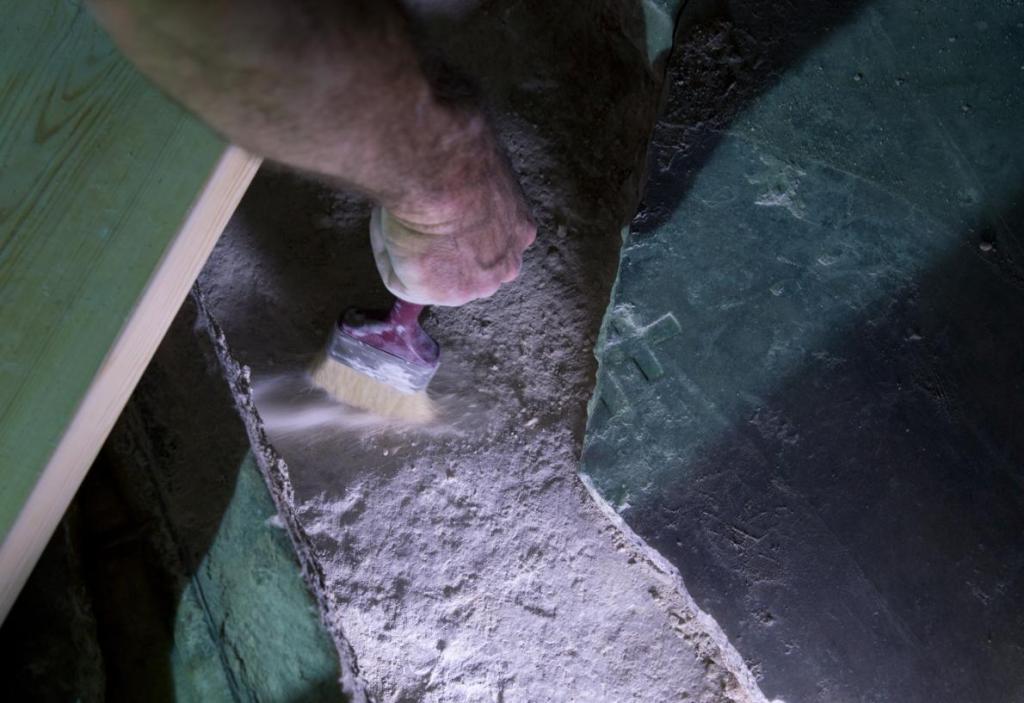
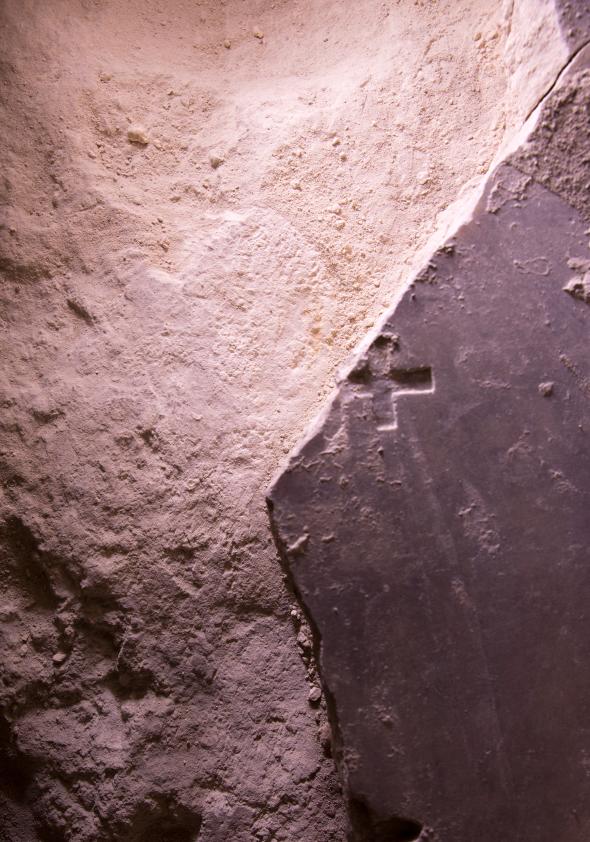
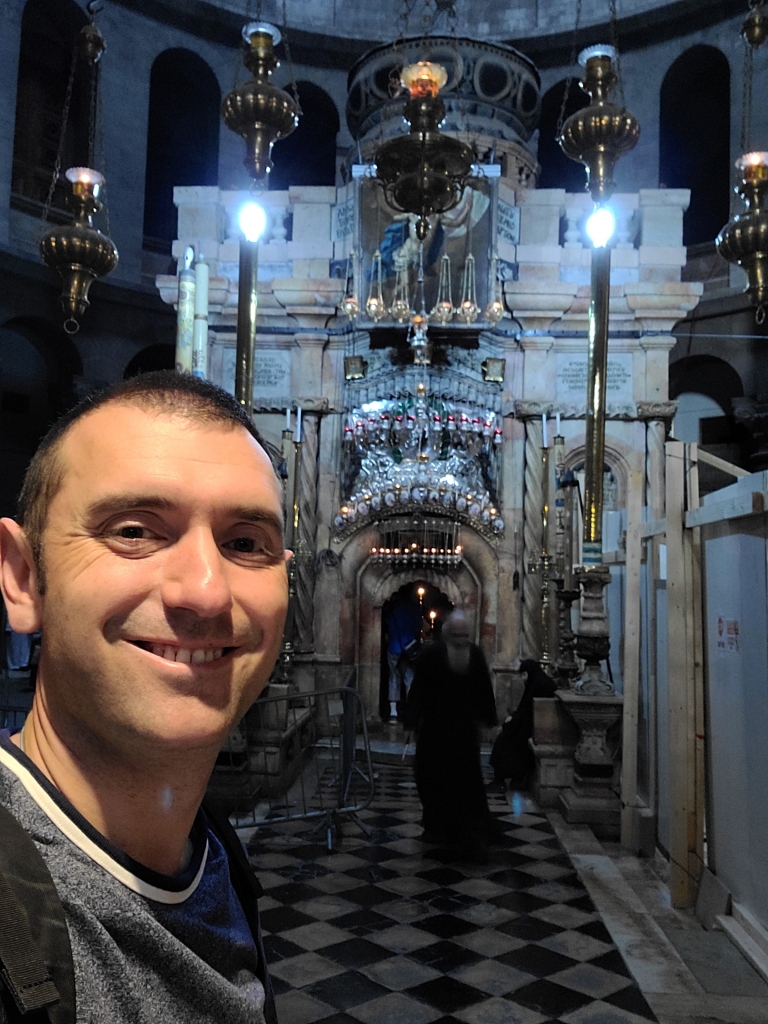
After visiting Jesus’s tomb, I left the Church of the Holy Sepulcher to see more places on my bucket list in Jerusalem. The next place on my itinerary was the Church of St. John the Baptist in the Muristan (GPS Coordinates: 31°46’37.25″N, 35°13’46.69″E) neighborhood of the Old City.
This church was thought to have once held the relic of St. John the Baptist’s head. The original church is in the basement of the current building and appears to date to the time of the Emperor Constantine or not long after (4th to 6th Centuries). In the 11th Century, merchants from Amalfi, Italy arrived in Jerusalem and took occupancy of the site. They constructed another church above the current one, which had been buried over the course of preceding centuries, and they also built a hospital at the site. This church was tended to by Benedictine monks. In 1099, Crusader knights injured during the siege of Jerusalem were treated at the hospital and after recovering started here what was to become the Order of Knights of the Hospital of Saint John of Jerusalem, named after the church. This new religious order would become known as the Knights Hospitaller and is known in modern times as the Knights of Malta.
Unfortunately when I got there, the church was closed, but I went to the side of the building and down the stairs to get a glimpse of the ancient basement of the current church, the original structure on this site. The doorway into the basement was sealed up, but it was so amazing to be so close to such a historic place which saw the rise of one of the crusader orders and a humanitarian organization that is still very active throughout the world to this day.
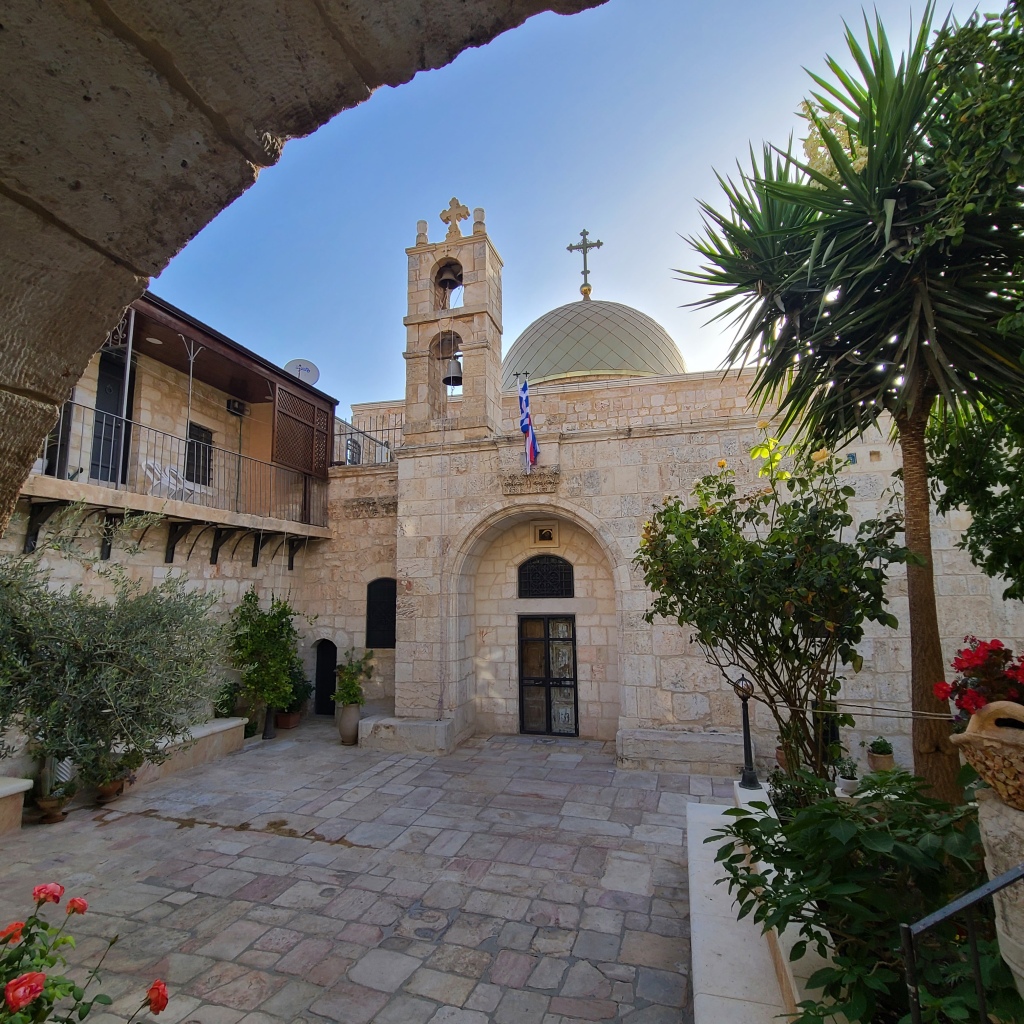
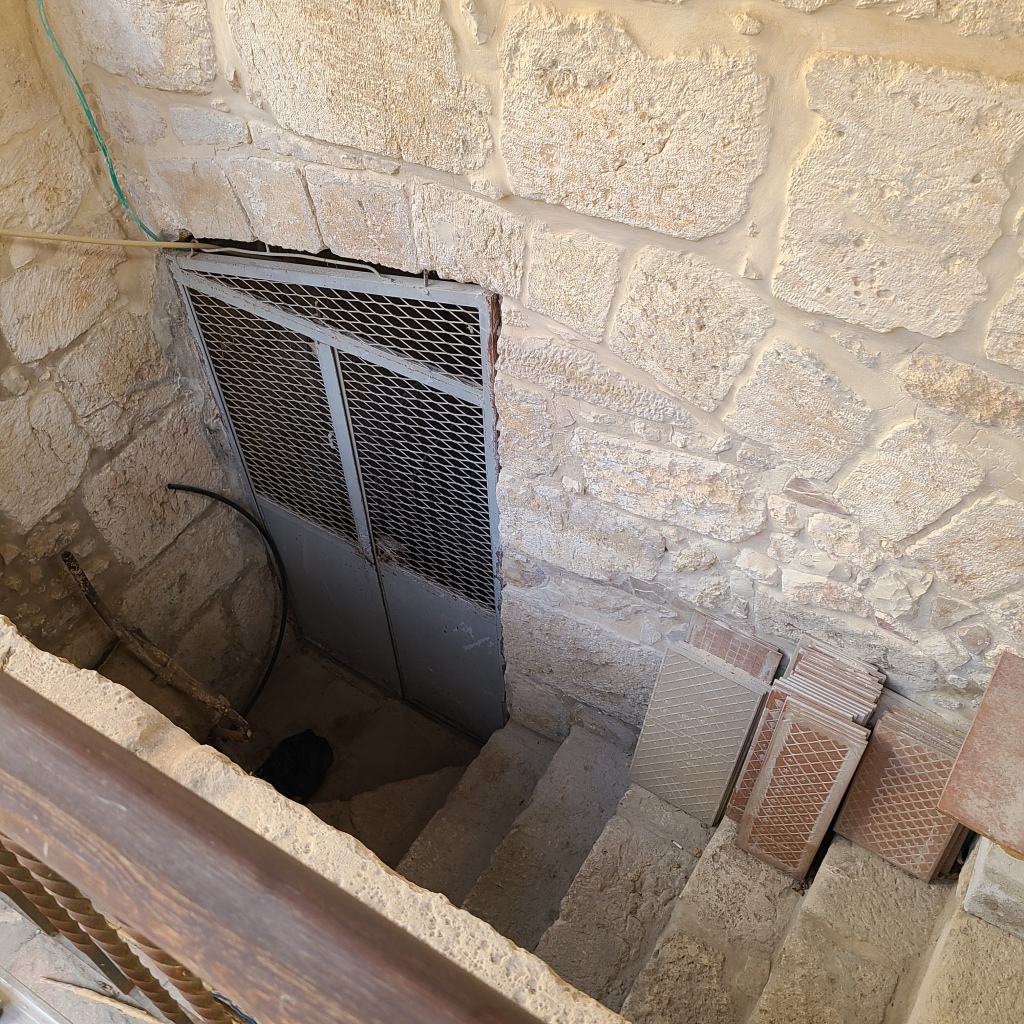
After visiting the Church of St. John I continued to walk further west and stopped by the entrance to the Al-Yaqubi Mosque (GPS Coordinates: 31°46’34.23″N, 35°13’45.60″E). Unfortunately, it was also closed. This building was once a church dedicated to St. Sabas during Crusader times and a tradition exists it was built over the place where the resurrected Jesus appeared to the women “on their way” as they were going back to tell the disciples He had risen (see Matthew 28:8-10). Interestingly, this location would have been inside the walled city of Jerusalem at the time of Jesus. So, if this tradition is to be believed, it appears Jesus may have appeared to the women in an urban area, i.e. on a street in the city early on that Sunday morning.
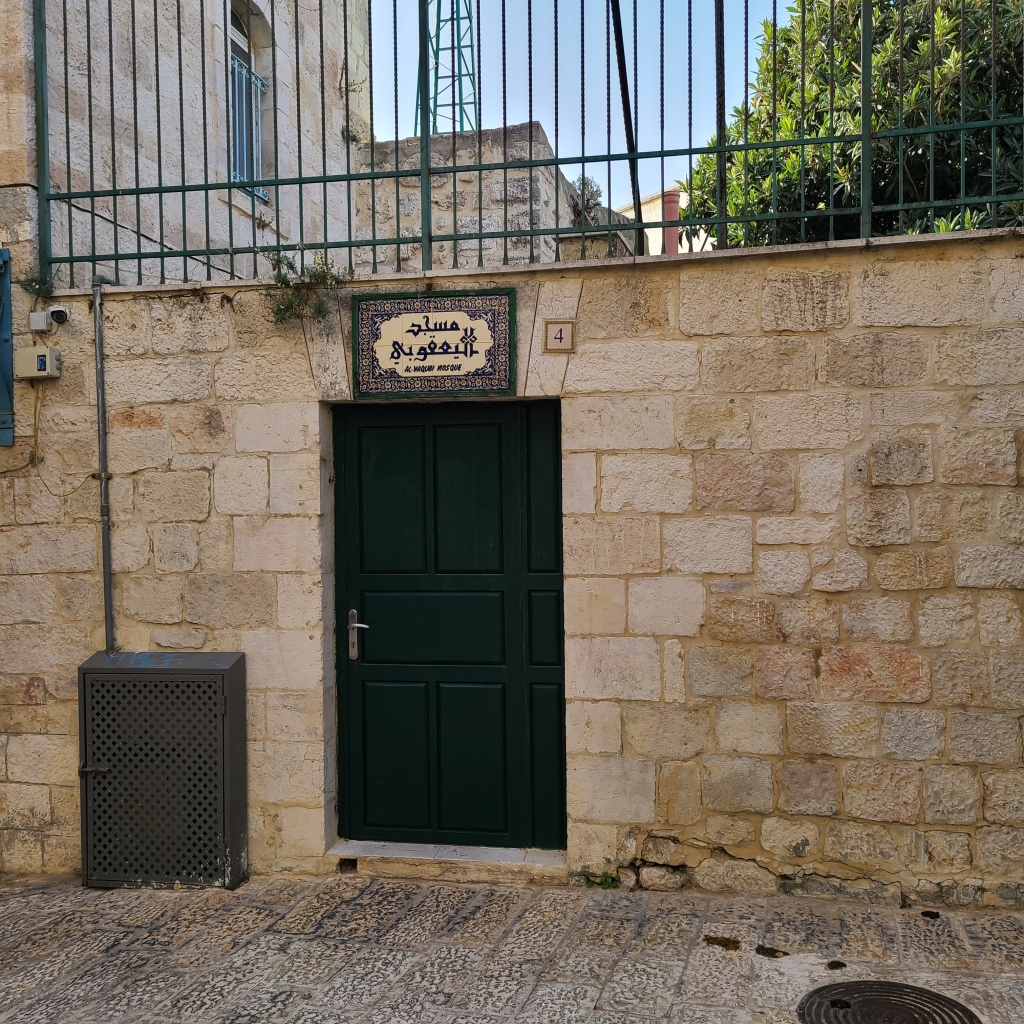
My next stop was the Armenian Church of St. James the Apostle (GPS Coordinates: 31°46’28.55″N, 35°13’44.67″E) in the southwestern area of Jerusalem’s Old City. A tradition dating to the Middle Ages holds that this church marks the location where St. James the Greater (the Son of Zebedee–“Big James” for fans of the TV show The Chosen) was beheaded by Herod Agrippa I. This location could make sense due to its close proximity to Herod the Great’s Upper Palace that stood on the western side of the city. Tradition has it that St. James’s skull was buried at this site as well, and a side chapel commemorates this location. The rest of the body of St. James, tradition has it, was taken to Spain (Sanitiago de Compostela) and entombed there with a community of followers he built while on mission. Some of the remains of St. James the Less (Jesus’s cousin) are also said to be buried near the Armenian bishop’s throne towards the front of the church.

When I arrived, the Armenian clergy were conducting a Divine Liturgy (a Mass). The Armenian chant was impressive as were the distinctive hooded cloaks of the clergy (see photo below).
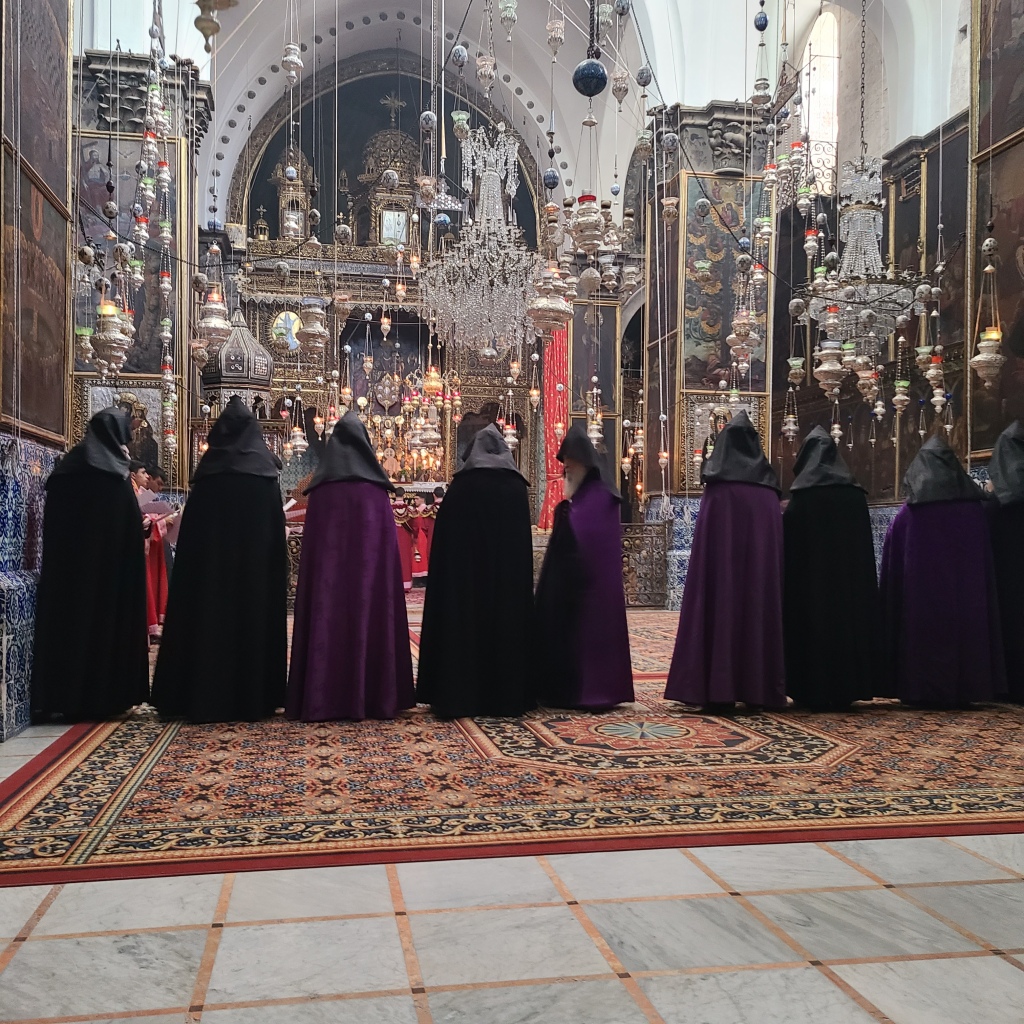
While there, I ducked into a side chapel on the left side of the church and said a prayer at the spot where St. James the Greater’s head is said to be buried (under the center of the floor, underneath the altar in the photo below). Amazing…
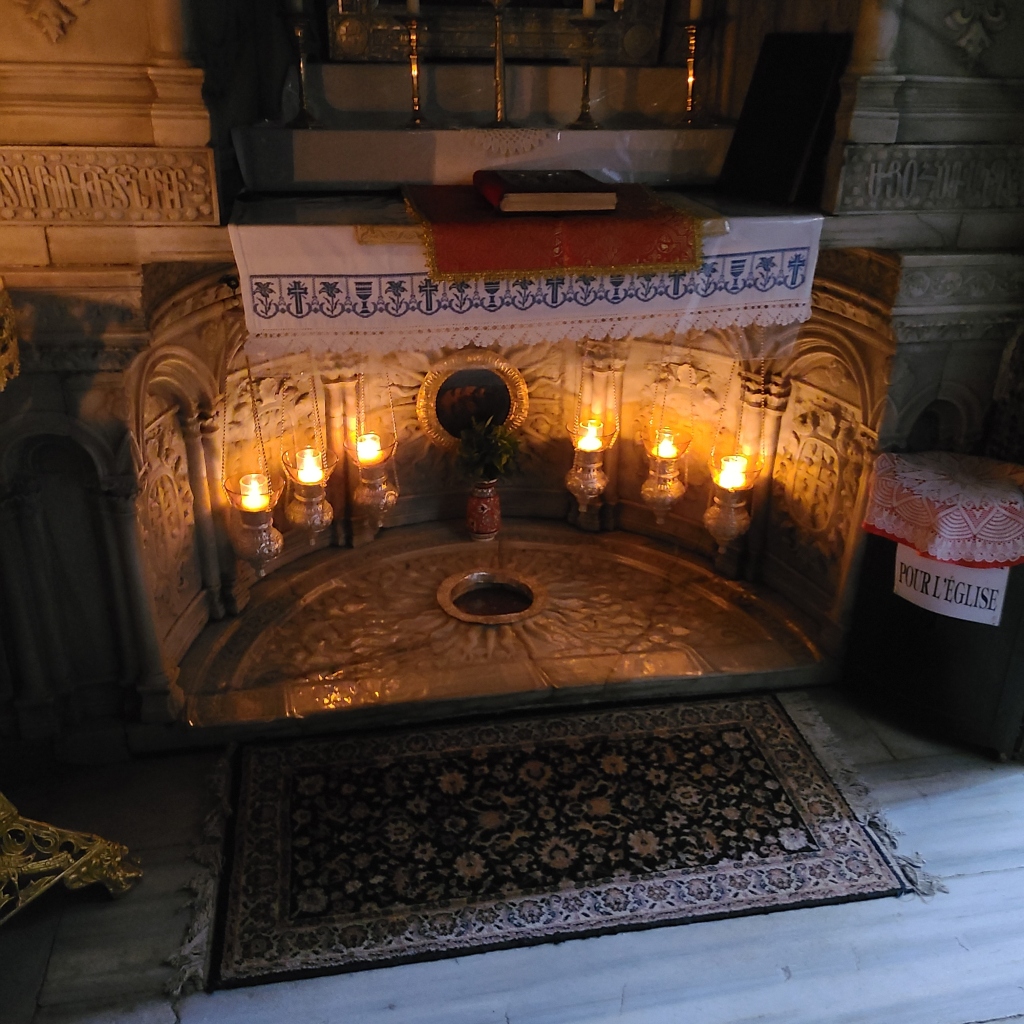
As I left the church, I noticed the strange-looking board suspended by chains from the side of the church. These boards are known as “symandra” and are hammered by mallets to call the faithful to prayer. These were first used when a Muslim edict in the 1300s forbade churches to ring bells. What history and innovation!
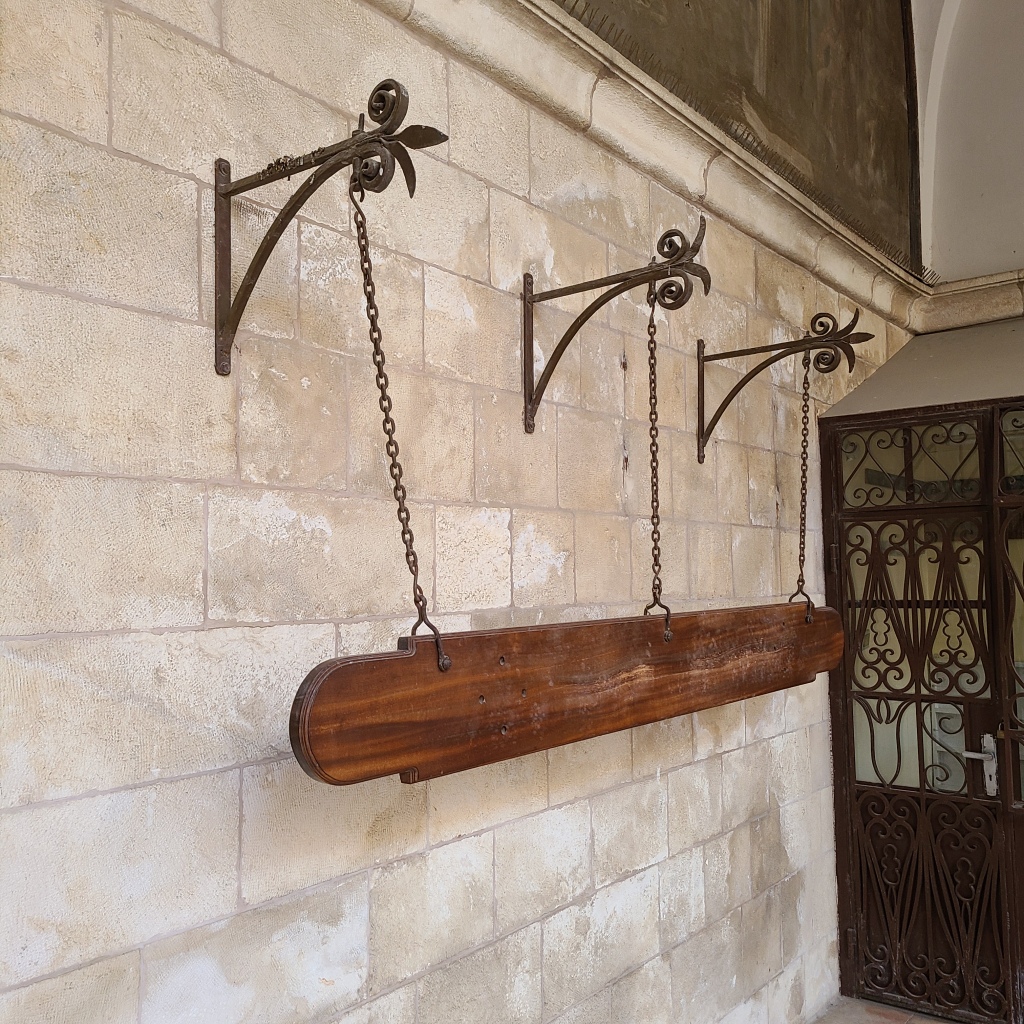
After visiting the Church of St. James, I walked further south towards Mount Zion—one of the famous series of large mounts/hills that make up the landscape of Jerusalem. Mount Zion is the traditional location of the Cenacle—the building which contained the “Upper Room” where Jesus held the Last Supper and First Eucharist, where Jesus appeared to the disciples after His Resurrection, and where the Holy Spirit descended upon the Apostles on Pentecost (GPS Coordinates: 31°46’18.50″N, 35°13’44.30″E).
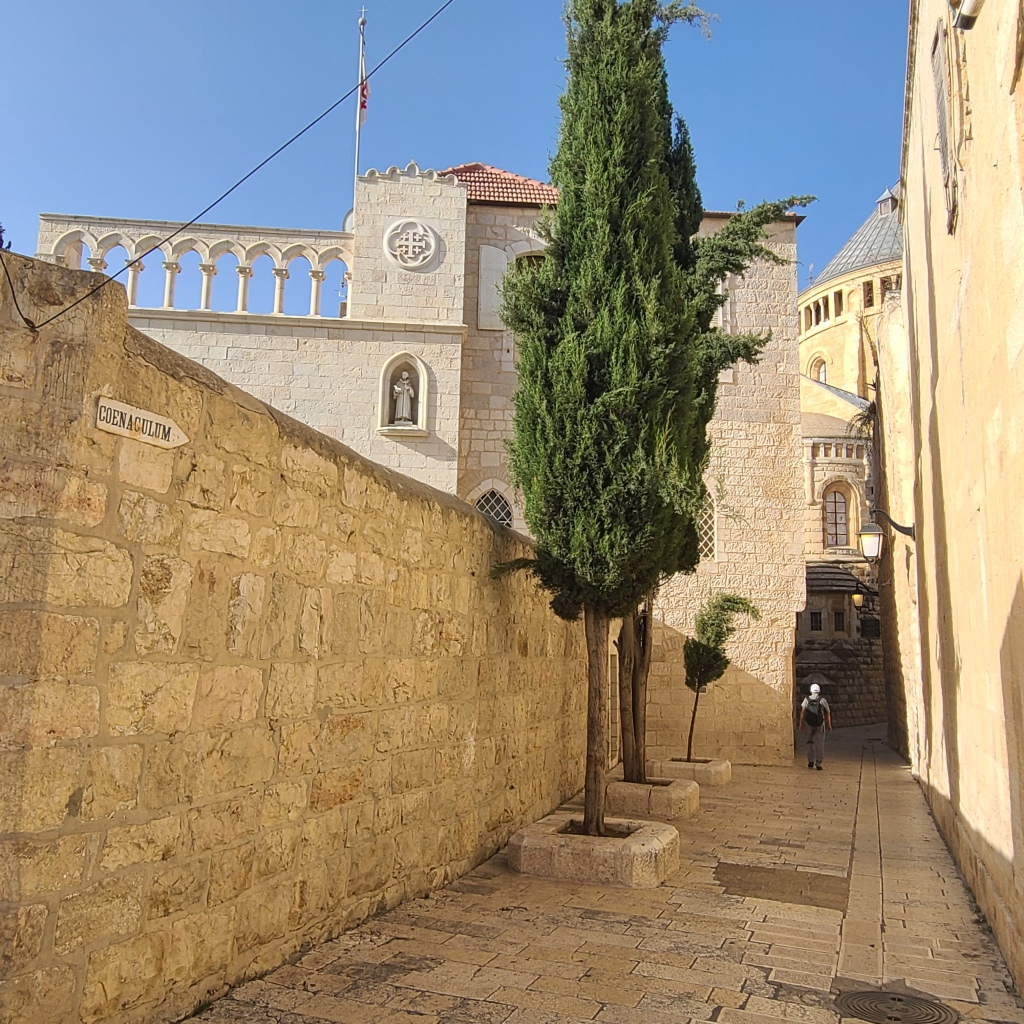
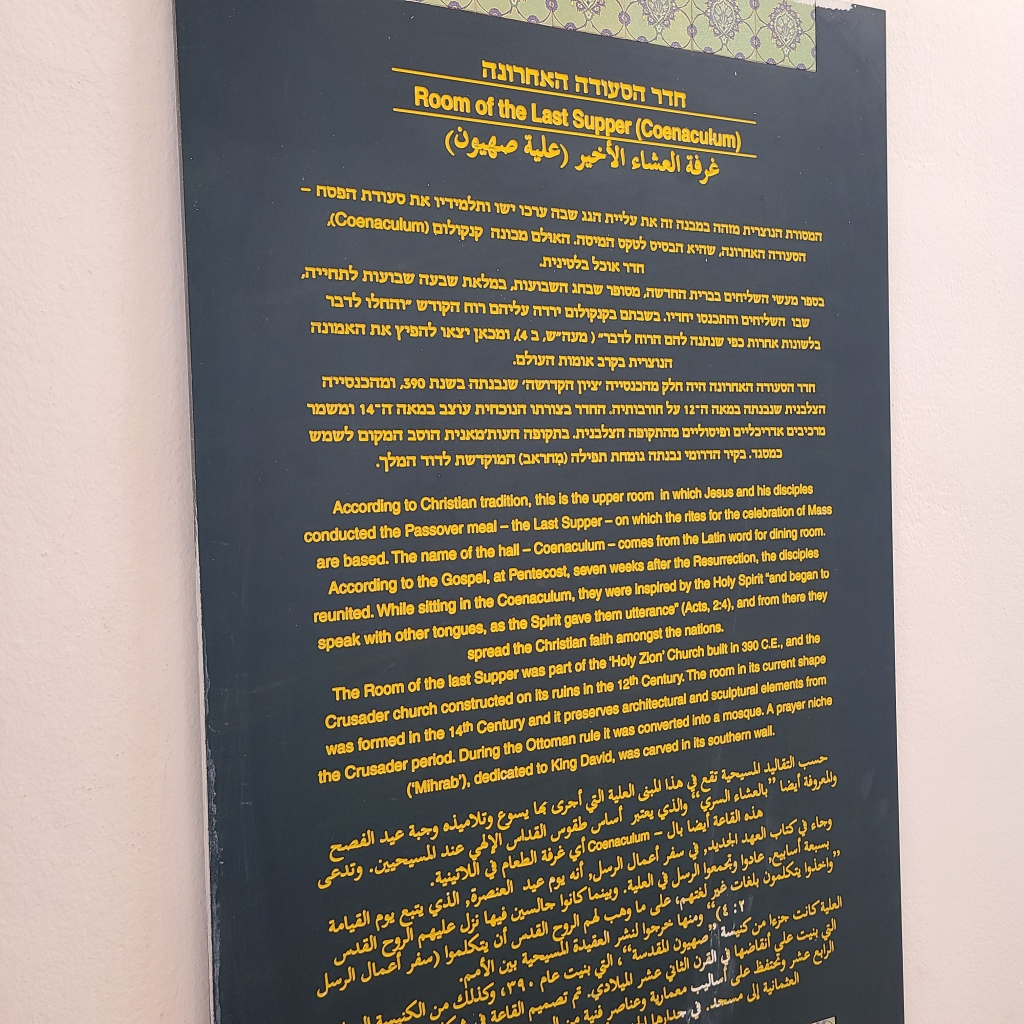
Although the original house containing the upper room was destroyed over the centuries, the Franciscans rebuilt a structure on the site that stands to this day. It is a very interesting structure because the building itself is actually a holy site for Jews, Muslims, and Christians! Jews occupy the lower level of the building due to a tradition that the Tomb of King David once stood on Mount Zion. On this lower level, there is a cenotaph (an artificial, empty memorial tomb) commemorating King David which serves as a synagogue for the Jewish faithful. The upper floor of the building which contains the space where the original Upper Room of Jesus’s time once existed was appropriated by the Muslims in 1524 and converted into the “Mosque of the Prophet David” and remains so to this day. However, Christians are permitted to visit the site, and Pope Francis even was allowed by the Muslims to celebrate Mass here on the Feast of Pentecost on May 26, 2014.
Pope Francis sums up the significance of this room better than I’ve ever heard anyone else:
“How much love and goodness has flowed from the Upper Room! How much charity has gone forth from here, like a river from its source, beginning as a stream and then expanding and becoming a great torrent.
All the saints drew from this source; and hence the great river of the Church’s holiness continues to flow: from the Heart of Christ, from the Eucharist and from the Holy Spirit.“
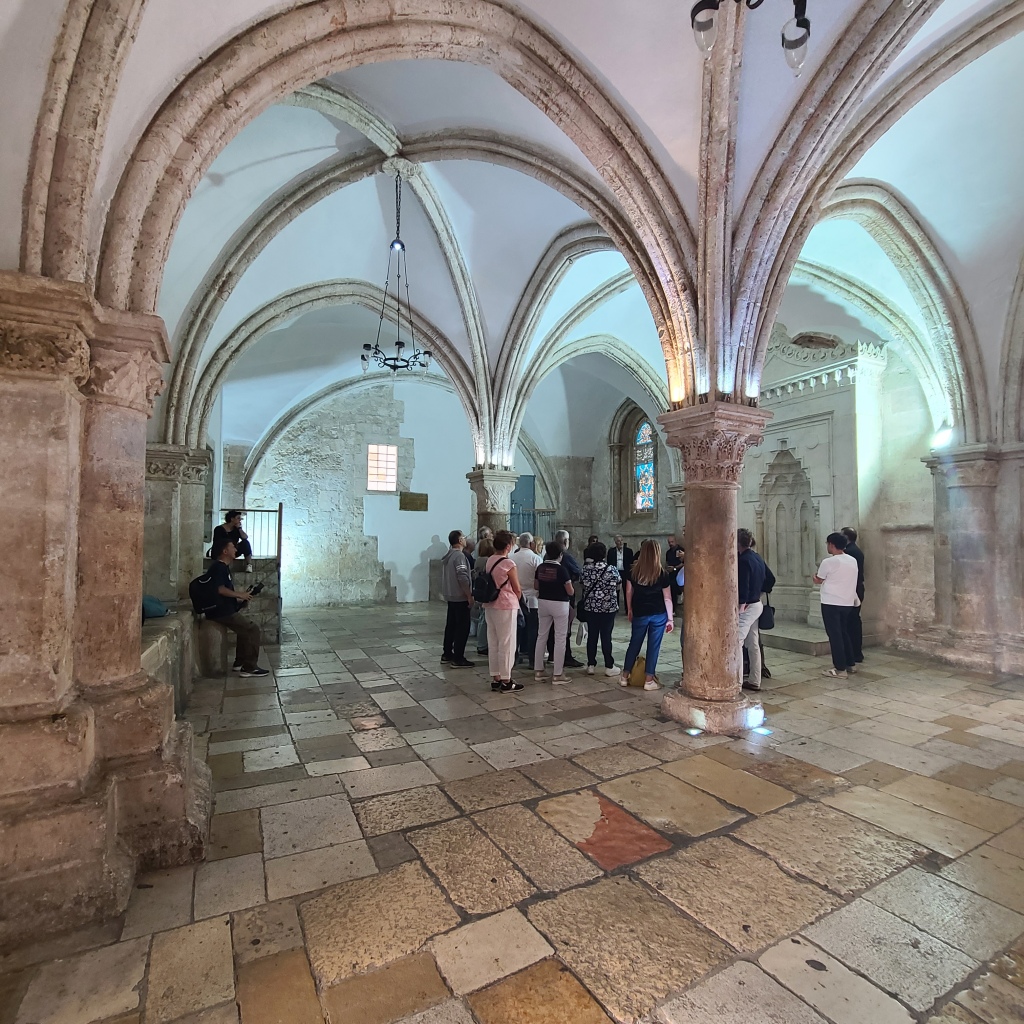
The east wall of the Cenacle contains the oldest remaining building materials of the whole structure. The dating of the large stone blocks nearest the wall’s foundation is conflicting, but these blocks are either part of an early Jewish-Christian Synagogue Church or a part of the grand Byzantine Church that once stood on this site. As I gazed at this historic, holy building and its ancient wall, I imagined the rush of wind and the tongues of fire cascading from the sky and traveling down through the very space above the building I was looking at. I thought about the confused sound of the Apostles speaking in different languages, and a crowd of foreigners gathering where I was currently standing, questioning how Galilean fishermen could be glorifying the Lord in languages that should have been unfamiliar to them. I meditated about the 3,000 people, many of whom probably came to this place out of curiosity, who welcomed the Apostles’ words into their hearts. In so doing, they allowed themselves to be so malleable to the Holy Spirit they couldn’t refrain from wanting to be baptized immediately! The Church was born where my unworthy self was now standing. Come, Holy Spirit!
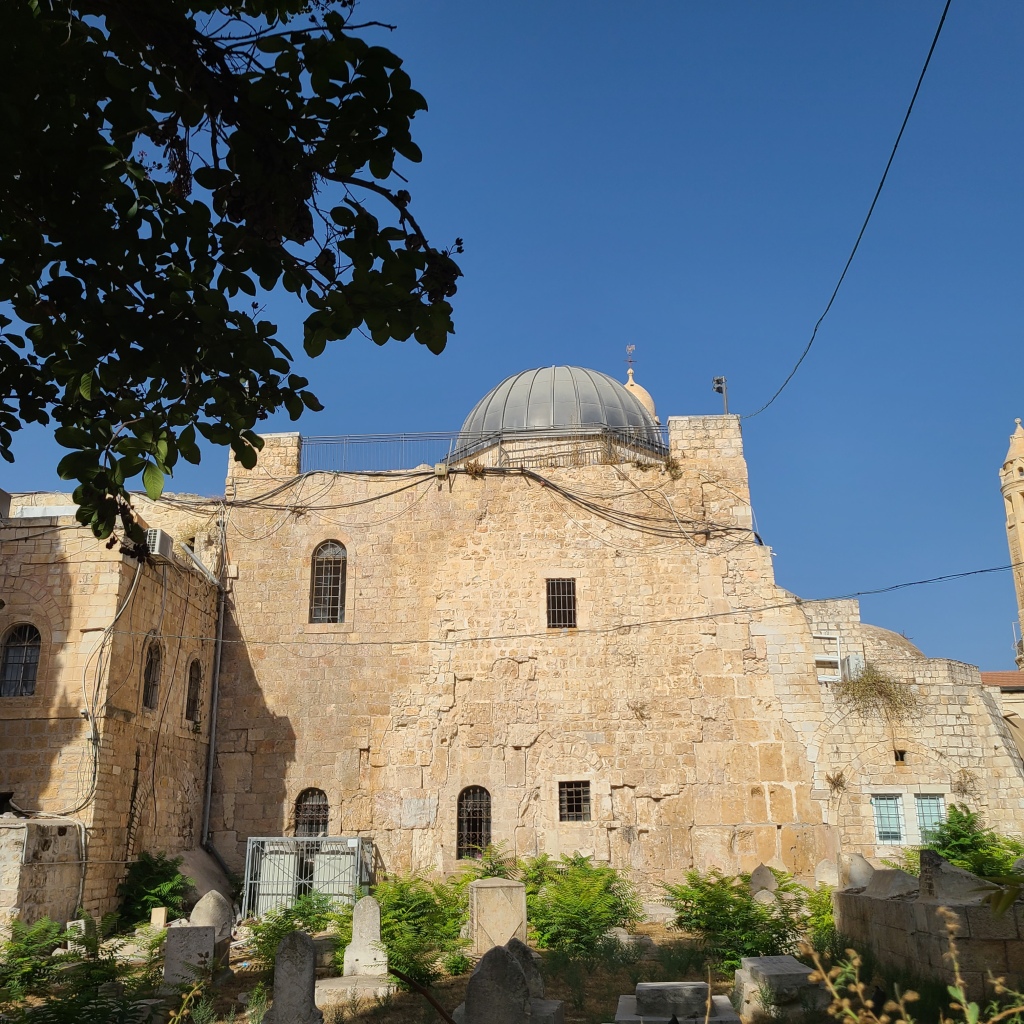
After visiting the Cenacle, I started walking down the southern slope of Mount Zion and entered a Roman Catholic cemetery here. It is in this cemetery where one of the most courageous and famous friends of the Jewish people has his final resting place: Oskar Schindler, the real-life subject of the movie Schindler’s List (GPS Coordinates: 31°46’12.5″N, 35°13’49.4″E). Schindler was a German businessman who is credited with saving the lives of 1,200 Jews during the Holocaust by employing them in his enamelware and ammunition factories in occupied Poland and the Protectorate of Bohemia and Moravia.
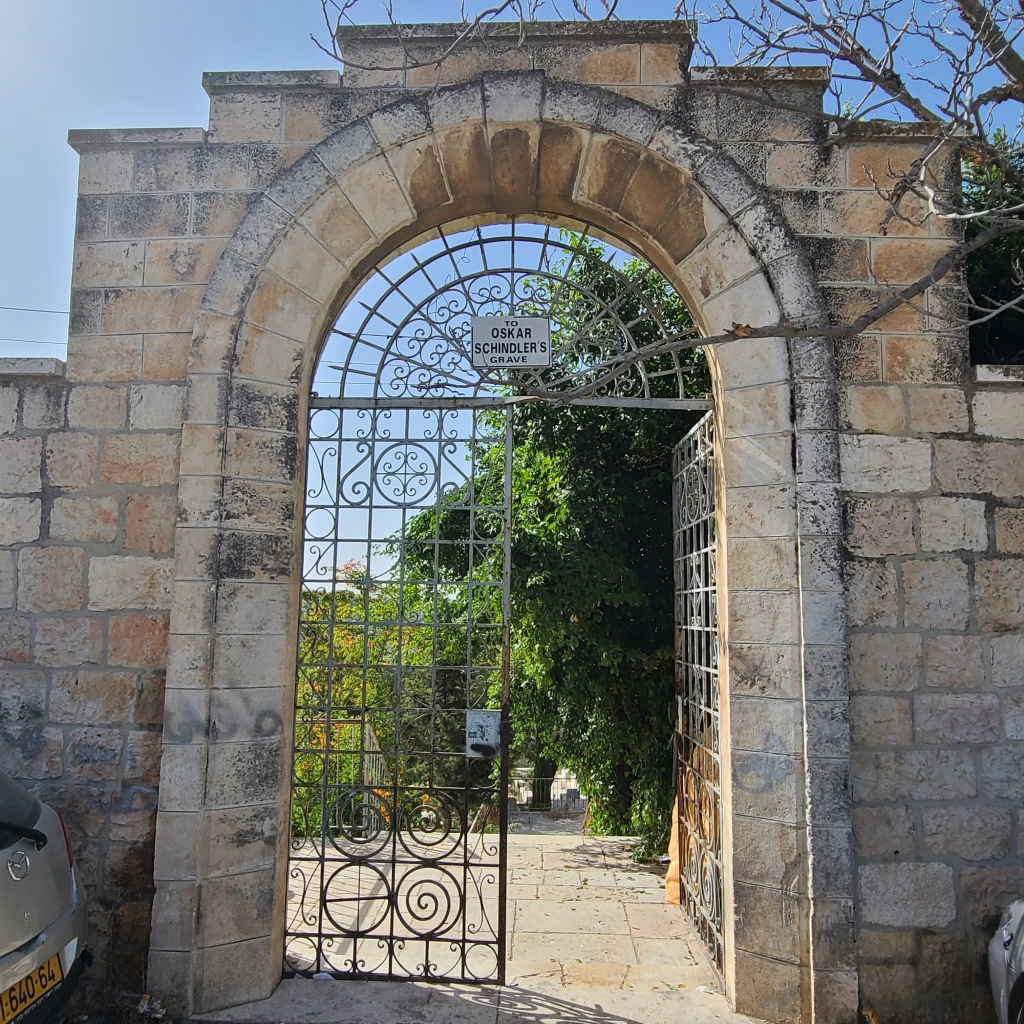
His grave was covered in small rocks left by visitors as a “thank you” for the reckless love he showed for fellow human beings at a time when, despicably, hate was valued and championed.
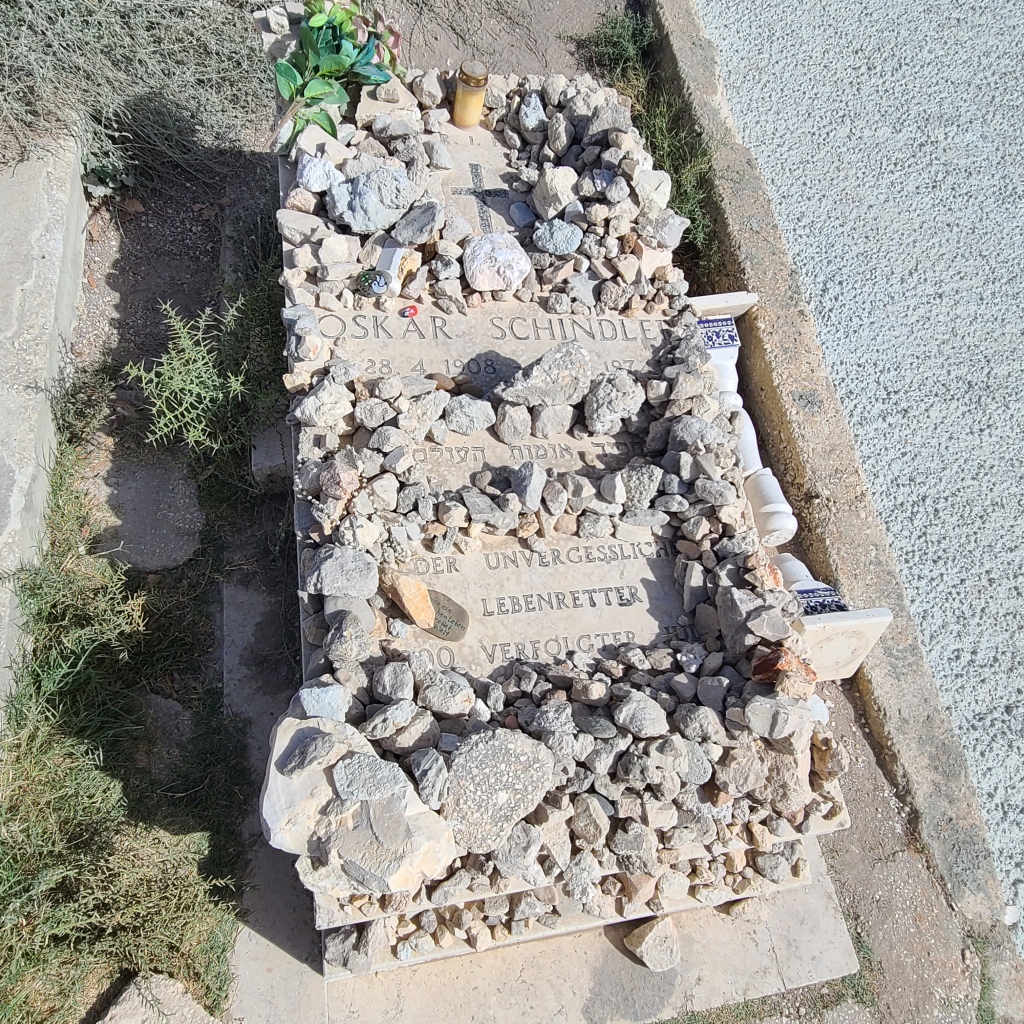
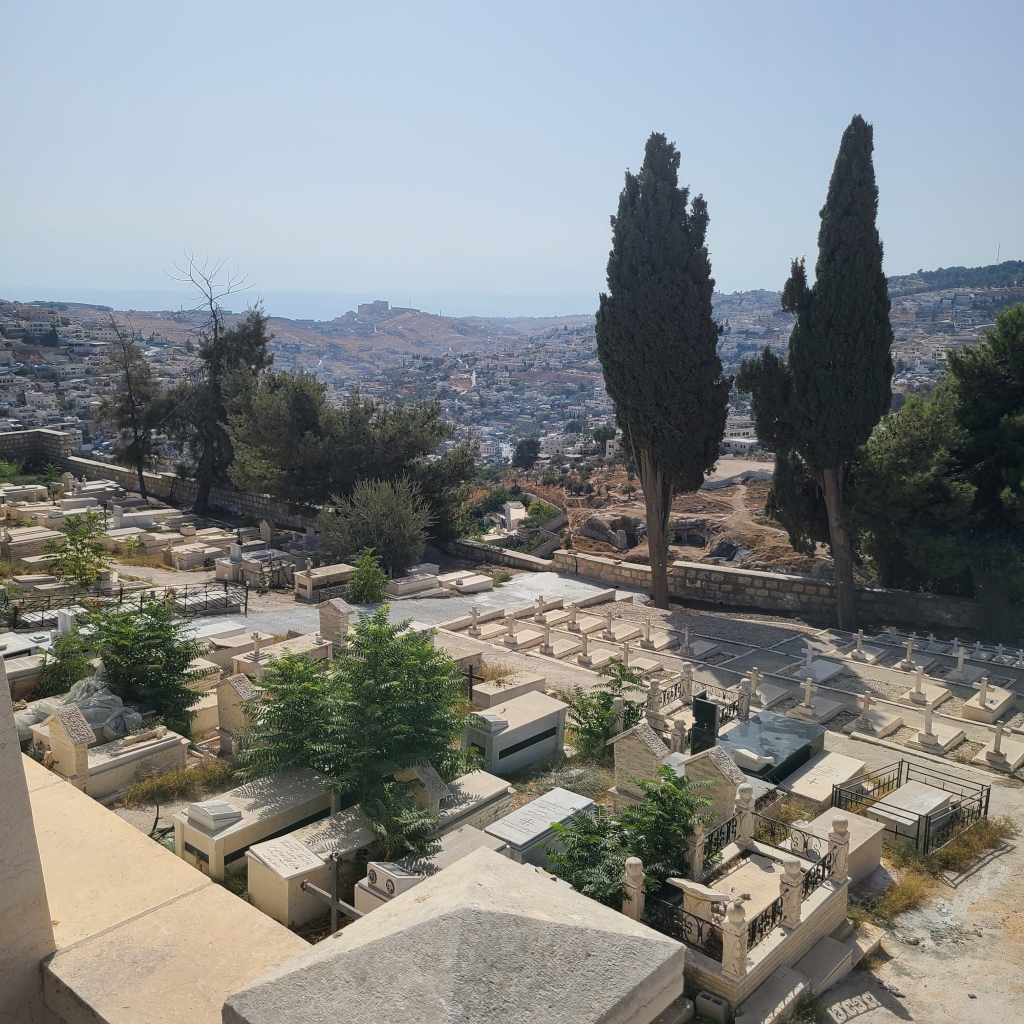
From here, I walked to the Old City of Jerusalem’s southern wall. As I walked eastwards along the wall, I found an area that had been excavated by archaeologists from the University of North Carolina at Chapel Hill. The excavations at this site revealed the remains of an ancient dry moat that had once existed along the southern wall of the city to prevent siege towers from being wheeled up to the city walls. During the siege of Jerusalem by the First Crusaders in the Summer of 1099, it has been said one of the crusader princes leading the siege offered to pay a coin for each rock a soldier were to place into the moat to fill it, braving arrows shot from the city walls by Muslim Defenders (GPS Coordinates: 31°46’22″N, 35°13’51″E). This excavation finally concretely identified the trench, validating the historical account of the siege. Additionally, at this site, golden jewelry (perhaps plunder?) and Crusader pendant crosses were found as further evidence of the brutal siege that took place outside the Holy City’s walls.
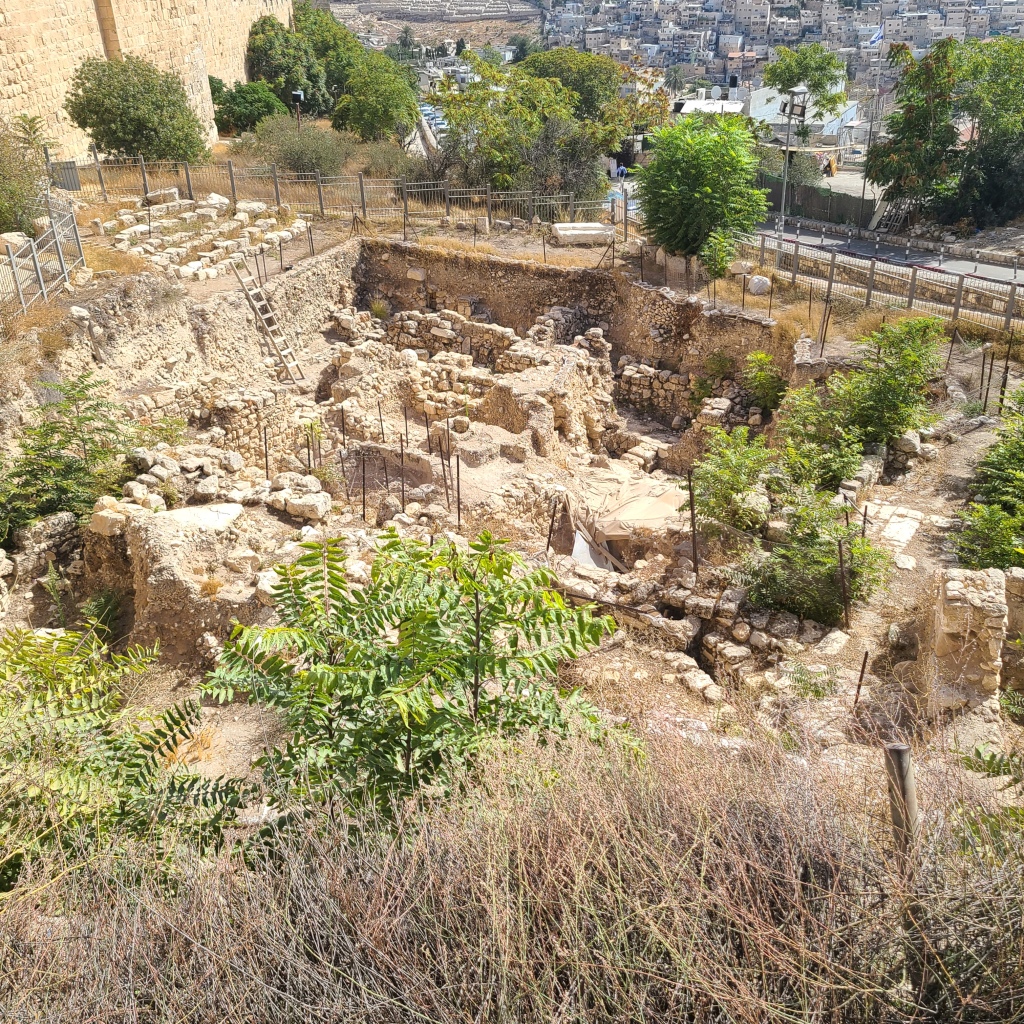
From here, I took a right and started walking down a steep, but long road. On either side were many parked cars and Middle Eastern homes. To my left was the ancient area known as “The City of David.” (GPS Coordinates: 31°46’23″N, 35°14’07″E). Although outside the current walls of the Old City of Jerusalem, this area was the location of the city of Jerusalem when King David was ruler 1,000 years before Jesus was born–i.e. it’s even older than the current “Old City” of Jerusalem! The area is now mostly covered with modern houses, however. It was amazing to think that *the* King David could have composed his Psalms in this very place.
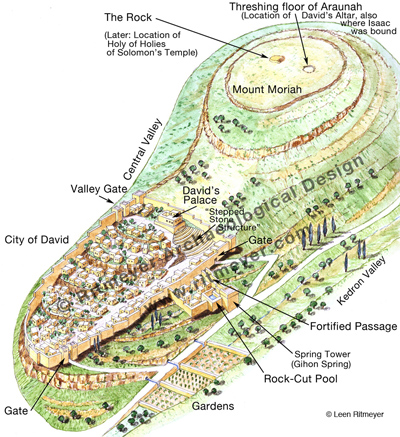
This was not what I was on my way to see, however. Instead, I was tracing what may have been the very path the blind man of John 9 stumbled along, with mud coating his eyes, towards the Pool of Siloam to wash.
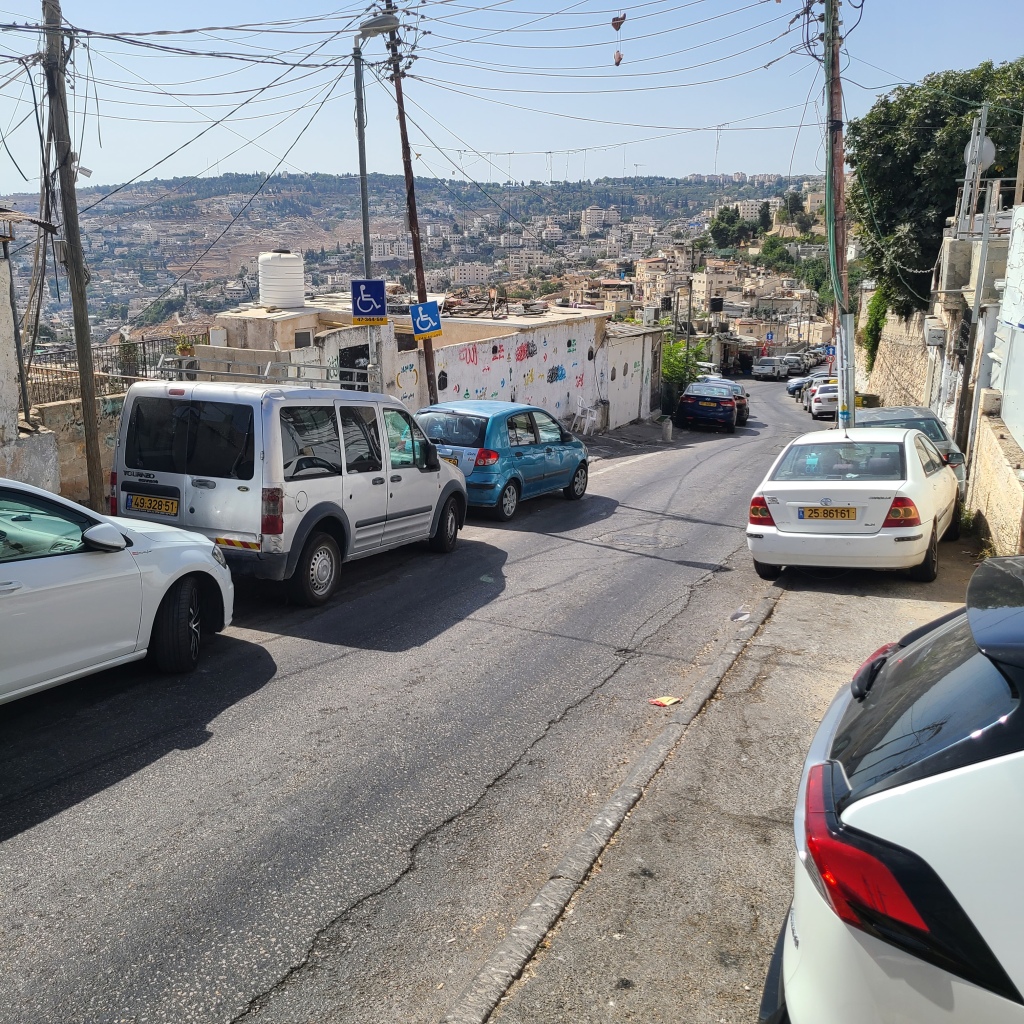
The site of the Pool of Siloam has a very interesting history. King Hezekiah in c. 700 B.C. had commissioned workmen to cut an impressive tunnel through solid rock to channel water from a natural spring south of the Temple Mount area in the Kidron Valley (known as the Gihon Spring) south to Siloam. This channel would provide the City of Jerusalem at the time (i.e. the City of David) a supply of water (a very precious commodity in the arid land of Israel) within its walls that could be relied upon even during a siege of the city. That the water from the spring was “sent” by the underground channel to the pool at the end of the channel is where the Pool of Siloam gets its name: “Siloam” means “sent” in English. Ironically, Jesus *sent* the blind man to the pool!

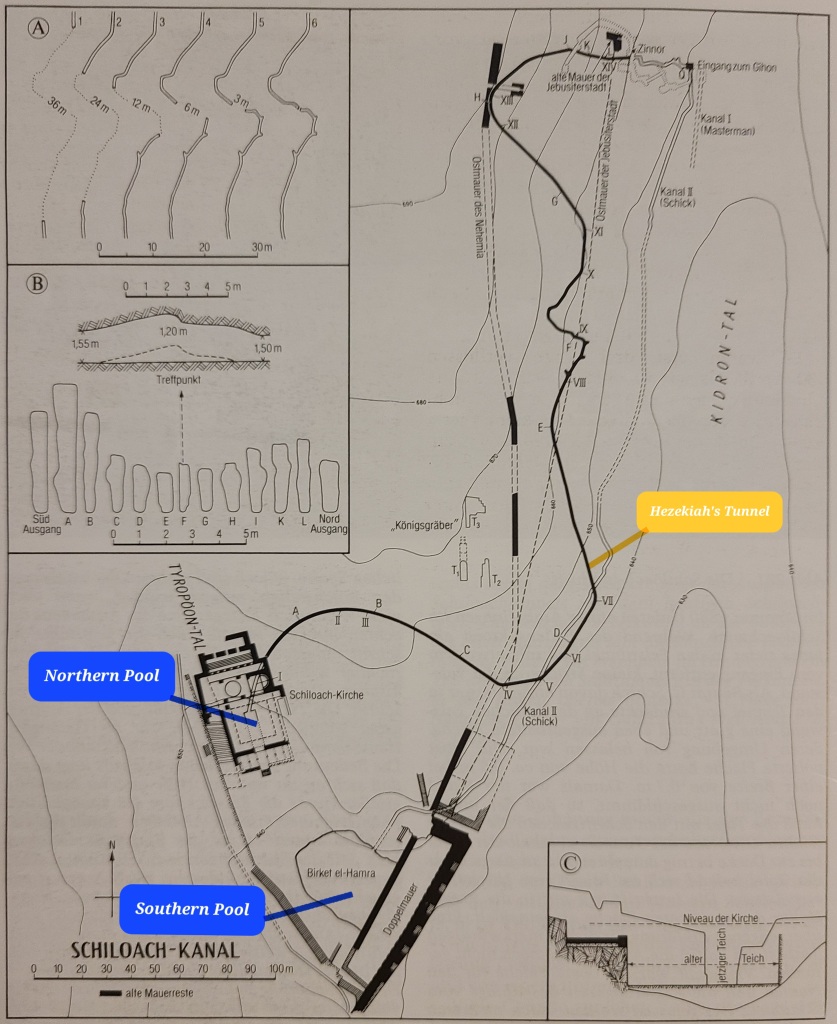
Today, a small pool that catches the water as it leaves Hezekiah’s Tunnel can still be visited. This is the traditional Pool of Siloam that has been a Christian pilgrimage destination for hundreds of years (GPS Coordinates: 31°46’15.06″N, 35°14’4.30″E). Excavations by British archaeologists F. J. Bliss and A. D. Dickie from 1894-1897 in Siloam actually revealed the remains of a long-lost Byzantine Basilica immediately north of and perched ~10 meters vertically above the pool below. This church was built in around A.D. 450 and commemorated the miracle which took place at Siloam. The presence of the church at this spot seems to indicate the pool here was where the blind man washed his eyes and regained his sight.
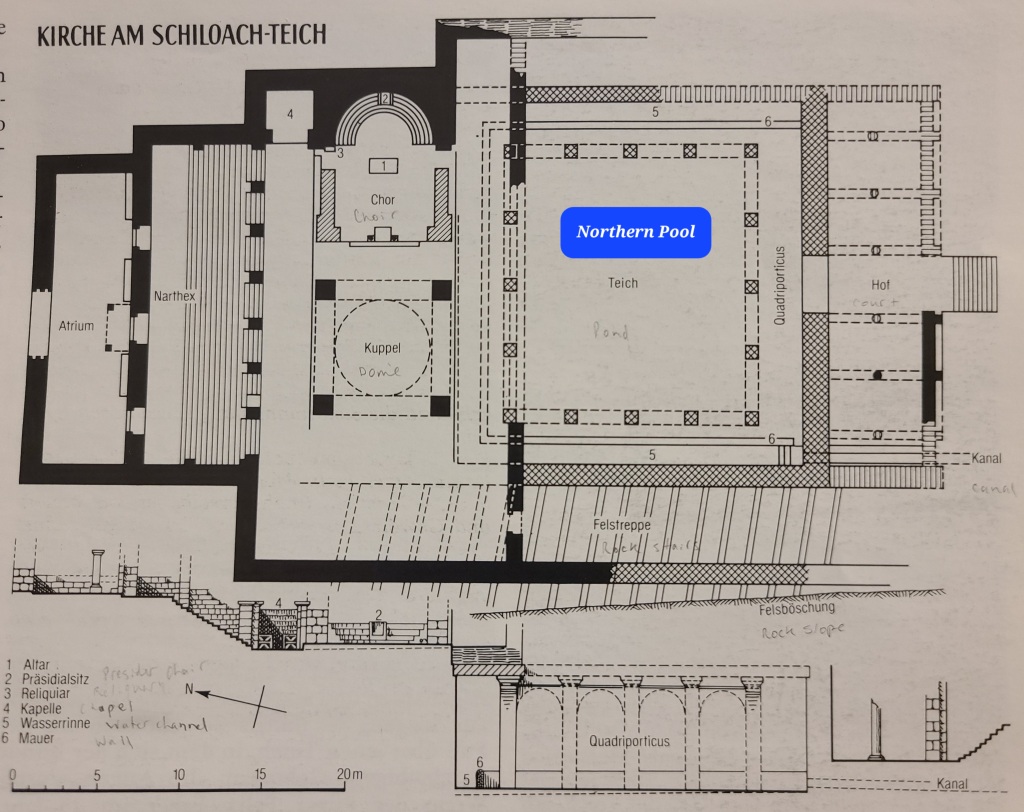
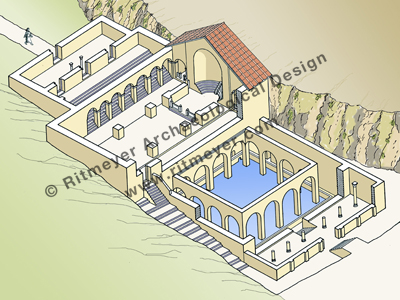
However, in 2004, major headlines were made around the world about the discovery of the “First Century” Pool of Siloam–a pool different than the traditional pool and about 20 meters further south (GPS Coordinates: 31°46’13.46″N, 35°14’6.41″E). During a public works project, workers had stumbled upon the remains of this very large, stepped pool which, upon examination, archaeologists could reliably claim would have been in use in the First Century. In some form, this “southern pool” would likely have been fed by the same water channeled to the area by King Hezekiah’s tunnel. The archaeologists who excavated this pool think it may have been a large mikvah–a pool used by Jews to wash themselves to become ritually clean via bodily immersion in water (i.e. “ablution”). Since the pool was at the southern end of Jerusalem, Jewish pilgrims traveling up to the Temple could wash before ascending an impressive, stepped road north to their destination.
Swept up in the furor of this new discovery, many archaeologists and other experts worldwide have since declared this pool the actual site of the miracle–the real Pool of Siloam.
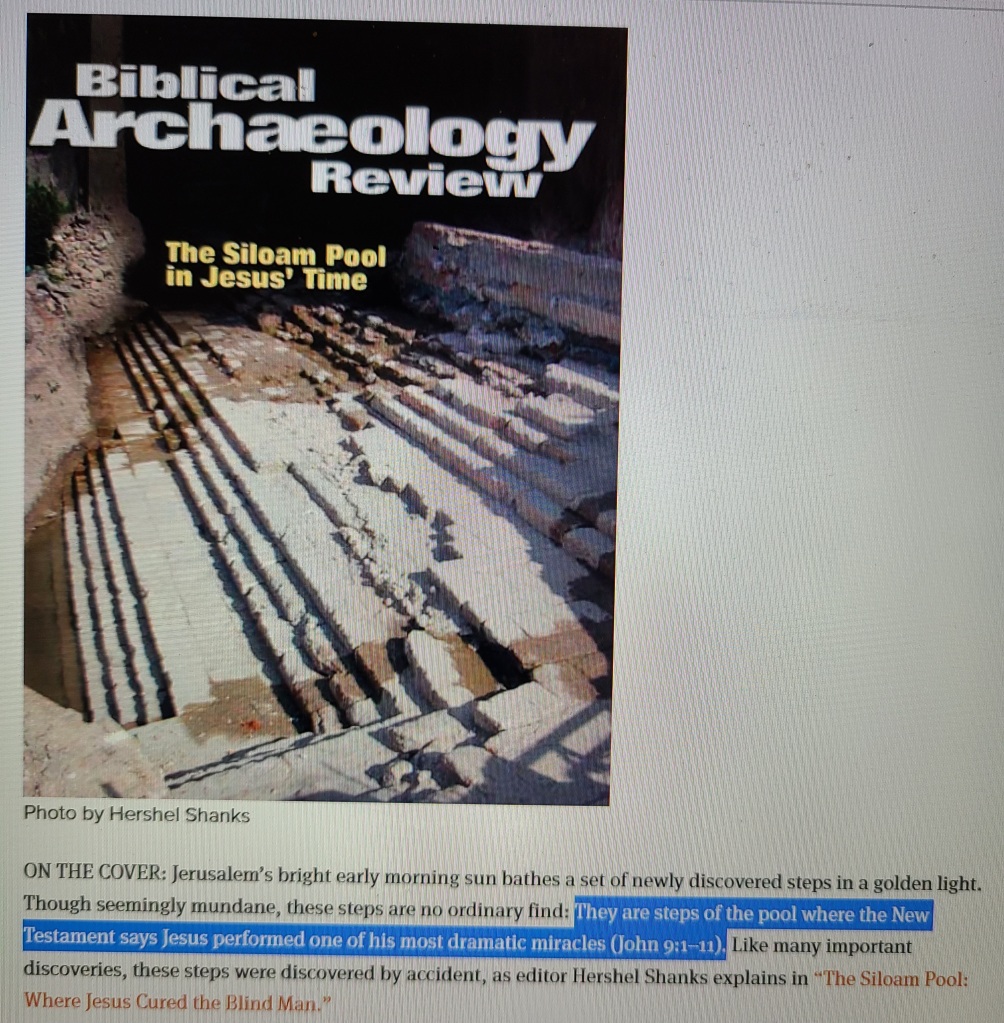
The discovery of the southern pool has even made some to question whether or not a pool existed at all in Jesus’s time at the site of the traditional Pool of Siloam (the “northern pool”).
Despite the discovery of the southern pool, Leen and Kathleen Ritmeyer, a famous archaeologist couple who specialize in creating images depicting what ancient Biblical structures and settlements may have actually looked like based on archaeology and history, included the northern pool in his drawing of First Century Jerusalem and included it in his book on First Century Jerusalem published in 2015 (Jerusalem in the Year 30 A.D.). They even created an image of what they thought the pool structure may have looked like in Jesus’s time (see photos). Prior to this visit to Jerusalem, I believed the existence of both the northern pool and the southern pool during Jesus’s time was generally accepted.


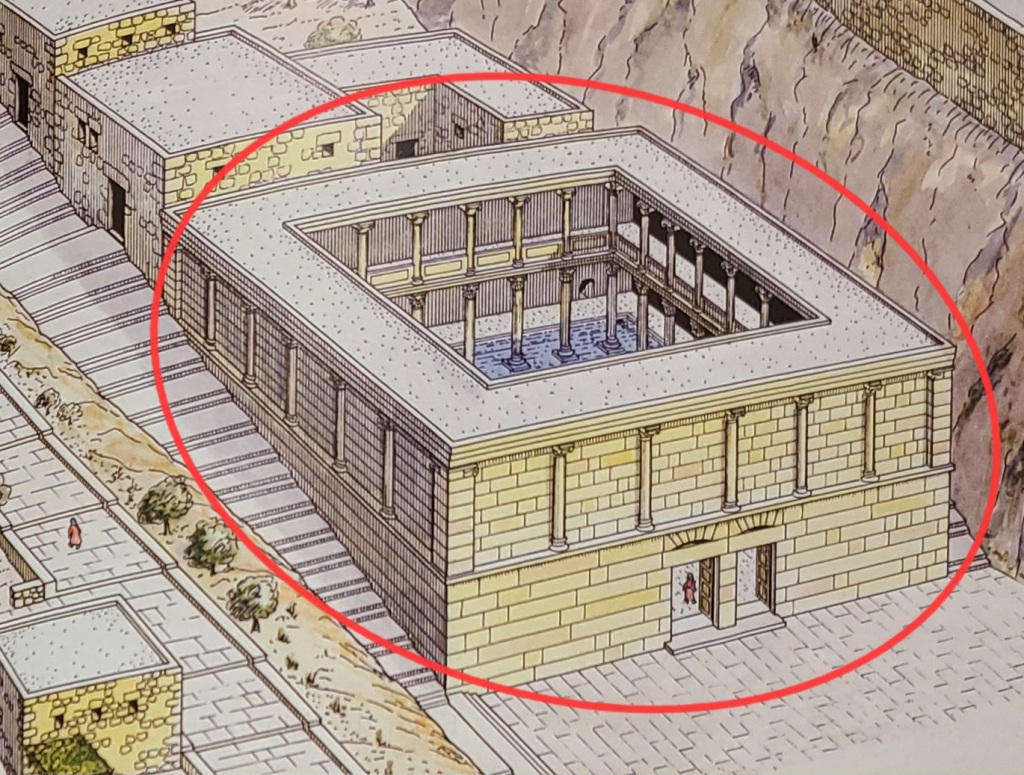
Other artists had also, at unspecific times, included a structure around the northern pool in their depictions of First Century Jerusalem (see photos below).
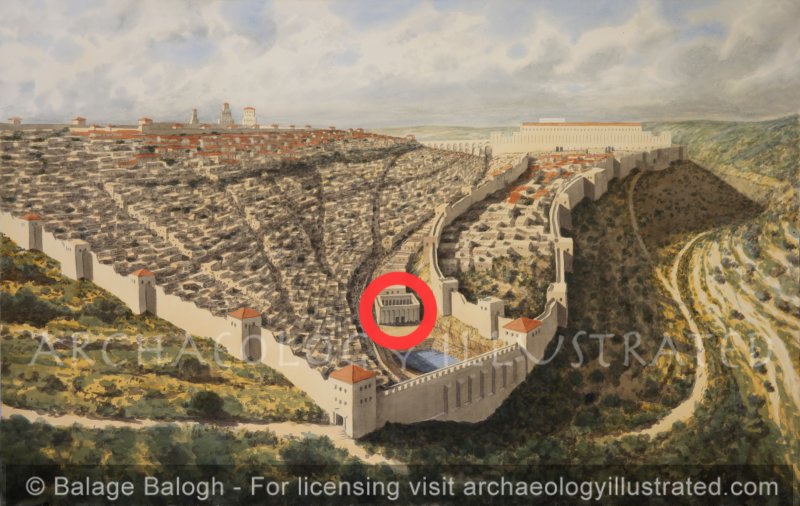
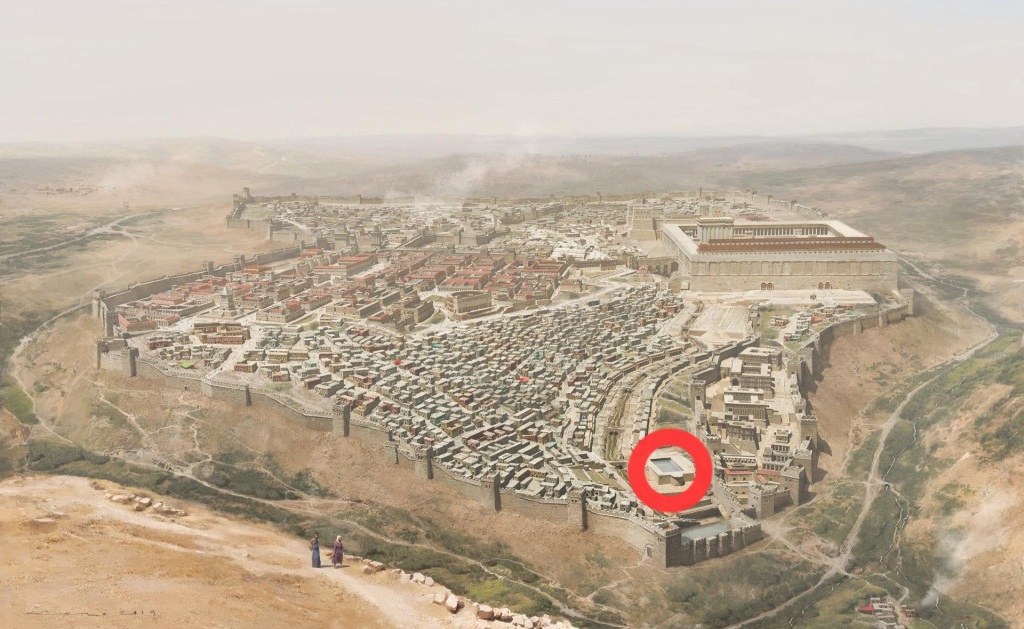
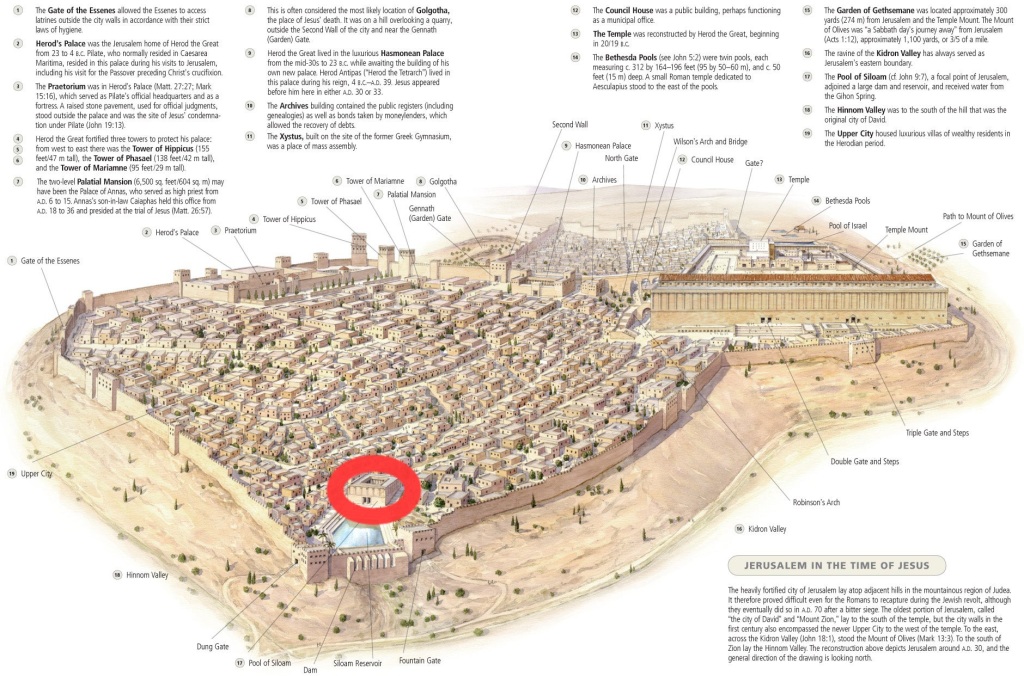
However, when I visited Siloam on my trip, I saw a large sign posted there with an artist’s rendering of the area of Siloam during Jesus’s time, and there was NO northern pool at all…just stairs and a covered portico! I was shocked by this…
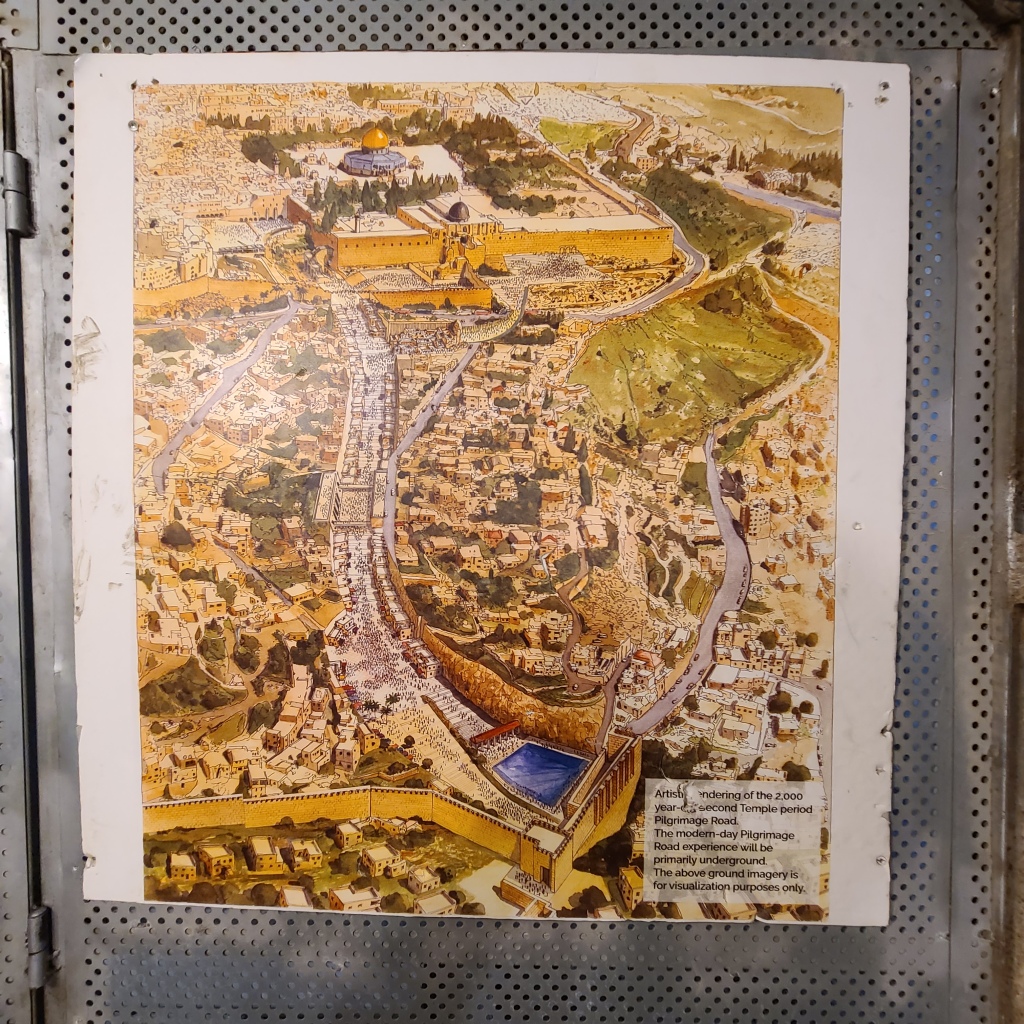
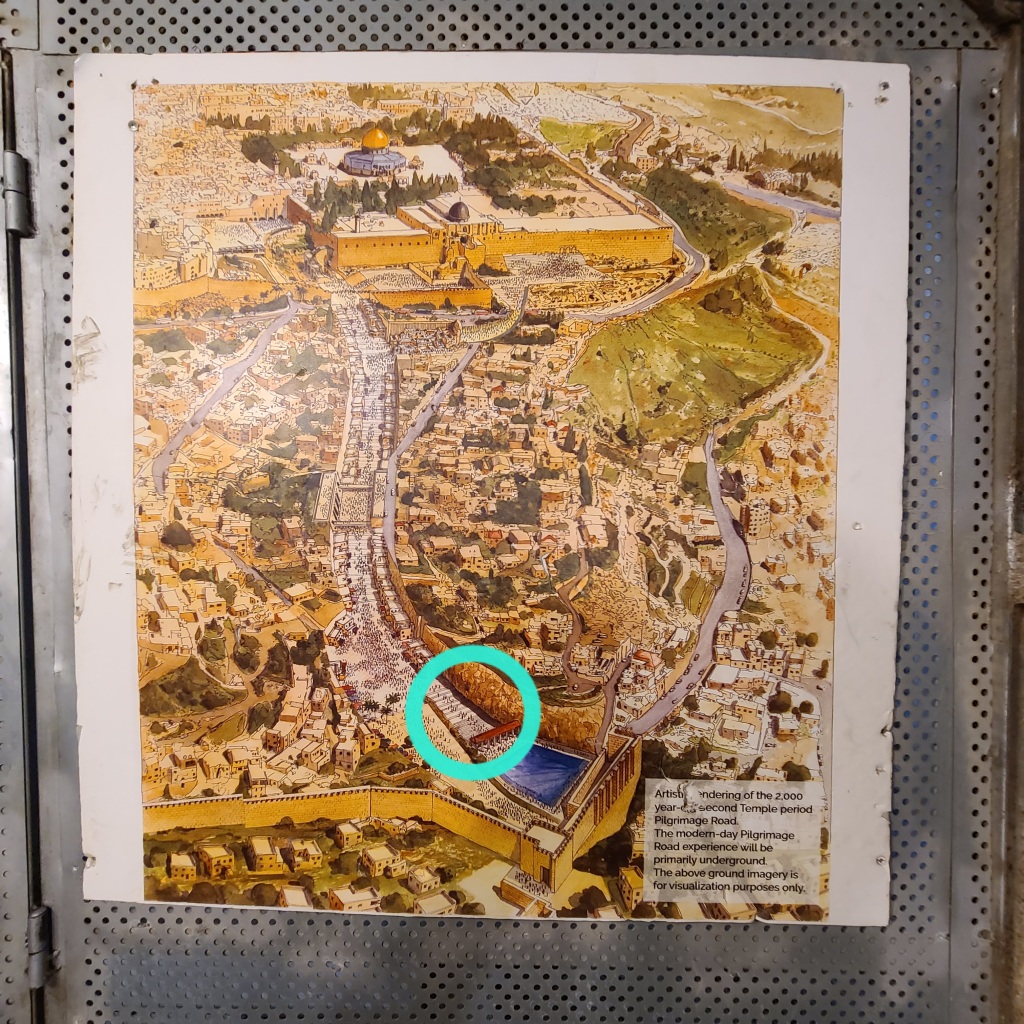
In December 2022, when Israel announced they would be excavating the rest of the southern pool that still lay covered with earth, they showed another artist’s rendering of what the area would have looked like in what appears to be the First Century (see below), and again–NO northern pool!…
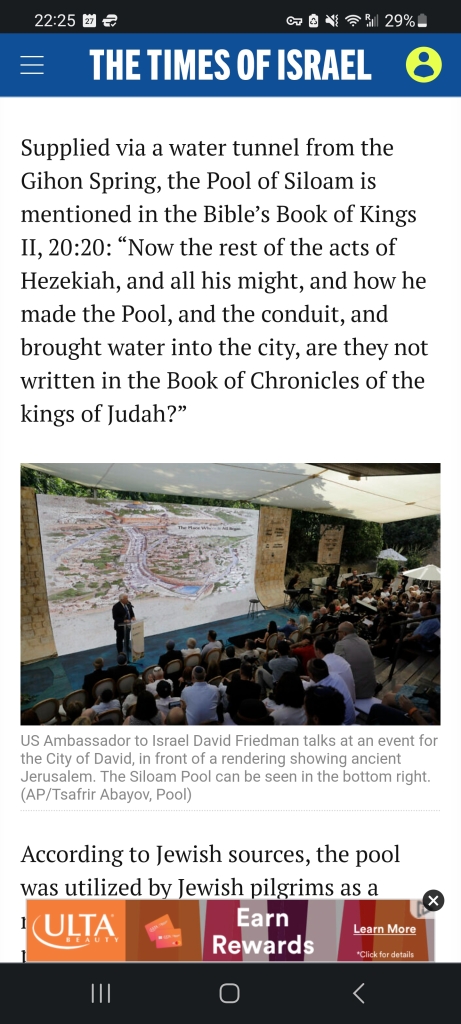
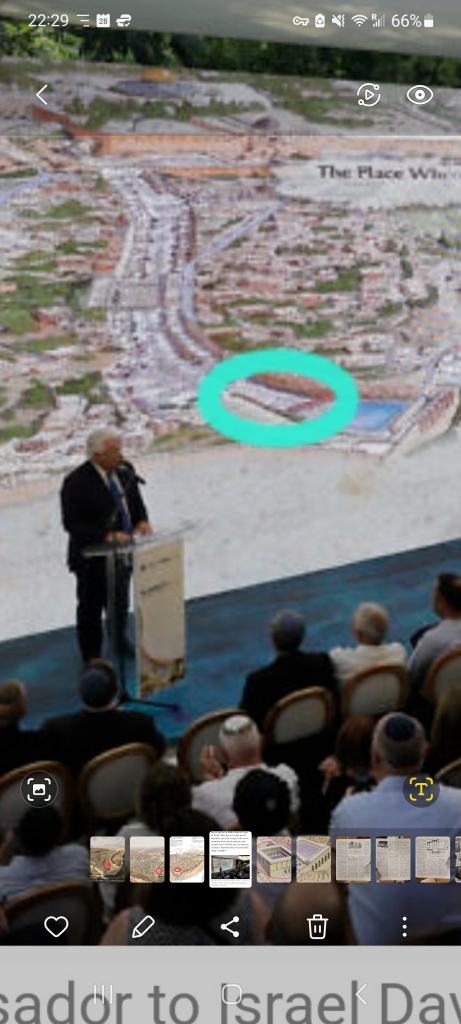
Was there or wasn’t there a pool at the current site of the traditional Pool of Siloam (the northern pool) at the time of Jesus? Had the ancient Christians of the past gotten it wrong and put a church on the wrong spot?
Based on scripture, archaeological evidence, history, tradition, scholarly opinions, and practical considerations for the blind man, I think:
1) that a pool at the site of the traditional Pool of Siloam ALSO existed north of the newly discovered First Century southern pool at the time of Jesus, and it may have included a basin(s)/channel(s) for drawing drinking water and a larger basin for ritual immersions, and
2) that the blind man washed at the northern pool instead of the larger, newly-discovered southern pool.
First, concerning the existence of a pool at the site of the traditional Pool of Siloam in the time of Christ:
There is good cause for the existence of a pool at the outlet of Hezekiah’s Tunnel. This pool at Siloam is referenced in Isaiah 22: 8-11 when Isaiah’s oracle directed to King Hezekiah mentions the King “collected the water of the lower (southern) pool.” This references Hezekiah’s construction of his tunnel referred to earlier. His tunnel re-routed the water which had once flowed from the Gihon Spring via a channel outside Jerusalem’s walls into the southern pool, into a new pool (the northern pool) where the water could be “collected.” The water would have been collected in a pool–this indicates the northern pool would have been constructed at the same time as Hezekiah’s Tunnel in the late 700s B.C. Furthermore, The Second Book of Kings 20:20 ascribes the construction of the tunnel (conduit) and “the Pool” to King Hezekiah: “Now the rest of the acts of Hezekiah, and all his might, and how he made the Pool, and the conduit, and brought water into the city, are they not written in the Book of Chronicles of the kings of Judah?”
Also, additional evidence of the existence of Hezekiah’s pool (the northern pool) and information concerning its precise location comes to us via archaeology. An ancient Hebrew dedicatory inscription dating to when the tunnel was finished and discovered near the opening of the tunnel into the Pool of Siloam records that water from the source flowed 1,200 cubits into “the pool.” This distance equals 1,800 feet which equates most precisely to the distance from the Gihon Spring to the traditional Pool of Siloam (the northern pool), not the southern pool which is farther away. Furthermore, it makes sense to me that the inscription would be close to the outlet of the tunnel at the time of its completion to mark the location of the fulfillment of the project (moving water to *that* location for people’s easy access).
Fast forwarding to the late First Century A.D., in his description of Jerusalem’s walls, the famous Jewish historian, Josephus, refers to a “fountain/spring of Siloam” (see The Wars of the Jews, Bk V, Ch 4 & Ch 9) That this fountain would be the place where the water left Hezekiah’s Tunnel is reasonable. Dr. Urban Von Wahlde, a professor from Loyola University, concurs that the “fountain” Josephus refers to is the northern pool and not the southern pool in his superb review of all the evidence in the April 2006 edition of the French scholarly journal, Revue Biblique.
According to the Mishnah, a collection of Jewish oral traditions from the Second Temple Period (i.e. during Jesus’s time) collated together in the early A.D. 200s, during the Jewish Feast of Tabernacles, a ritual known as “the Feast of the Water Drawing” was carried out by the Jewish priests (ref. Mishnah, Sukkah 4:9). This ritual involved drawing water from the Pool of Siloam in a golden pitcher, taking it up to the Temple, and offering it as a water libation (sacrifice) to God. Because of the importance of this water libation (ref. the golden pitcher, requiring it be collected some distance from the Temple, and it being offered to the Almighty Himself), it seems reasonable the drawing of this water anywhere other than directly where it came out of the tunnel and could be considered its “purest” would be unacceptable. This points to the existence of a pool directly at the end of Hezekiah’s Tunnel.
Next, having established there is good cause for a pool being at the place of the traditional site of the Pool of Siloam at the time of Jesus, let us now turn our attention to the reasons why the traditional site is the more likely place where the blind man’s sight was actually restored.
Ancient Christian sources identify a quadriportico existed in Siloam after the destruction of the Temple.
The (anonymous) Pilgrim of Bordeaux who visited Jerusalem in A.D. 333 mentions this structure (covering the northern pool) and also mentions a second pool outside (probably the southern pool):
“As you leave Jerusalem (from the Temple area) to climb Sion (traveling west), you see down in the valley on your left, beside the wall, the pool called Siloam. It has four porticoes and a second pool outside.” (from John Wilkinson’s translation of Egeria’s Travels, which also includes a translation of the Pilgrim of Bordeaux’s account).
Also, a Greek chronicle of world history written in the early 600s called the Chronicon Pascale mentions the Roman Emperor Hadrian, who reigned from A.D. 117 to 138, ordered a quadriportico be constructed in Jerusalem in honor of the Nymphs (mythological, fairy-like beings some of whom pagans believed lived in/near sources of water). It just so happens that the previously mentioned British Archaeologists Bliss and Dickie discovered the remains of what must have been Hadrian’s quadriportico around the traditional site of the Pool of Siloam (the northern pool).
The identification of Hadrian’s quadriportico at the spot of the traditional Pool of Siloam actually adds further weight to this site being the actual spot of the blind man’s healing, vice the southern pool. Hadrian had little tolerance for any rebellious “messianism” in Israel. Other than crushing dissent against Roman rule through force, as he did to Jewish rebels during the Bar Kokhbah Revolt (c. 132 – 136), another one of the ways Hadrian and his Romans further attempted to tamp down any potential uprisings was to convert Jewish and Christian holy places into pagan shrines. After the Bar Kokhbah Revolt, this was a tactic Hadrian used numerous times. Pagan shrines were constructed over Christ’s Tomb, Golgotha, Christ’s Birthplace, Mamre (where the 3 angels appeared to Abraham), the Temple Mount, Bethesda (where Christ healed the paralytic in John 5), and the Pool of Siloam. Ironically, as Fr. Bargil Pixner mentions, the Romans’ efforts actually ended up backfiring and helped to better mark these locations for veneration by future generations! Although Hadrian’s intentions about why he chose to build the nymphaeum where he did are not specifically mentioned in ancient sources, it seems logical Hadrian built a pagan shrine over this location for reasons similar to the other places.
Concerning the archaeological remains found at the site of the traditional pool, Leen and Kathleen Ritmeyer claim some of the remains found by Bliss and Dickie (and Dr. H. Guthe in 1880) could be dated to the time of Herod the Great and that they have characteristics of a mikvah/purifying pool for ablutions of pilgrims traveling up to the Temple. Additionally, according to Holy Land historian Father Gerhard Kroll, it is likely the roughly hewn rock walls behind the ruins of the quadriportico in the west and north formed the original boundary that the pond of Siloam had before the construction of the quadriportico by Hadrian in around A.D. 135. Archaeology appears to show there was some kind of structure resembling a purification pool at this site.
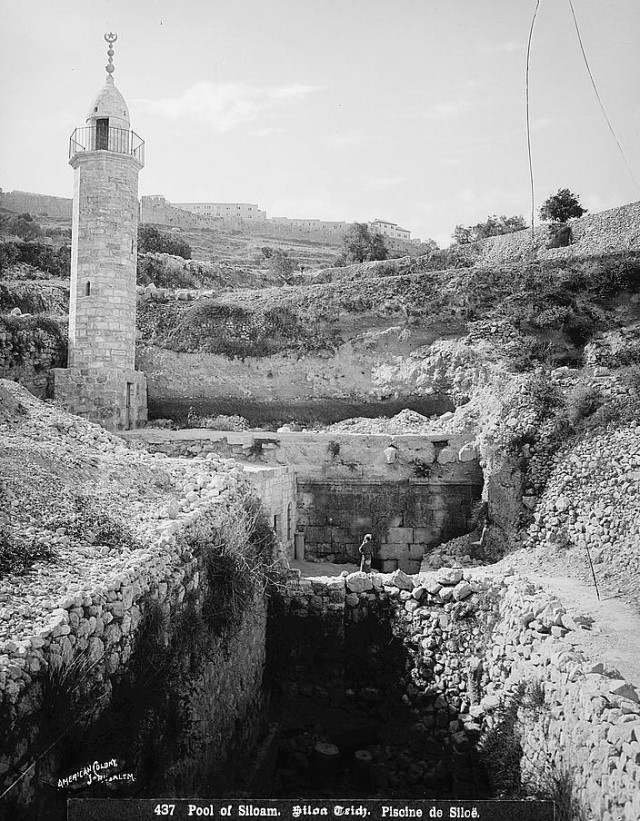
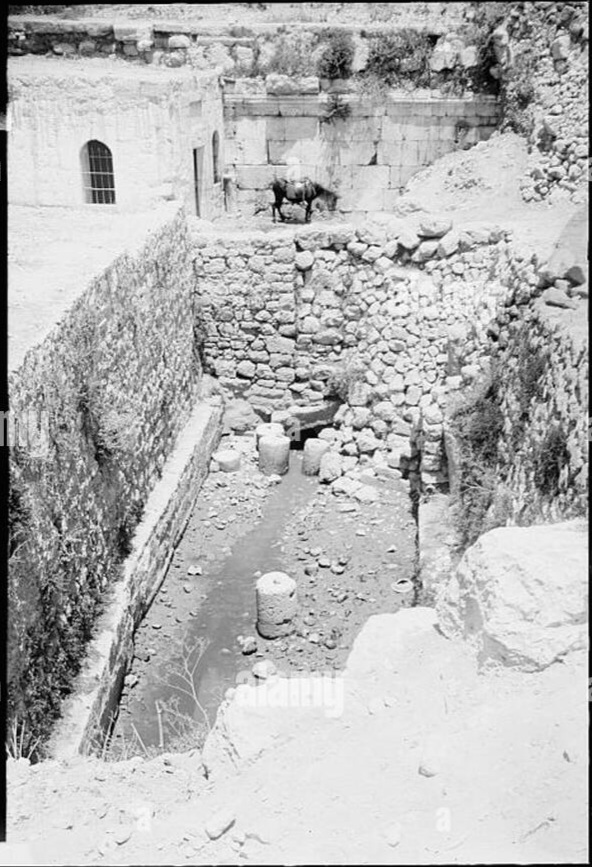
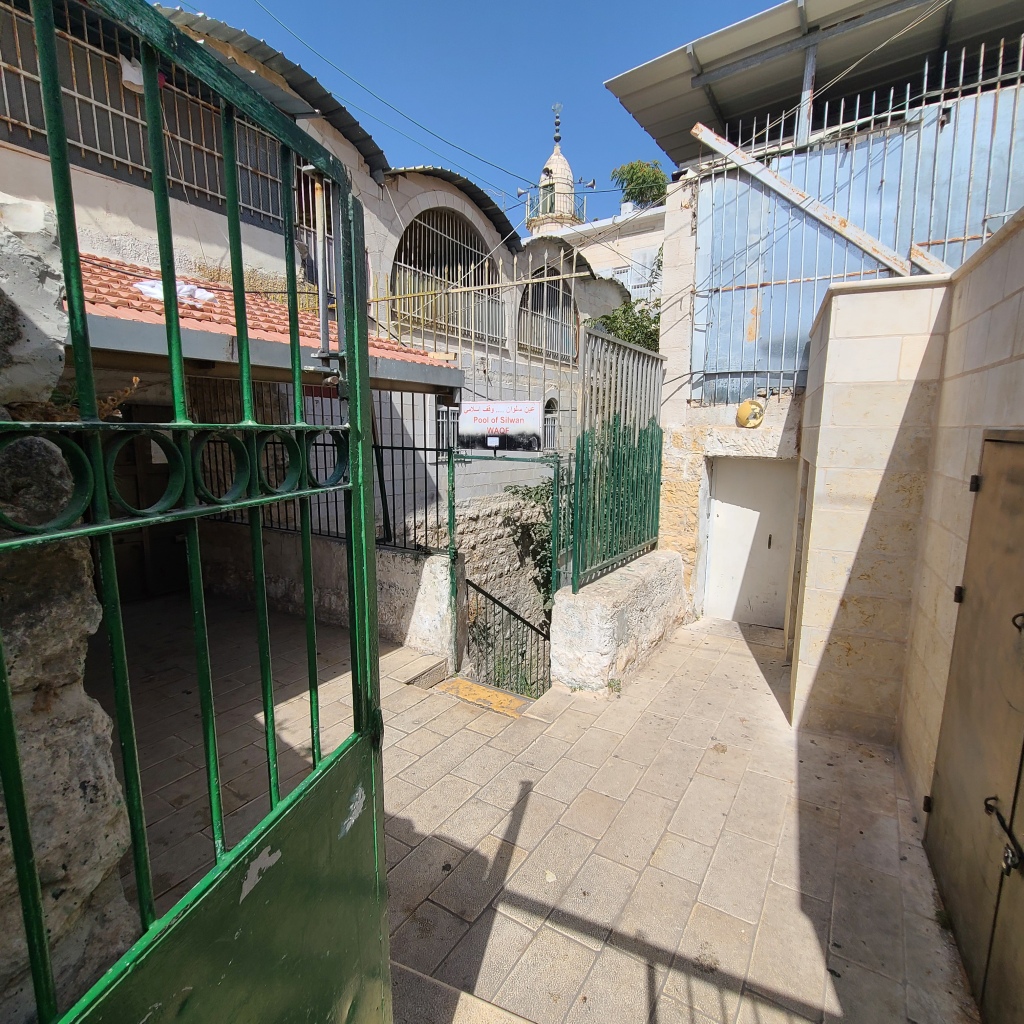
Although some scholars believe the southern pool served a similar function for purifications, according to Dr. Yoel Elitzur in a scholarly article from Palestine Exploration Quarterly in 2008, the southern pool was most likely an ancient public swimming pool, not a ritual immersion pool for pilgrims entering Jerusalem on their way up to the Temple. This is because “such a large pool would present a problem of privacy, because Jewish law requires that one immerse oneself while completely unclothed.” There are no remains of an enclosure at this pool that would allow for privacy. It seems reasonable Jesus and those helping the blind man would want him to wash: 1) with water from a ritual immersion pool, thereby linking his healing to not only physical but also perhaps spiritual renewal, and 2) with the purest water from a pool directly attached to Hezekiah’s Tunnel and linked through holy ritual to the Temple, not water from a large swimming pool.
Practical considerations for the blind man himself also make the northern pool the more likely pool for the healing. Based on the sequence of events in John’s Gospel, it appears Jesus encounters the blind man (known in extra-biblical Christian tradition as “Celidonius”) soon after leaving the Temple at the end of John 8.
(Note: It appears based on the order of events and notes of time in John’s Gospel that Jesus’s encounter with the blind man happened not long after the Feast of Tabernacles in September/October A.D. 32. The drawing of water from the Pool of Siloam with the golden pitcher (mentioned above) would therefore still have been fresh in people’s minds! Jesus may, therefore, have intentionally wanted to link this ritual to the blind man’s healing by directing him to wash at Siloam.)
The Gospel does not give Jesus and the blind man’s relative physical position in relation to the Pool of Siloam, but it can be inferred they met in an area near the Temple and the blind man would have therefore traveled south to access the Pool of Siloam. If the blind man would have traveled southbound along the major stepped pilgrim thoroughfare that connected the Temple and the Siloam area, the first pool in the Siloam area he would have encountered would have been the traditional Pool of Siloam, not the southern pool. I imagine the man would have used the first body of water in the Siloam area he would have come across for expediency, to potentially use a pool with more privacy (see Elitzer), to use fresher water direct from the opening of the canal, and perhaps to use a pool that may have served a purpose for religious ritual purification instead of for leisure.
Those are my thoughts on this “riddle of Siloam”…
If you, my readers, know of any additional substantial evidence either corroborating or challenging my argument on this topic, I would very much appreciate hearing from you–please send me an email at zistezesto@gmail.com to let me know what you found. Thanks!
According to the Times of Israel in December 2022, the southern pool “will be fully excavated in the coming months.” It will be interesting if more light will be shed on this situation over the course of these excavations.
Now, back to my visit to Siloam…
The Siloam area was very pleasant that day. It was hot out, but thankfully the area of the traditional pool was well-shaded. See the photo below of me walking down to the pool.
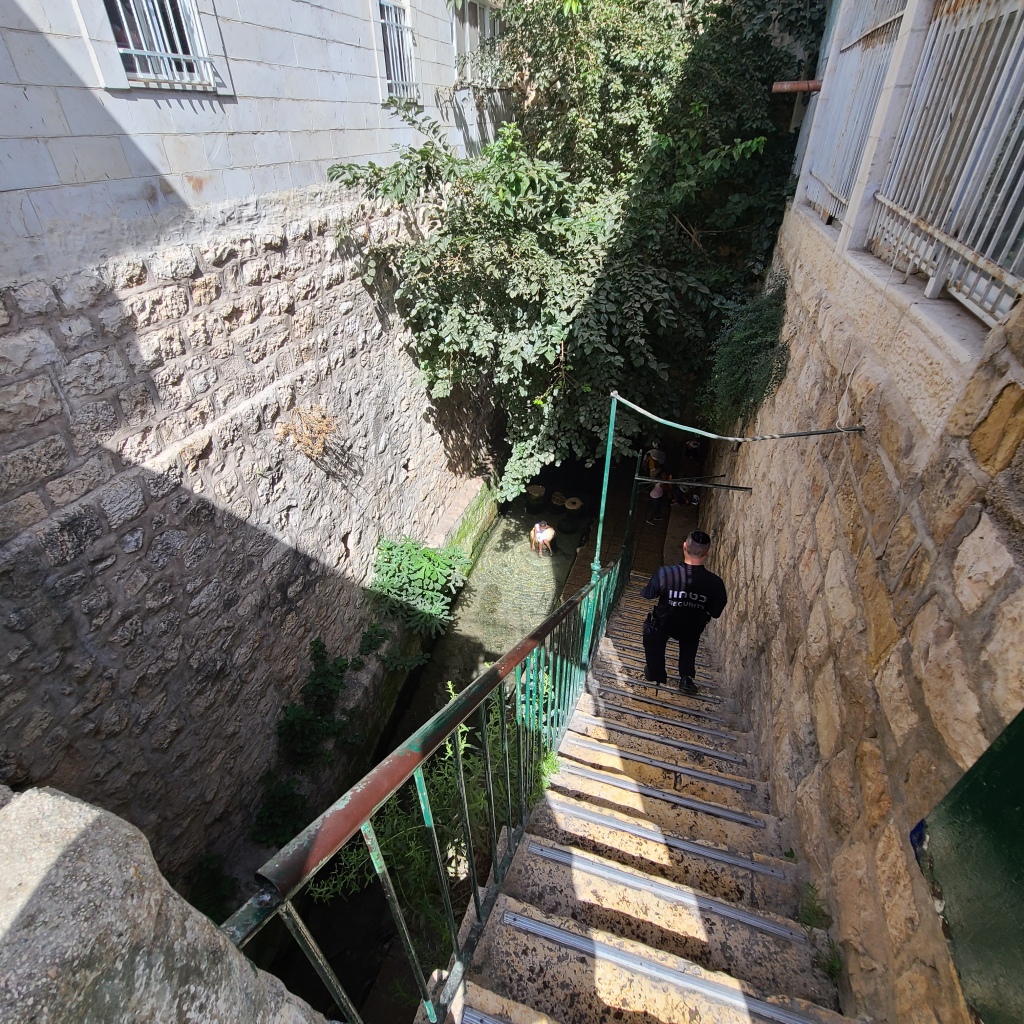
I went down the stairs and took off my shoes so I could step into the Pool of Siloam! The water was flowing southwards out of the tunnel in the picture below. At the pool are fragments of ancient column. From my research, I found the piece of white column on the right of the picture below by the stairs was a part of Hadrian’s quadriportico. The others in the water may have been as well.
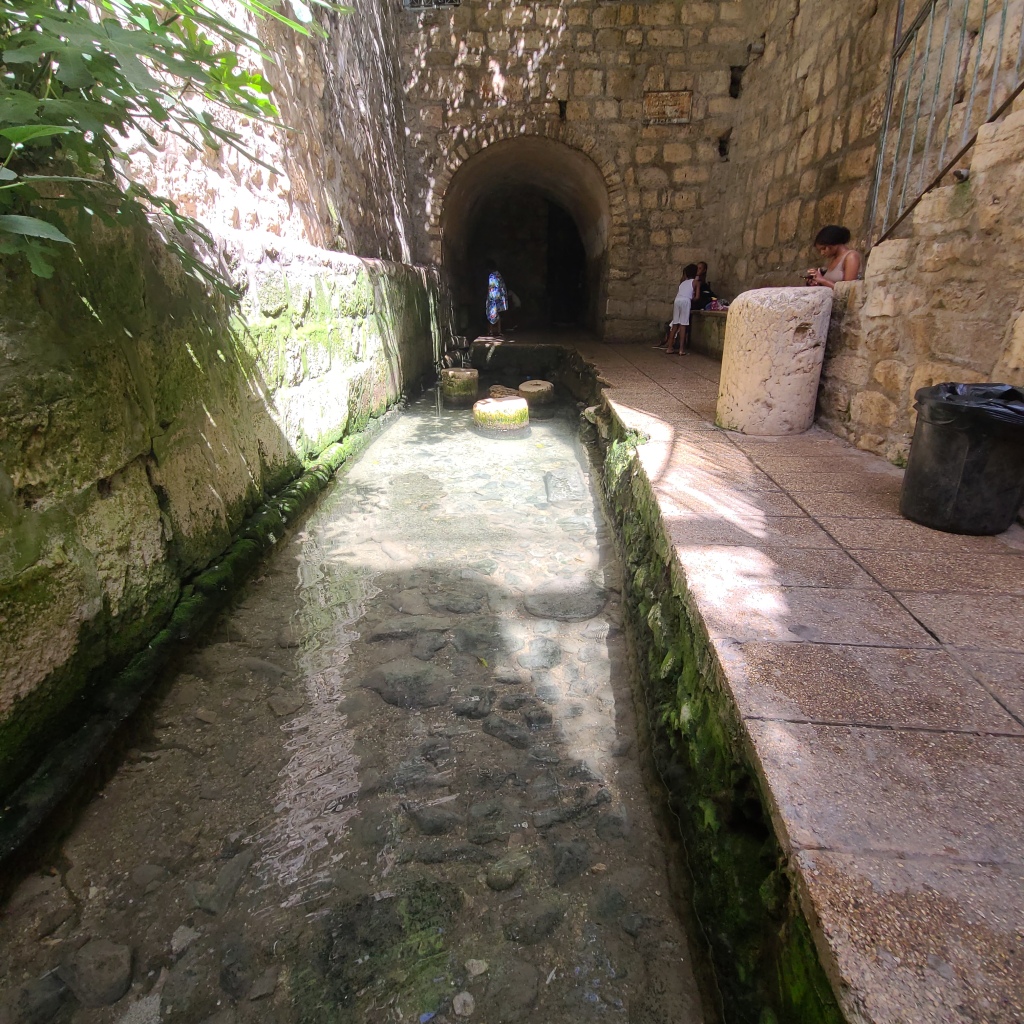
It felt good to step into the water. It was nice and cool–refreshing! And, of course, I couldn’t help but to anoint my eyes with some of the water from the pool as the blind man did. It was an amazing experience and I worked to meditate on the commotion that must have been caused here when the blind man opened his eyes and–for the first time in his life and through God’s grace–saw the world!
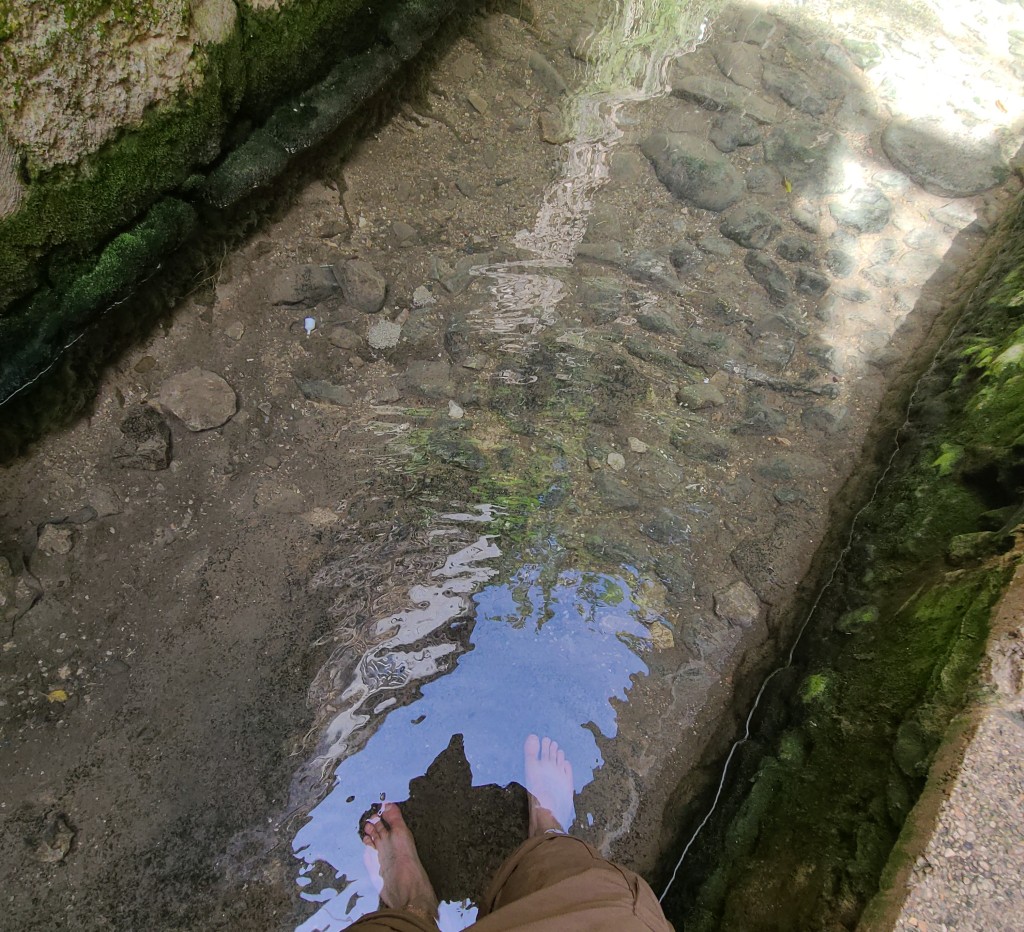
After drying off my feet, and throwing my backpack back on, I walked 20 meters south towards the southern pool. The area has been superbly excavated, marked with signs, and made accessible to visitors. Below is a picture looking down towards the southern pool. The area on the right of this photo (with the wall and, further away, the large trees) is the area that is being newly excavated this year. It will be very interesting to see the results of the excavations.
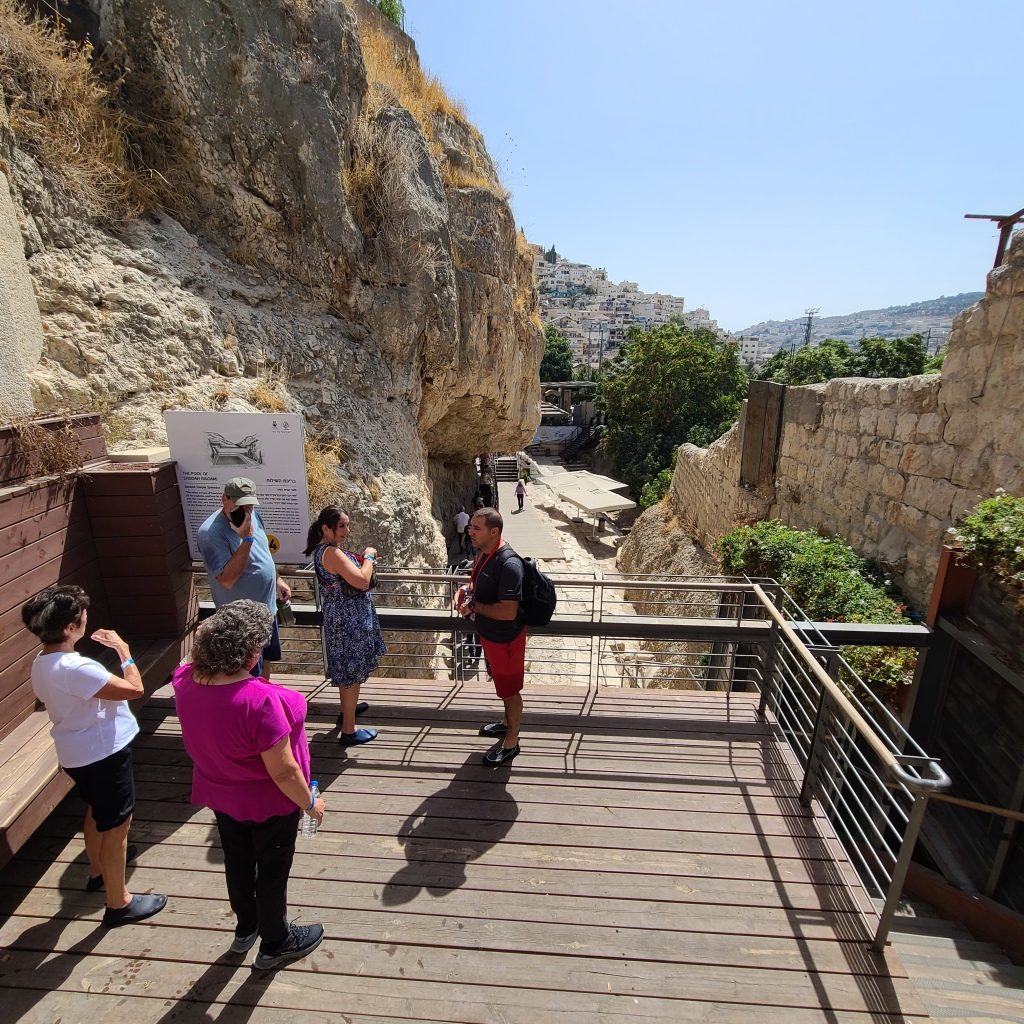
I then walked down into the remains of the pool itself.
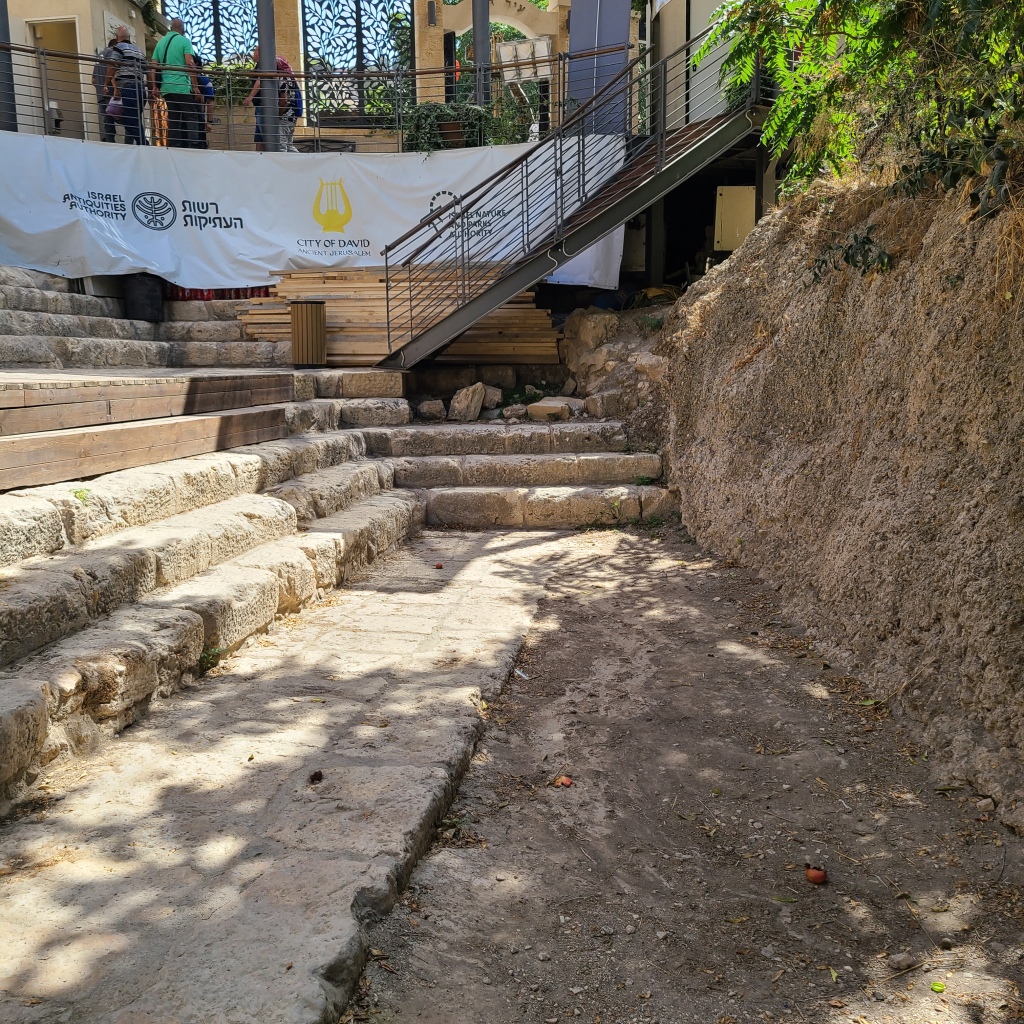
Although it may not be possible to say with 100% certainty in which pool the blind man washed, I could now say I went to *both* the two best candidates for where the healing happened–I’m covered! lol
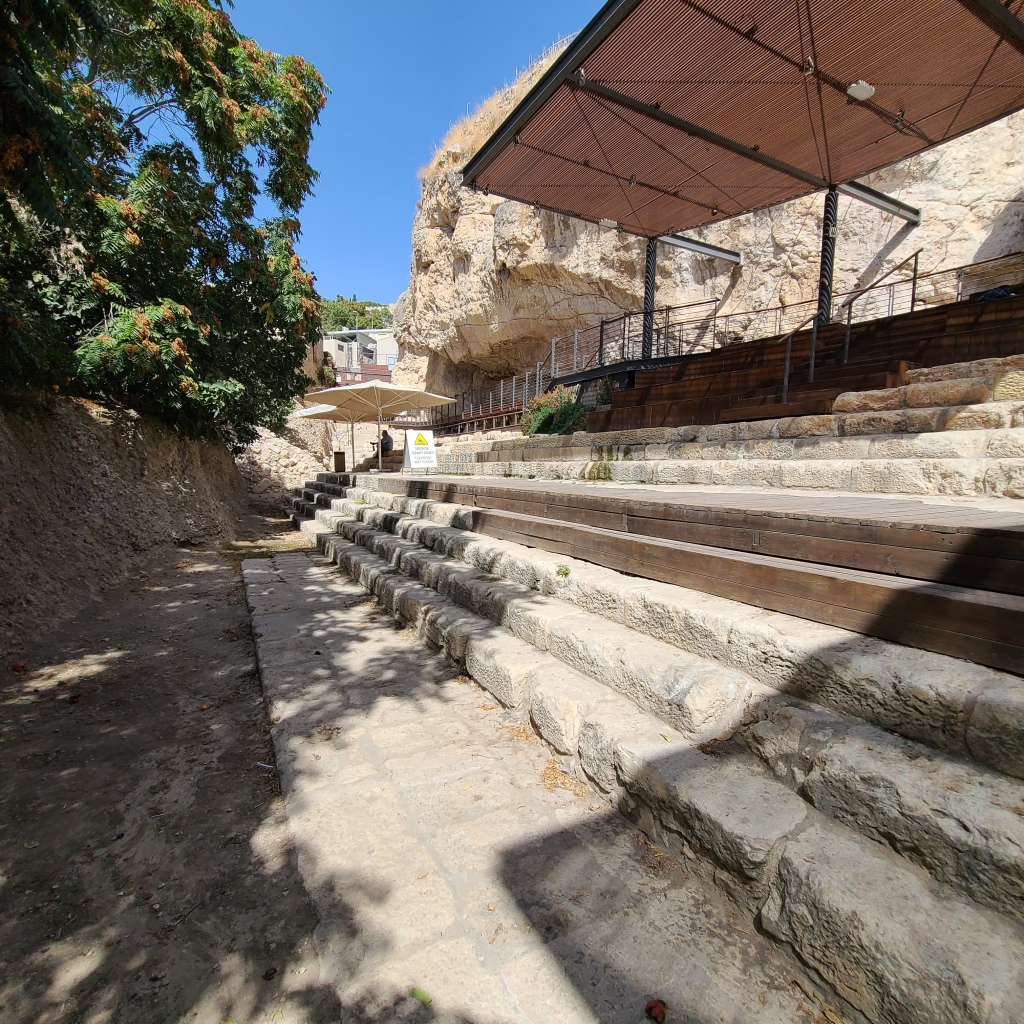
Before I left the area, I had a conversation with a man who was an employee working there. He told me he had been one of the excavators of the southern pool. I could tell he was very proud of being a part of this amazing discovery. I asked him a few questions about the excavation and he mentioned he found many ancient coins during the excavation that dated back 2,000 years. He pulled out a bag of coins and showed me some of his selection–it was incredible. One of the coins he mentioned he had was the “Widow’s Mite”–the type of small copper coin donated by the widow seen by Jesus in the treasury of the Temple (See Mark 12:41–44 & Luke 21:1–4). I asked to see one and he pulled one out for me to see.
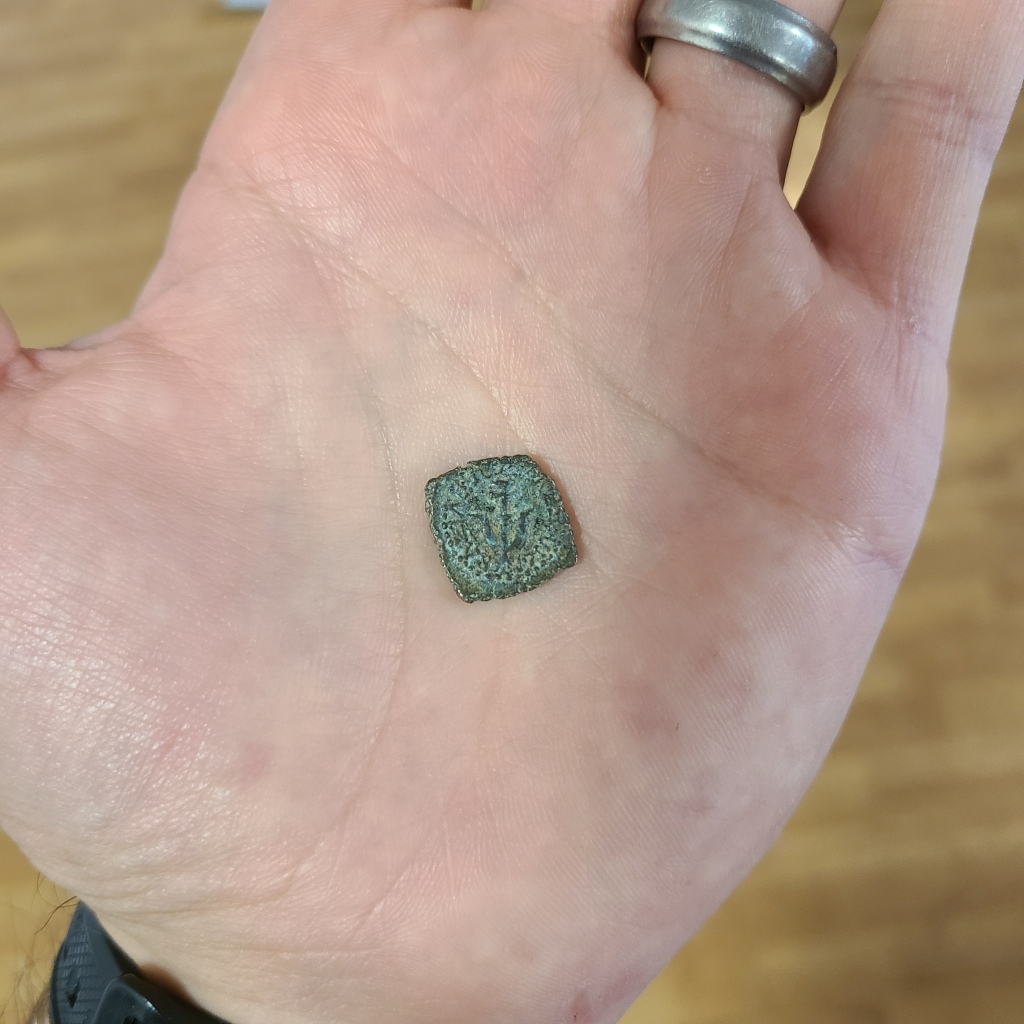
In the past, I had looked up what a widow’s mite coin actually looked like, but it had been awhile. I looked at this coin, however, and it had the same markings I remembered seeing before! I later went back on Wikipedia to check and, sure enough! (see screenshot below) I had held one of the same coins as the widow lovingly and selflessly donated. It was slightly smaller than a dime and you could tell it was imprecisely-made, unlike coins in the present day. Seeing one of these amazing (!), but rough and inconspicuous coins for myself made Jesus’s words in the Gospel come even more alive. Even though others at the treasury were probably donating many more coins of finer metal and finer look, the widow’s donation of two small, poorly made coins ended up being the most beautiful contribution in the Lord’s eyes.
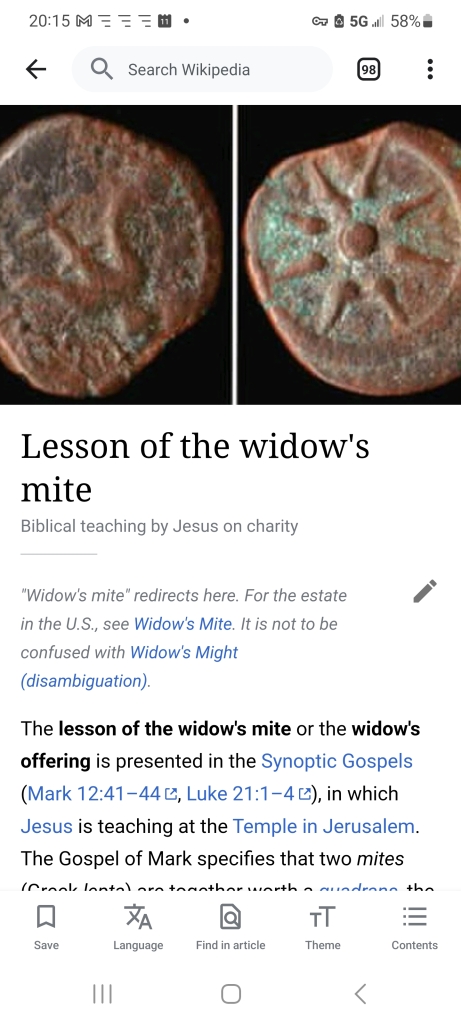
I want to thank all my dear readers for making it to the end of this long post. With this being said, this post actually only covers the first half of my day in Jerusalem!–There is so much to see in such a small area!
Mark Twain, again, says it best–humorously but truthfully– in Chapter 54 of The Innocents Abroad, his classic account of his own Holy Land pilgrimage in 1867. He says of Jerusalem:
“The sights are too many. They swarm about you at every step; no single foot of ground in all Jerusalem or within its neighborhood seems to be without a stirring and important history of its own. It is a very relief to steal a walk of a hundred yards without a guide along to talk unceasingly about every stone you step upon and drag you back ages and ages to the day when it achieved celebrity.“
If you care for me to drag you, the reader, back ages and ages yet again–which I humbly hope you do!–I will complete my final post for this trip soon. Thank you again for reading and please stay tuned for more…
Also, if you enjoyed, this post, check out my one-of-a-kind book, The Second Person of the Trinity in Time and Space: What is Known Historically About Jesus and the Holy Sites of the New Testament, sold on Amazon.com! (click below)
